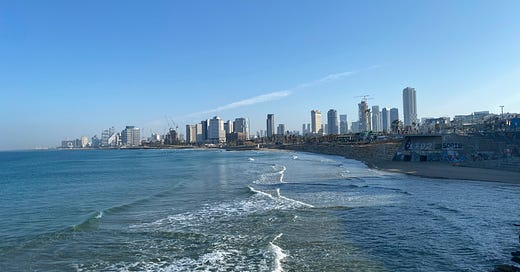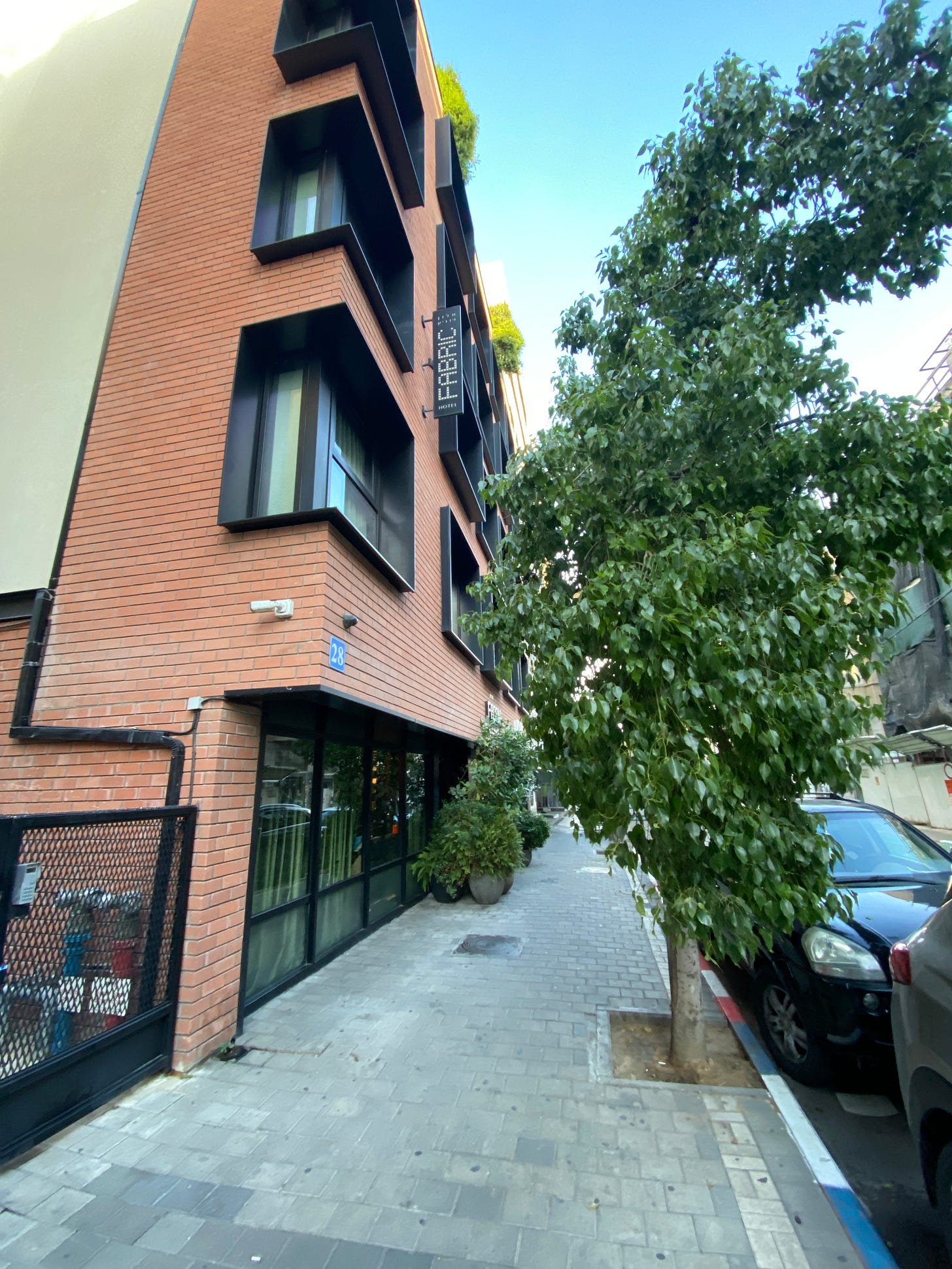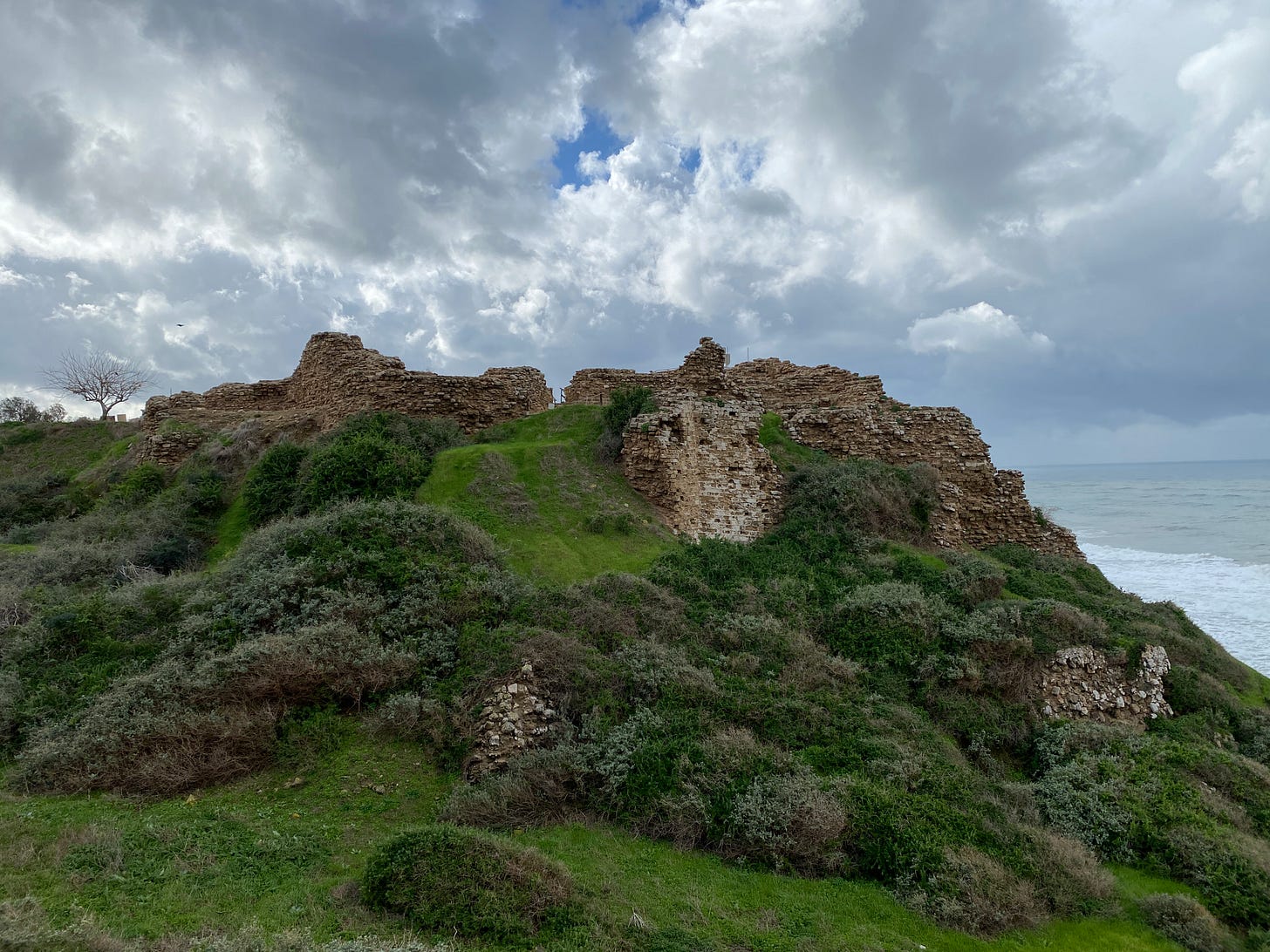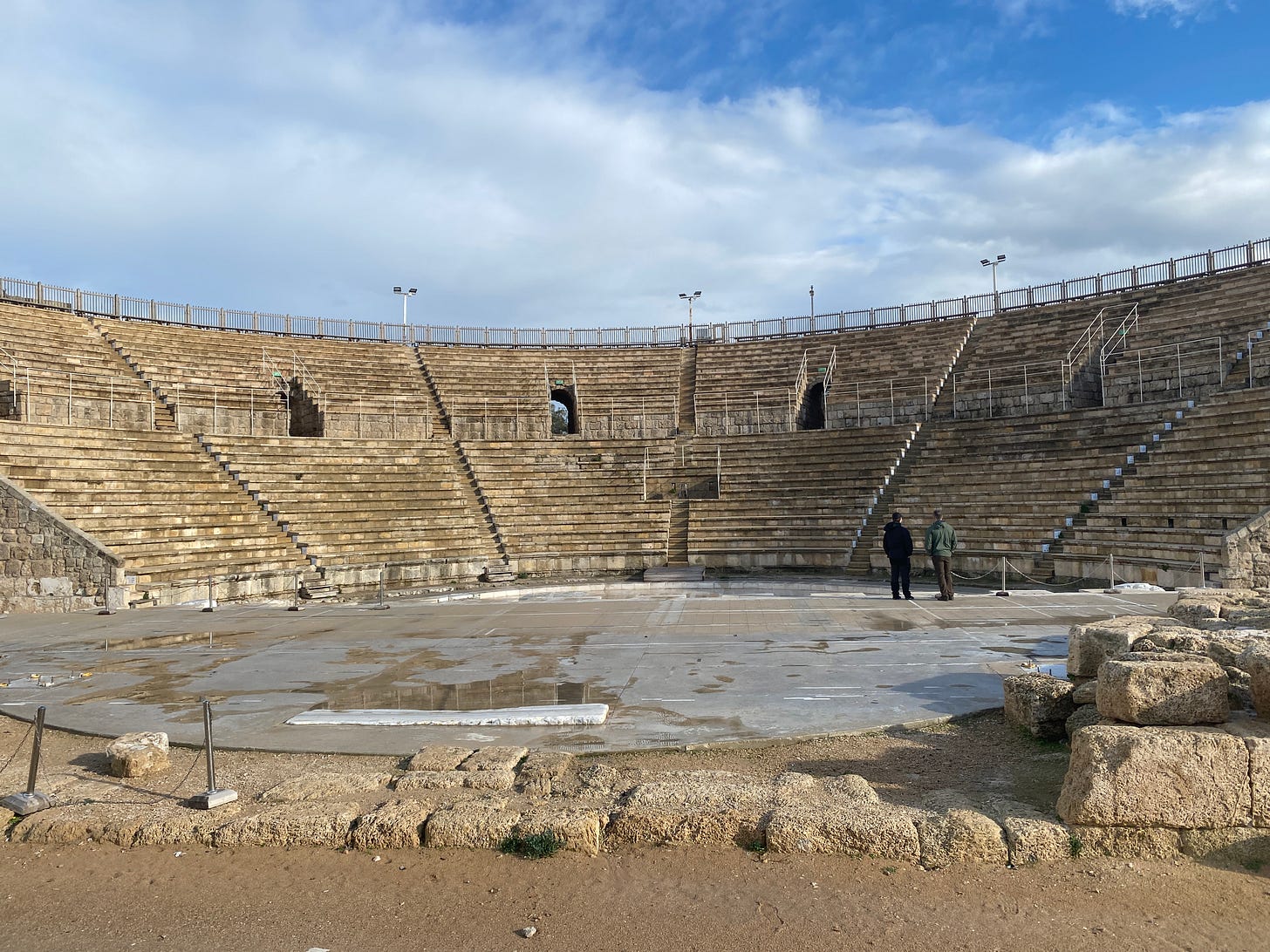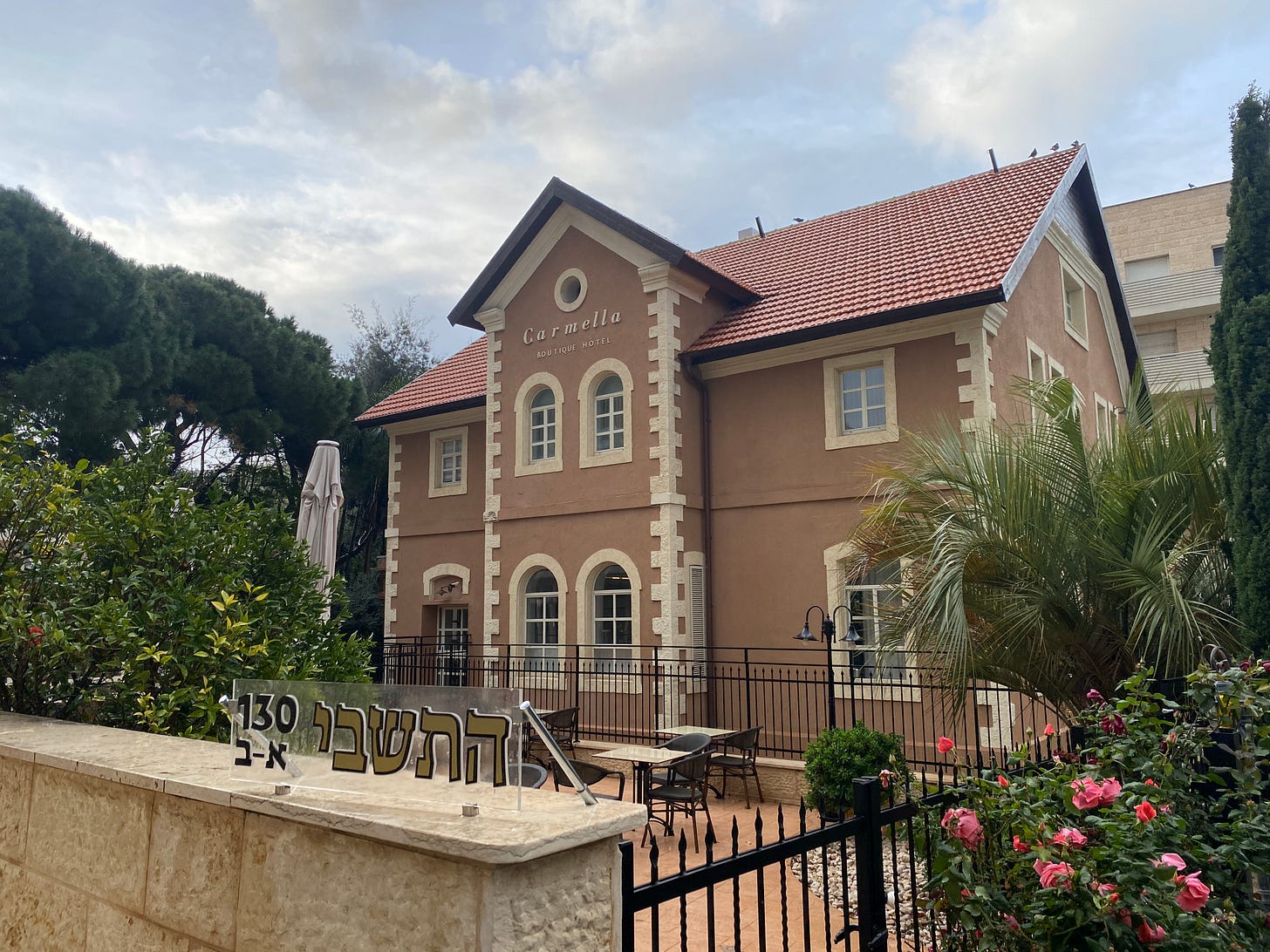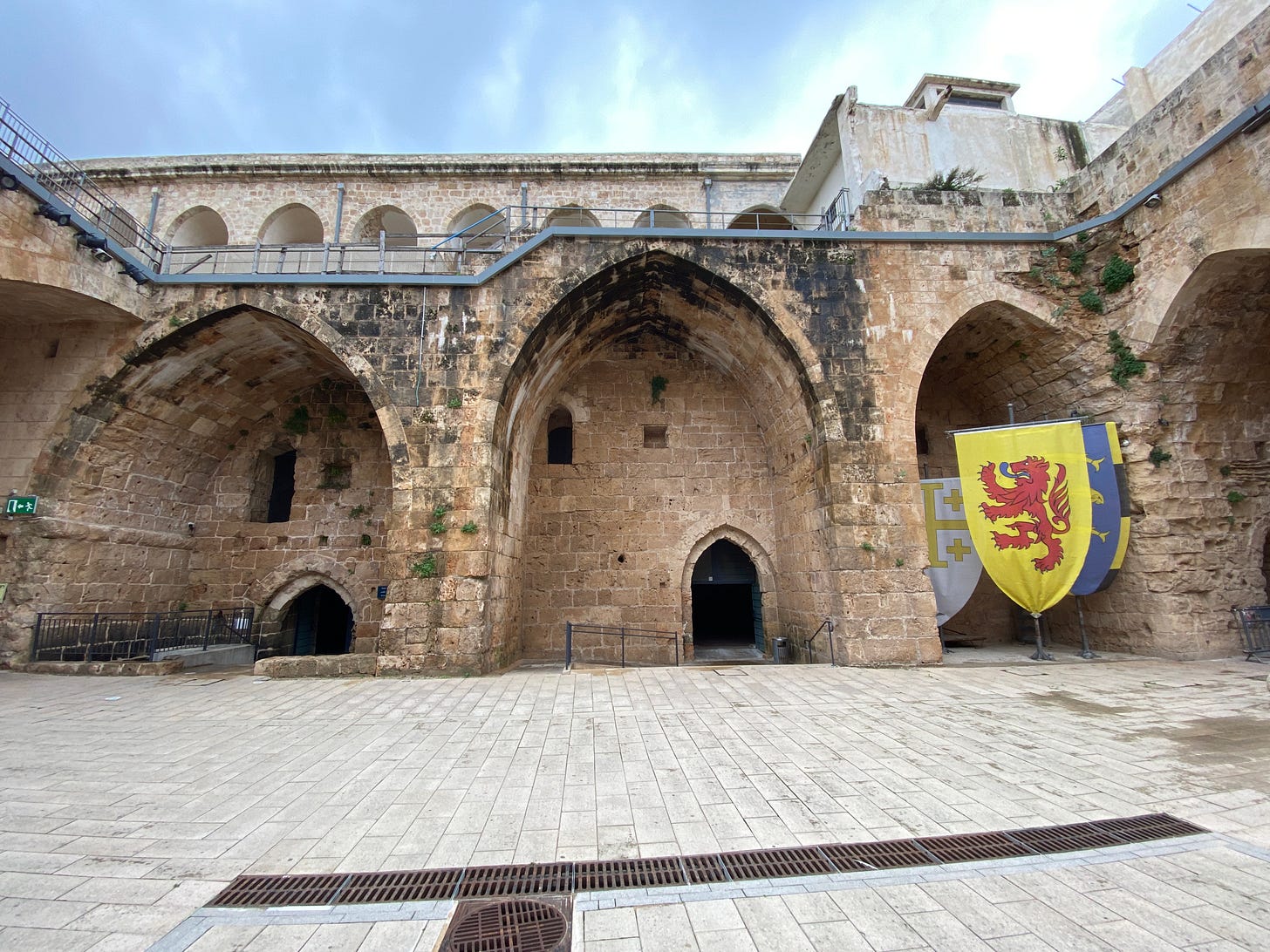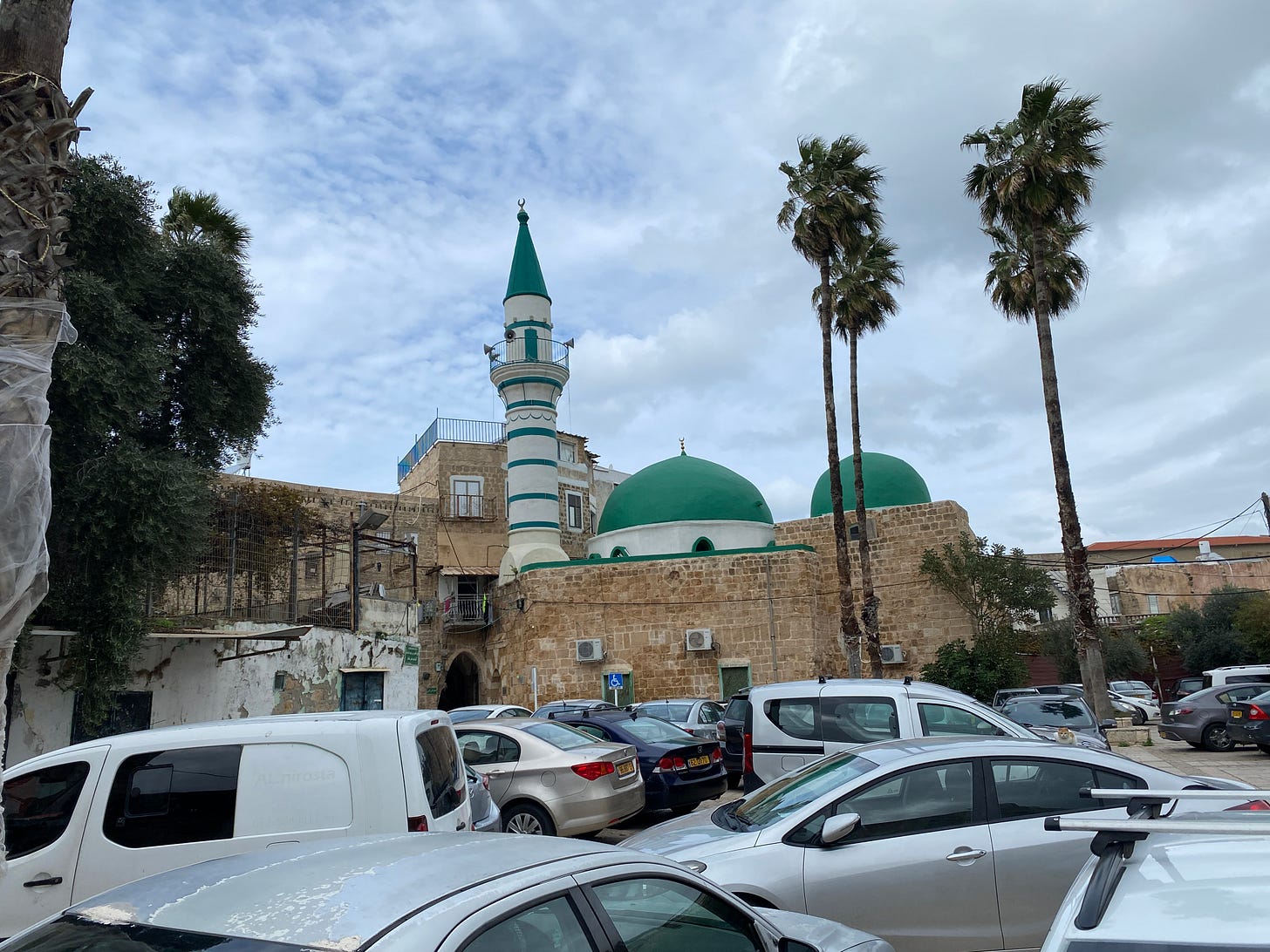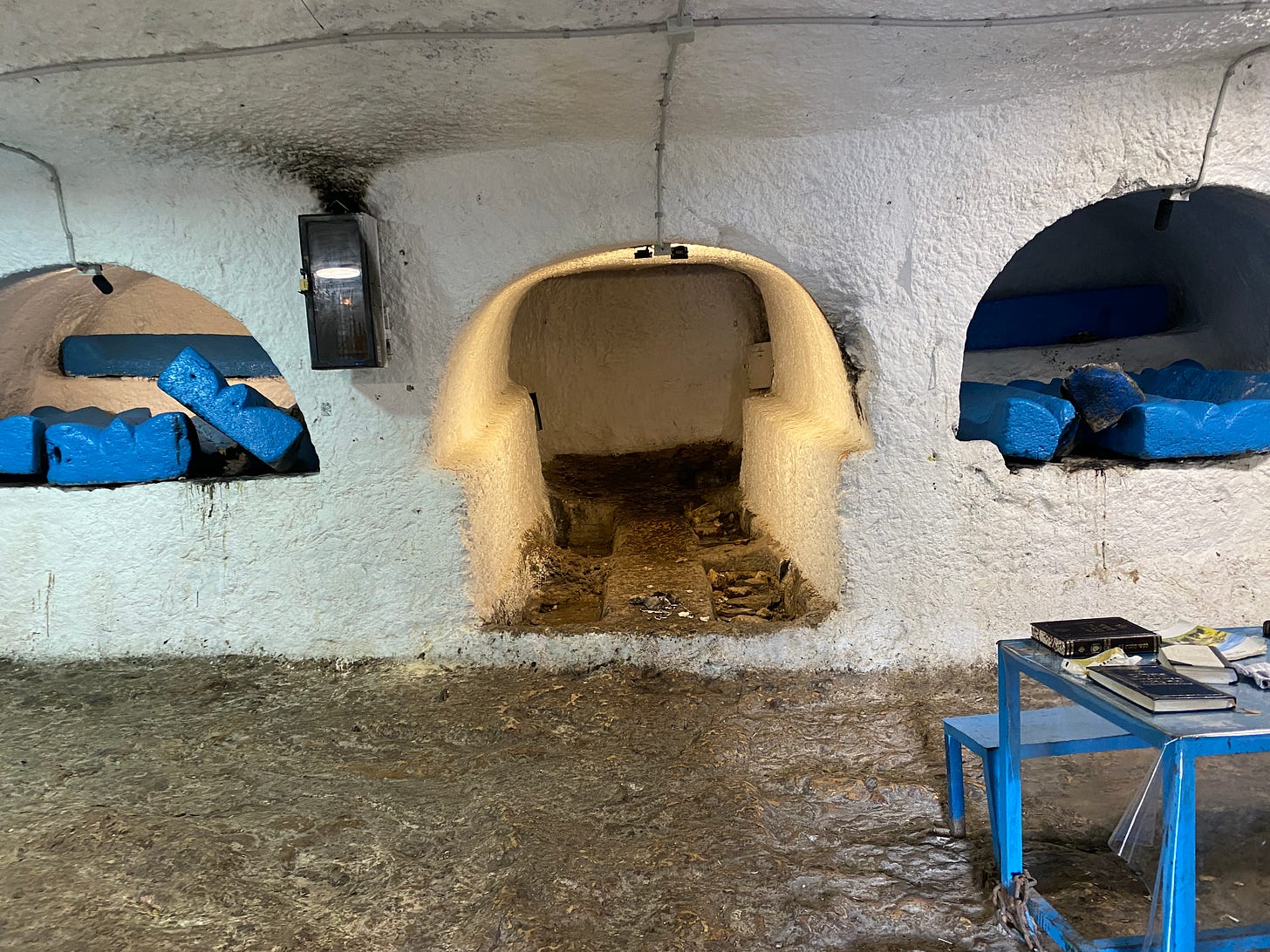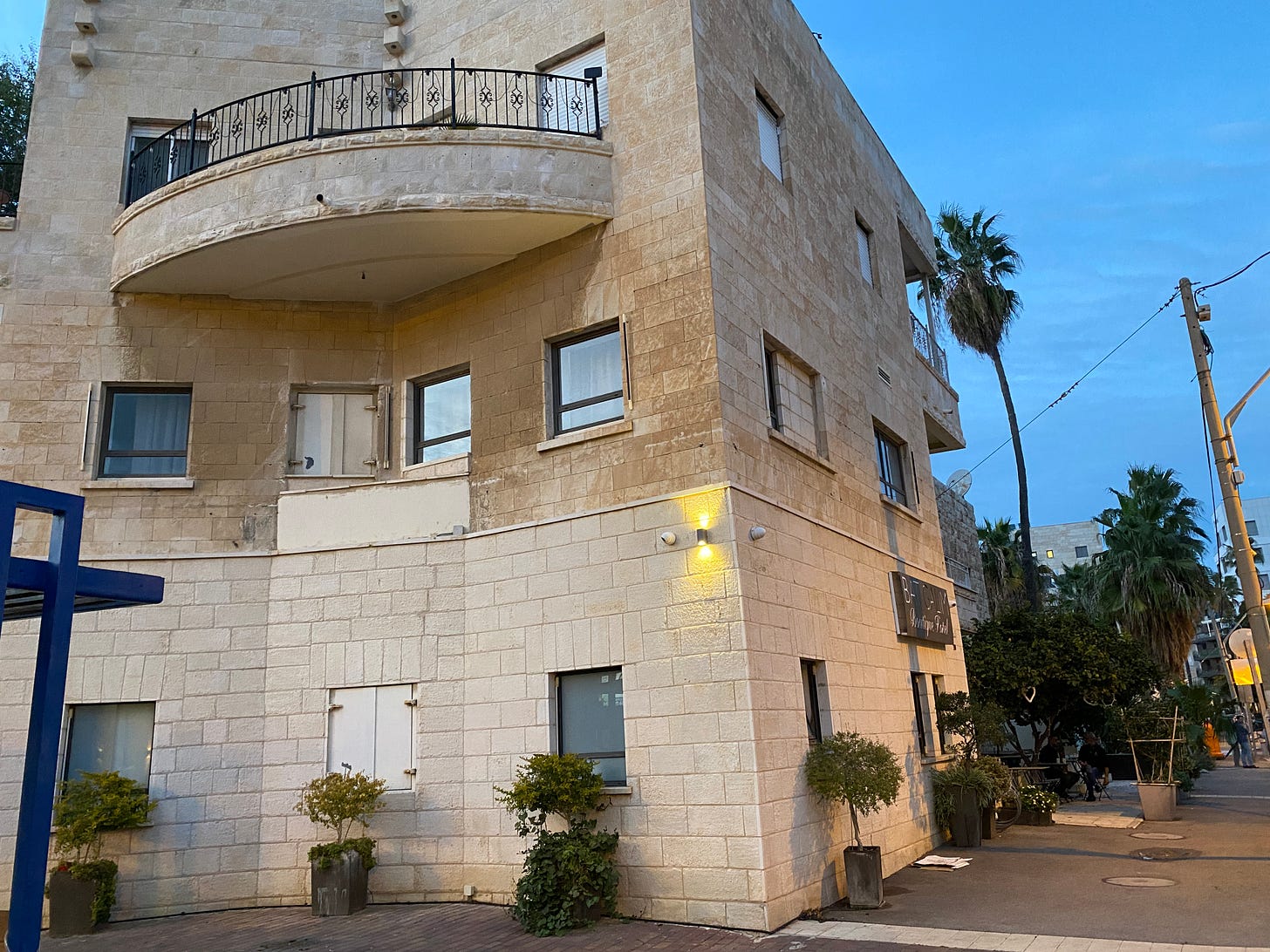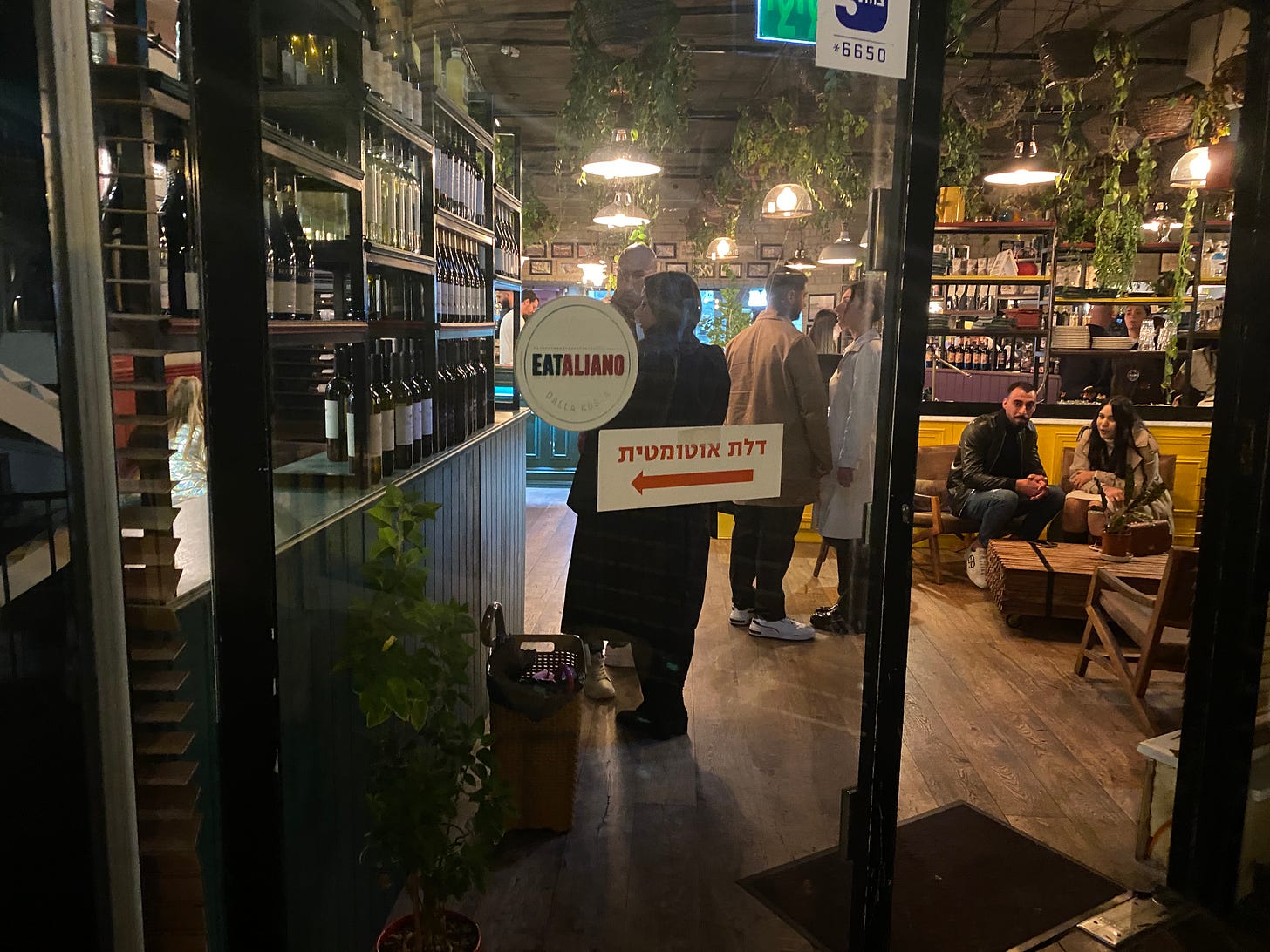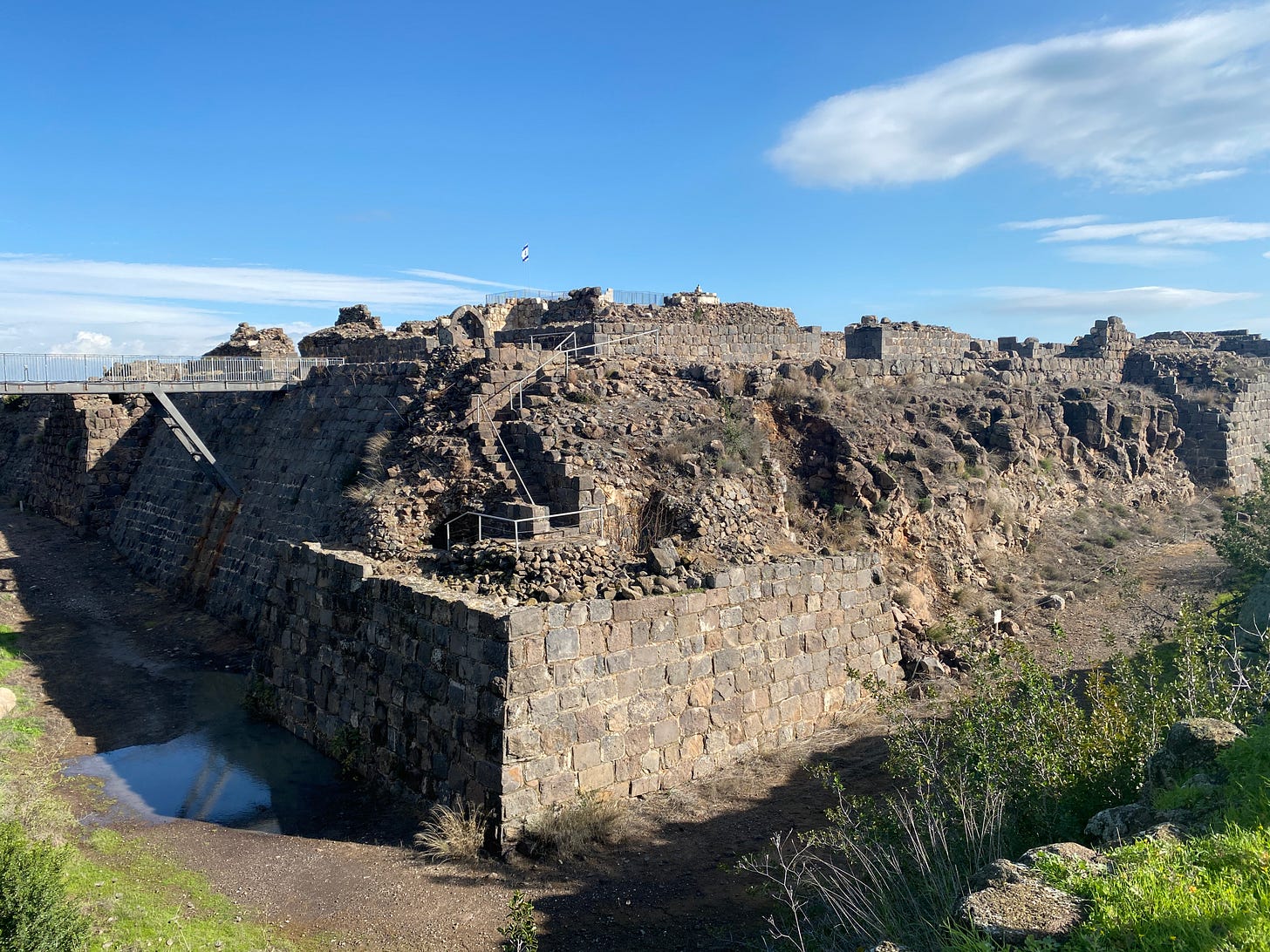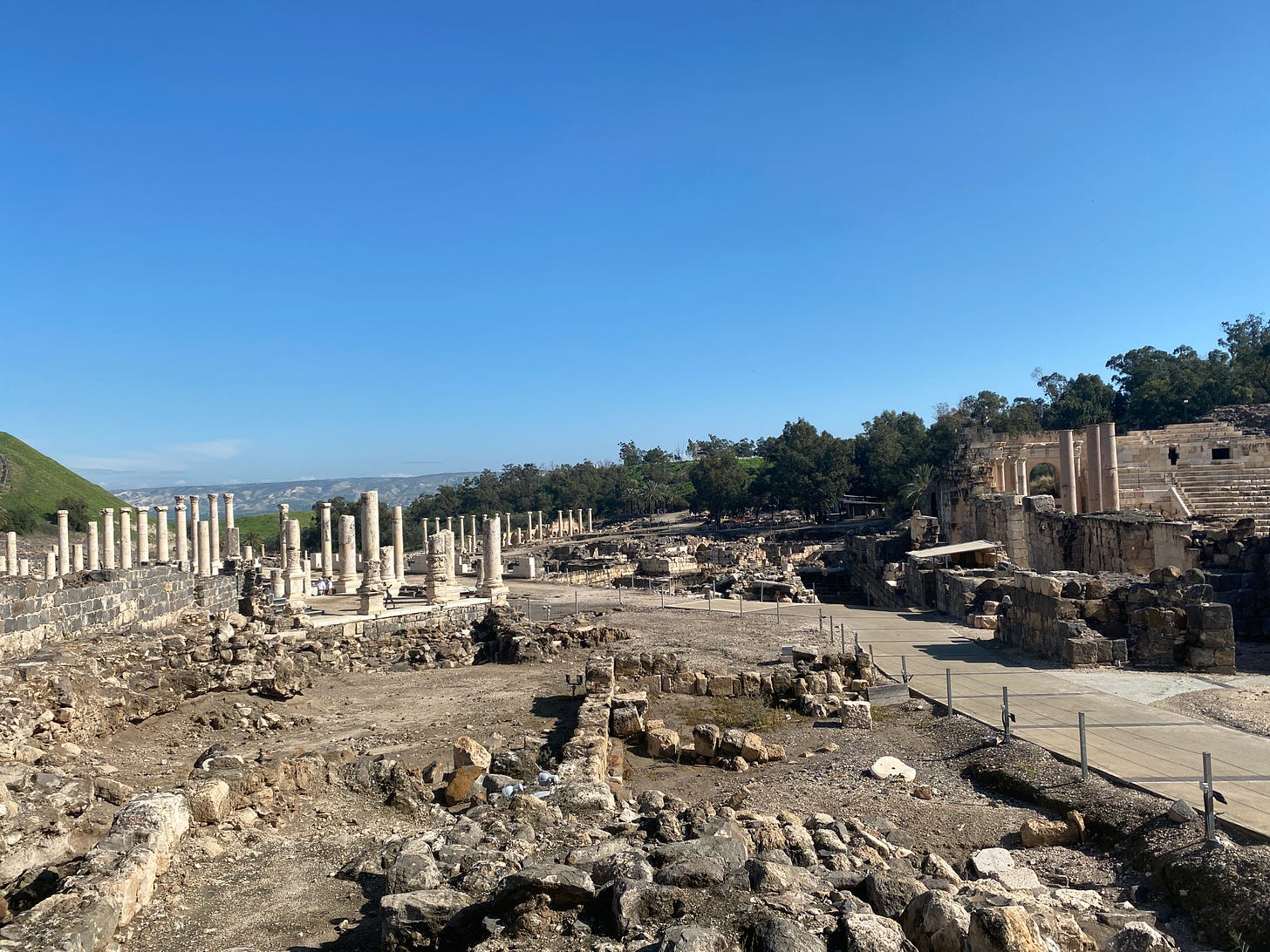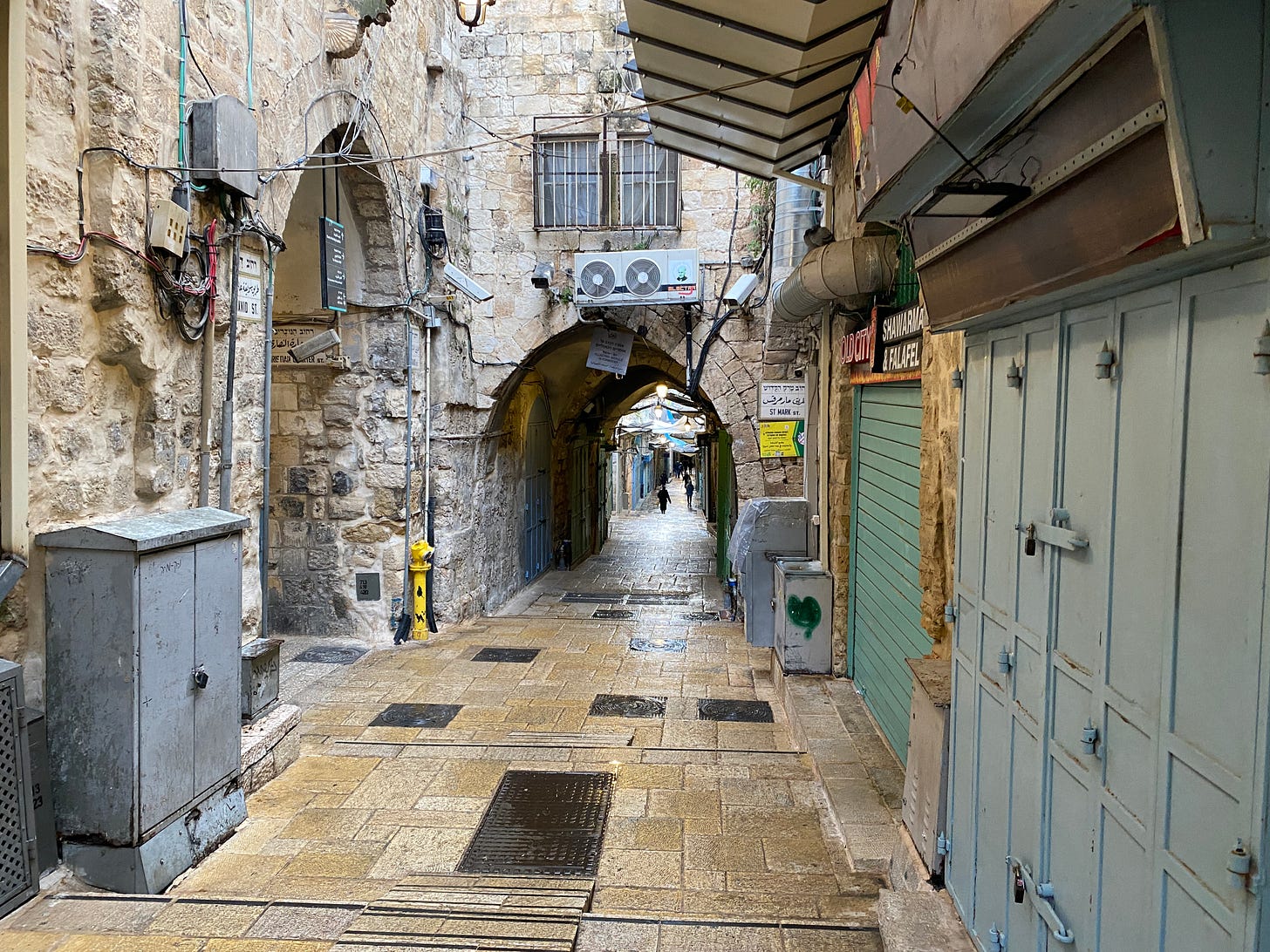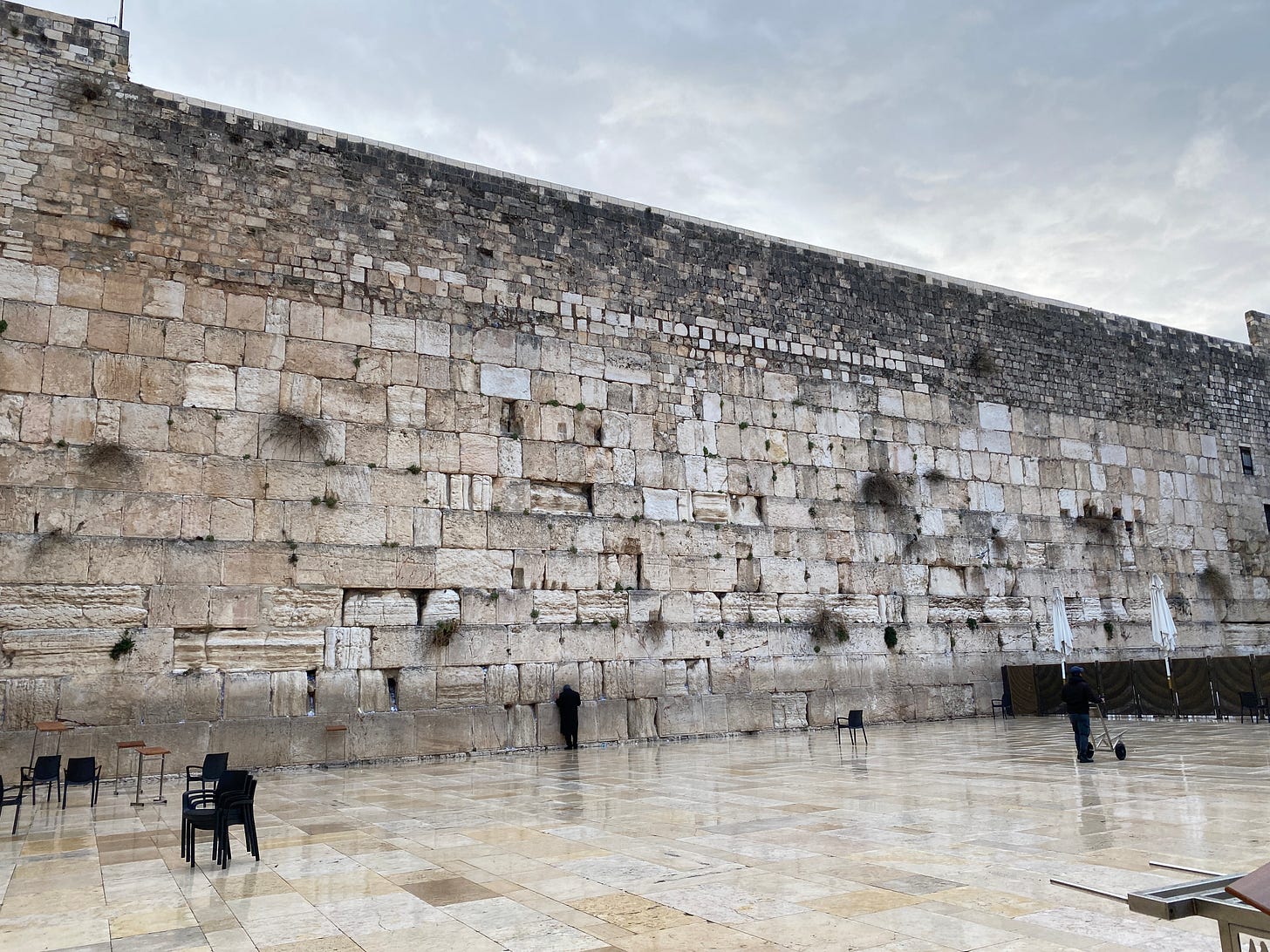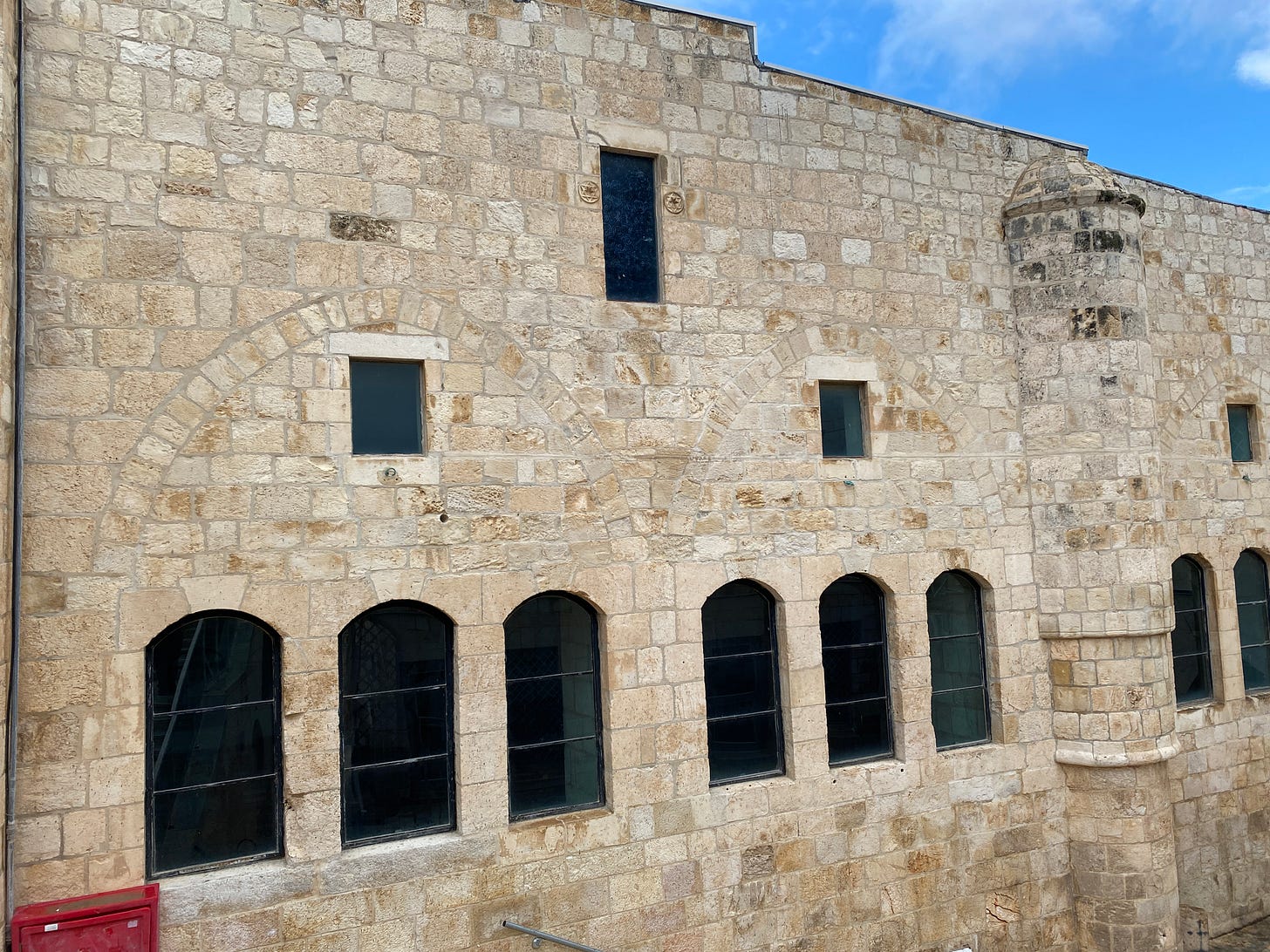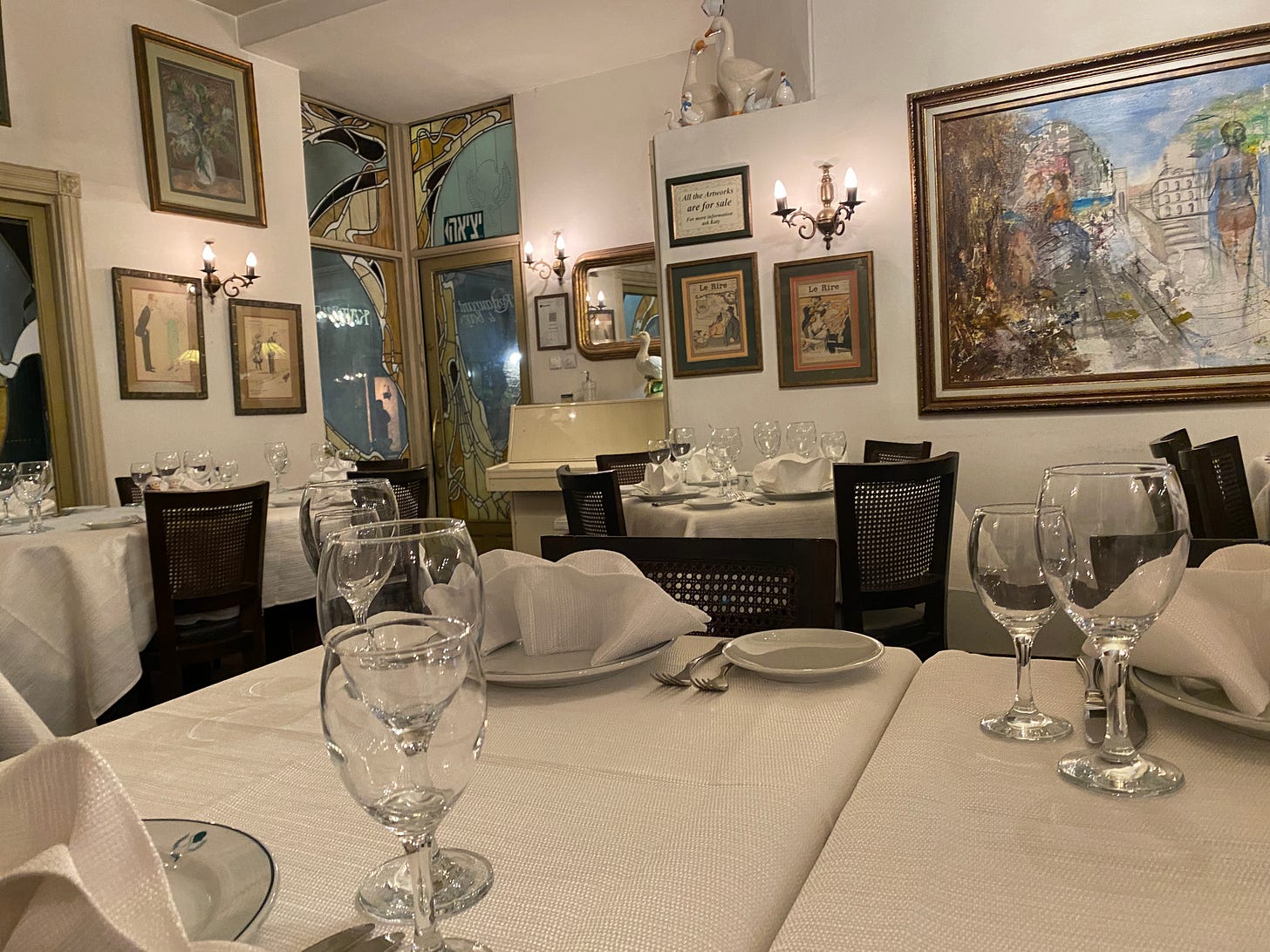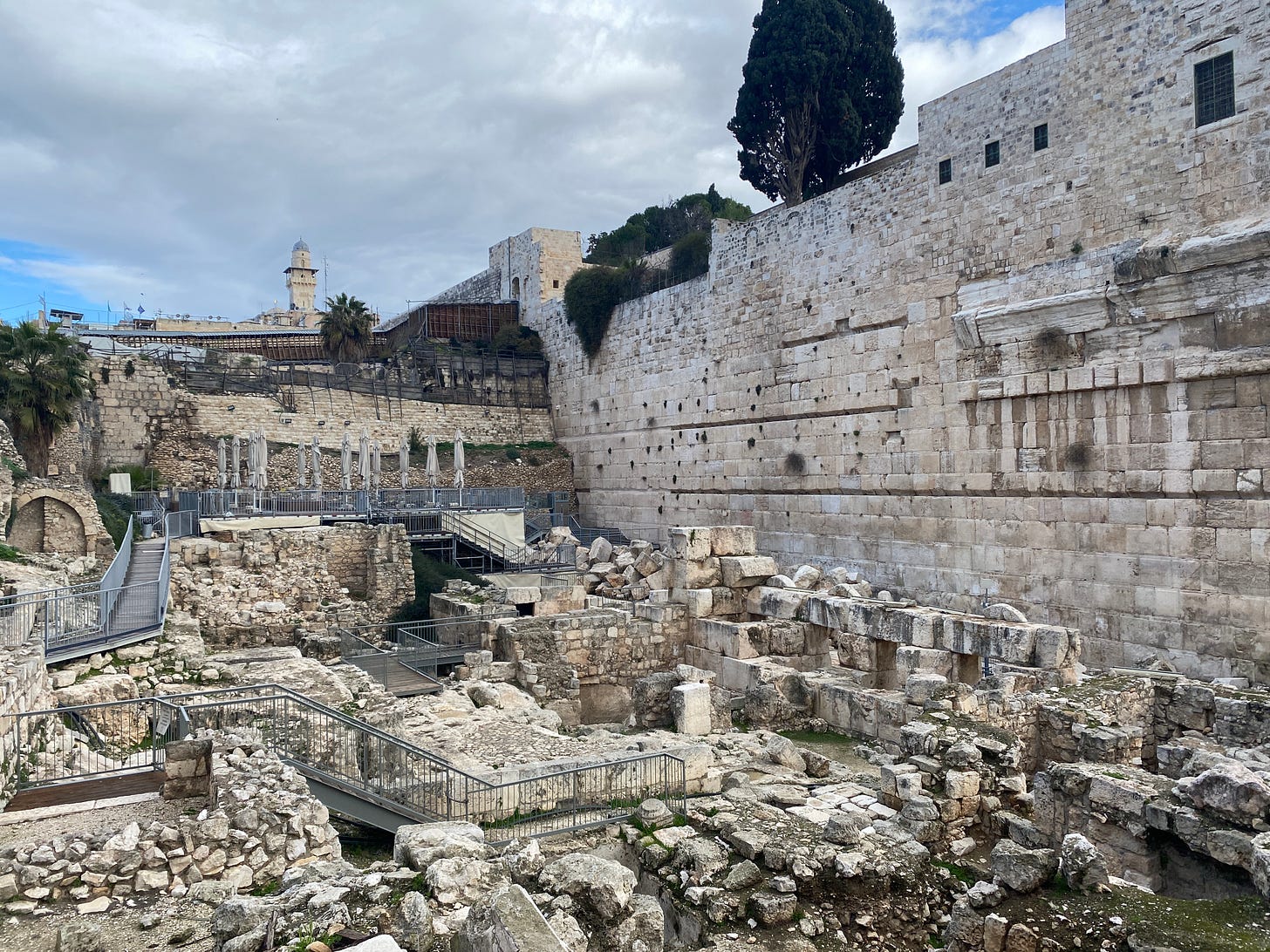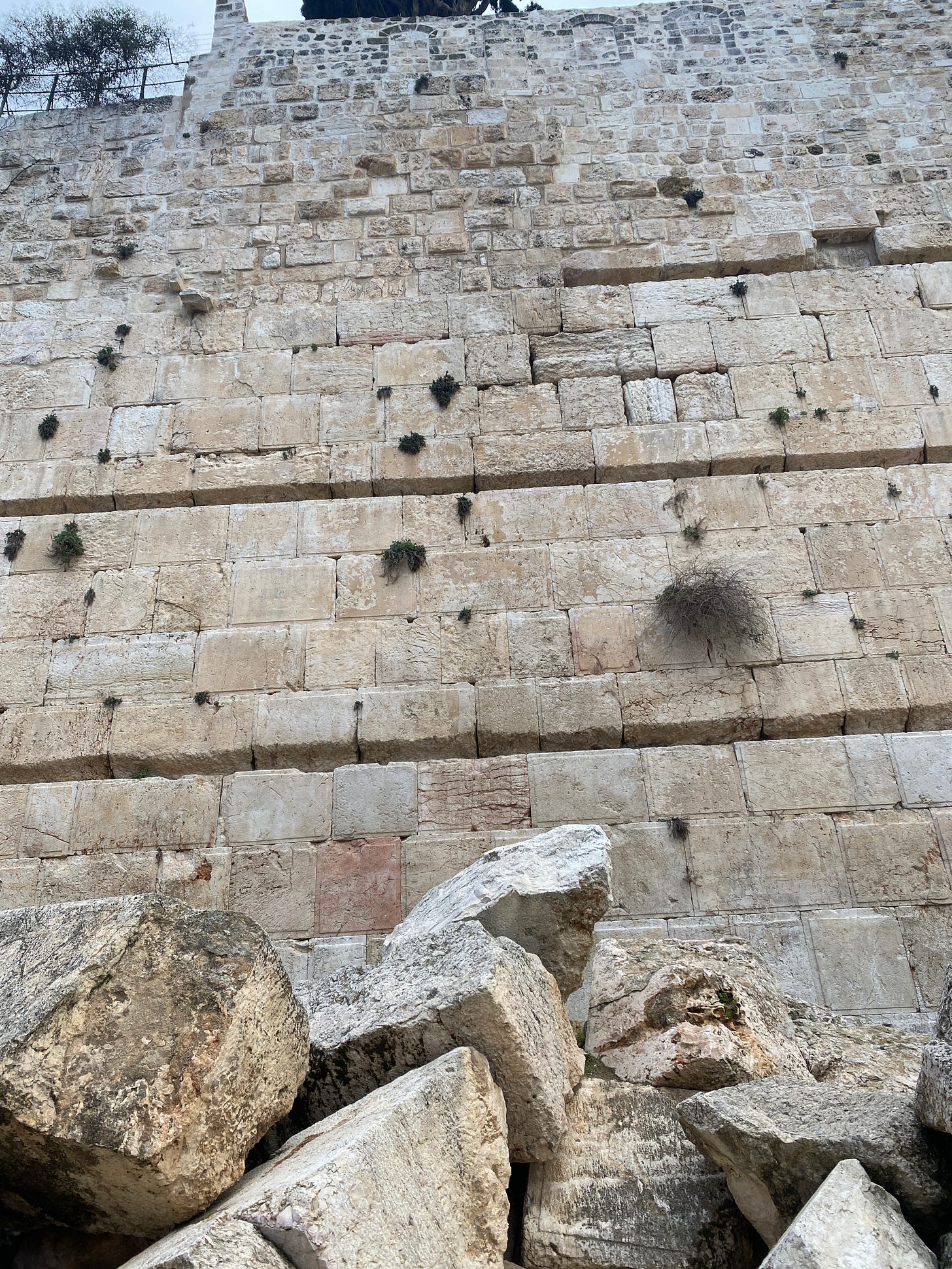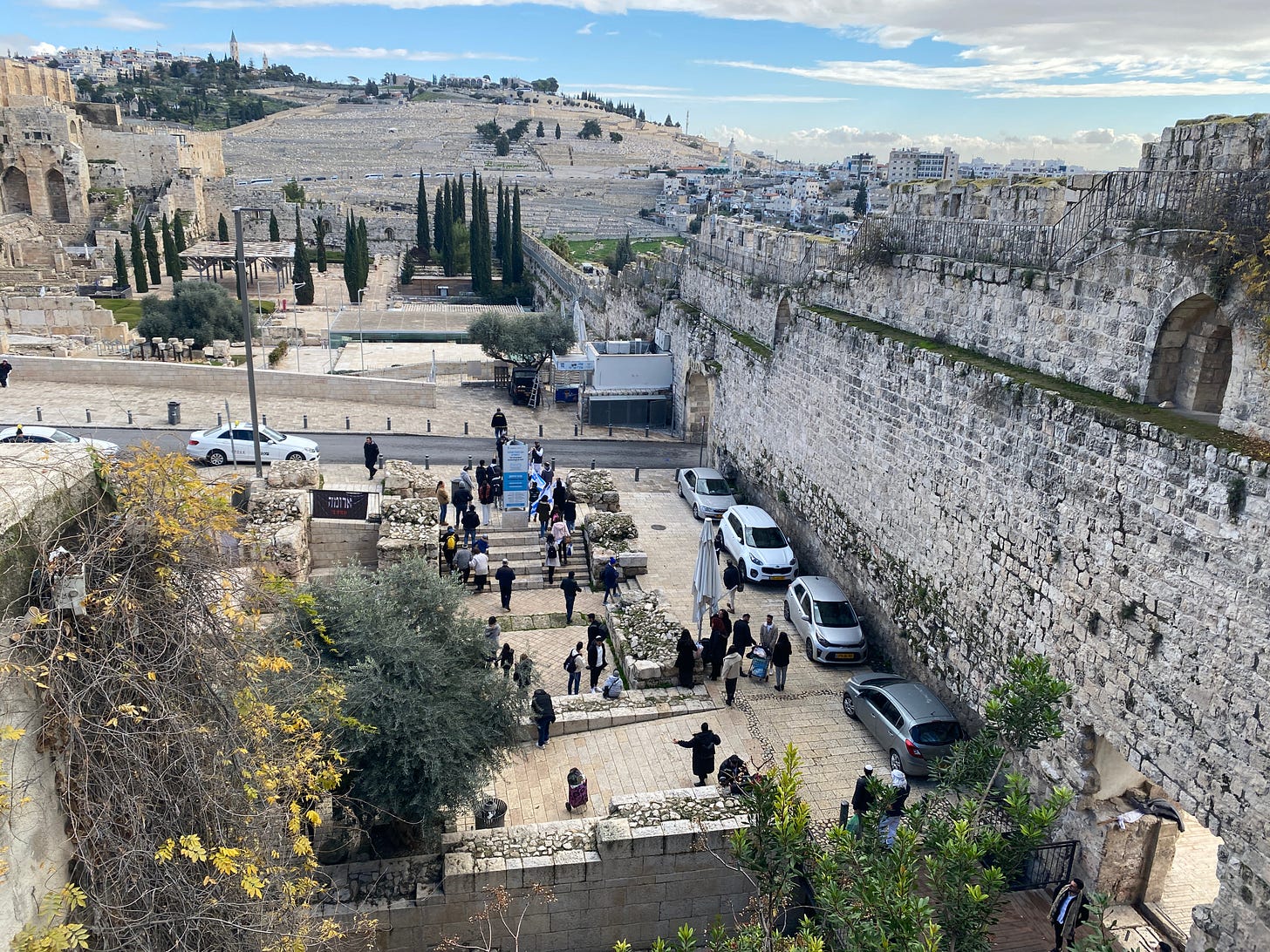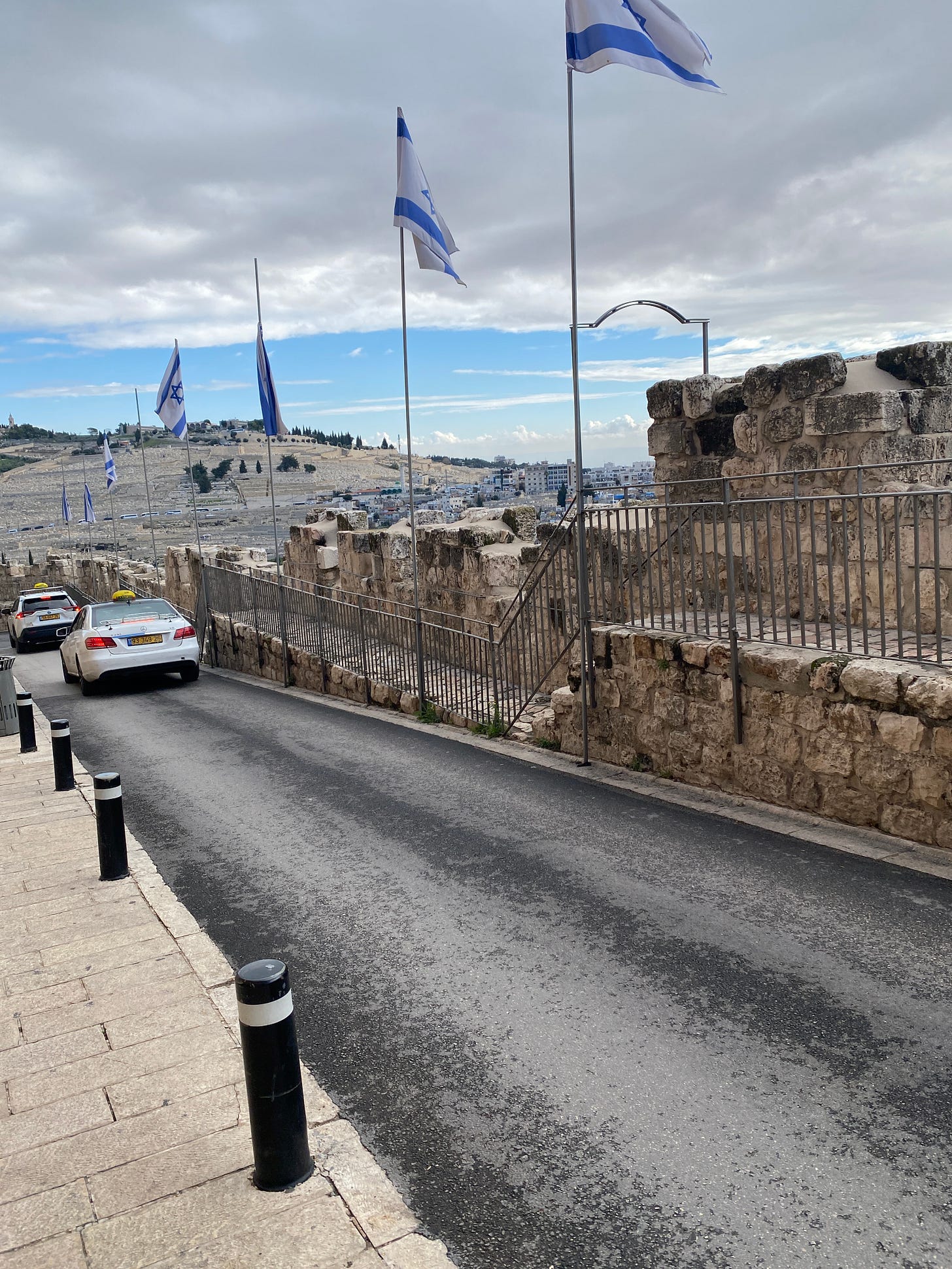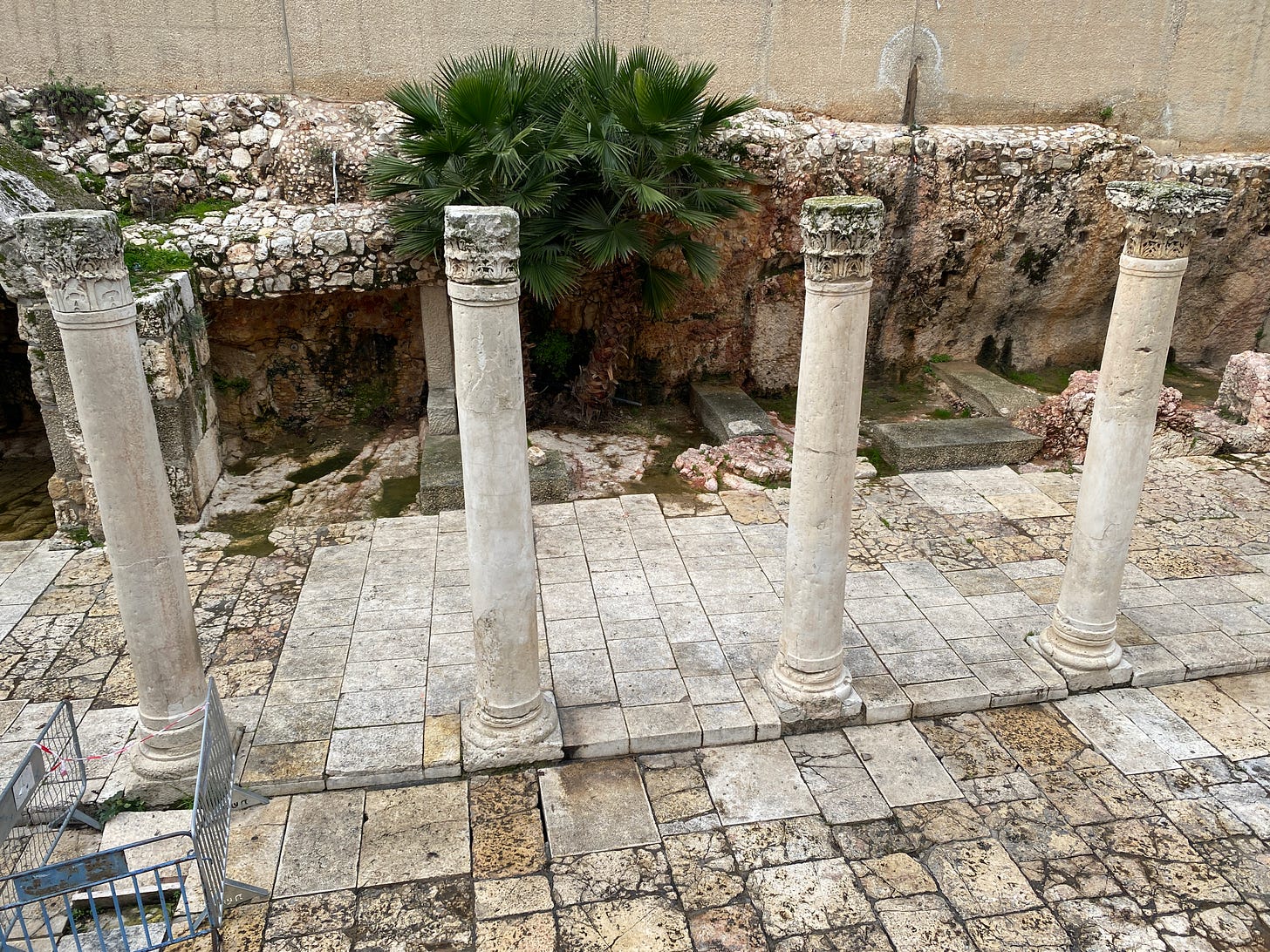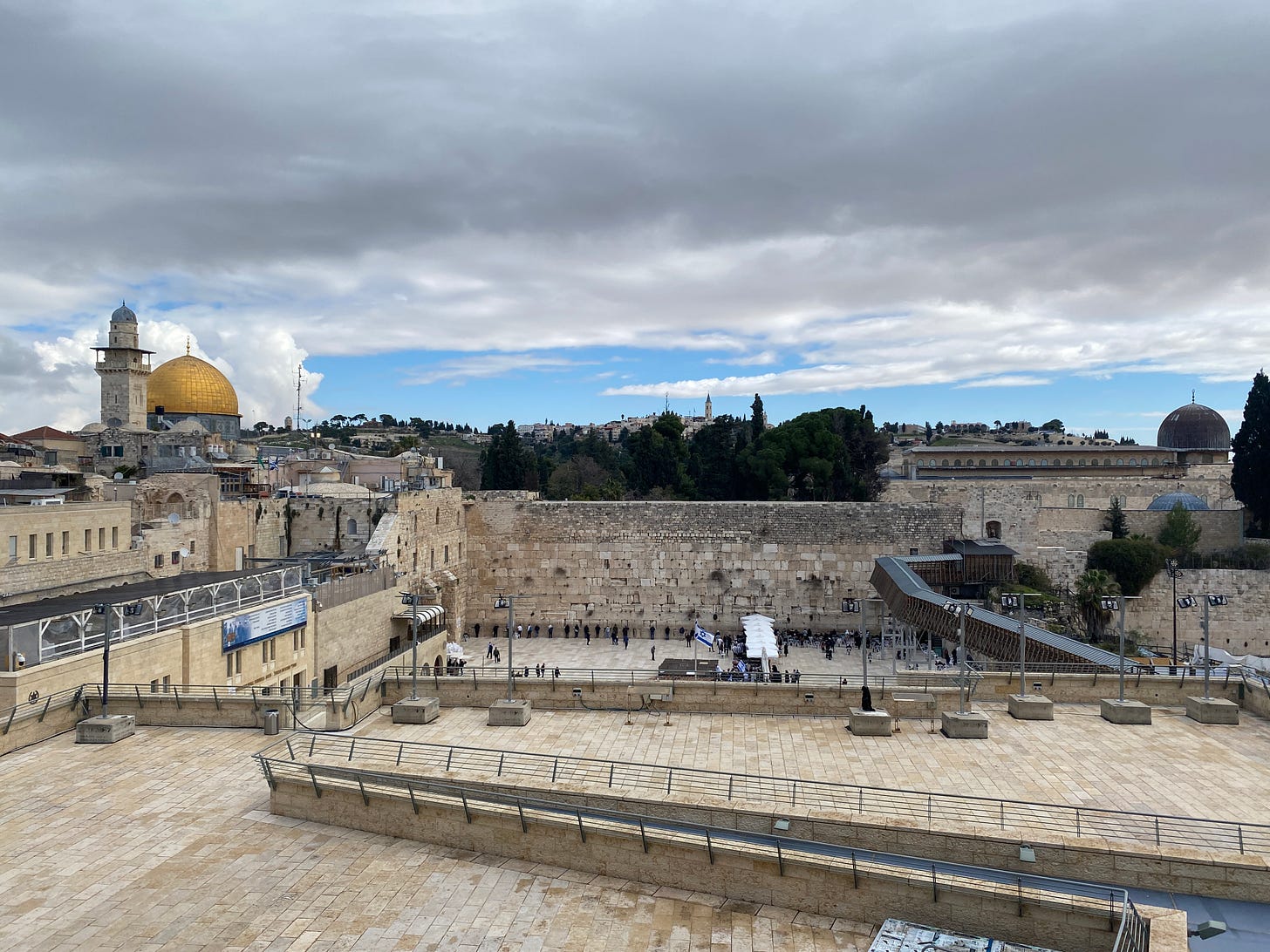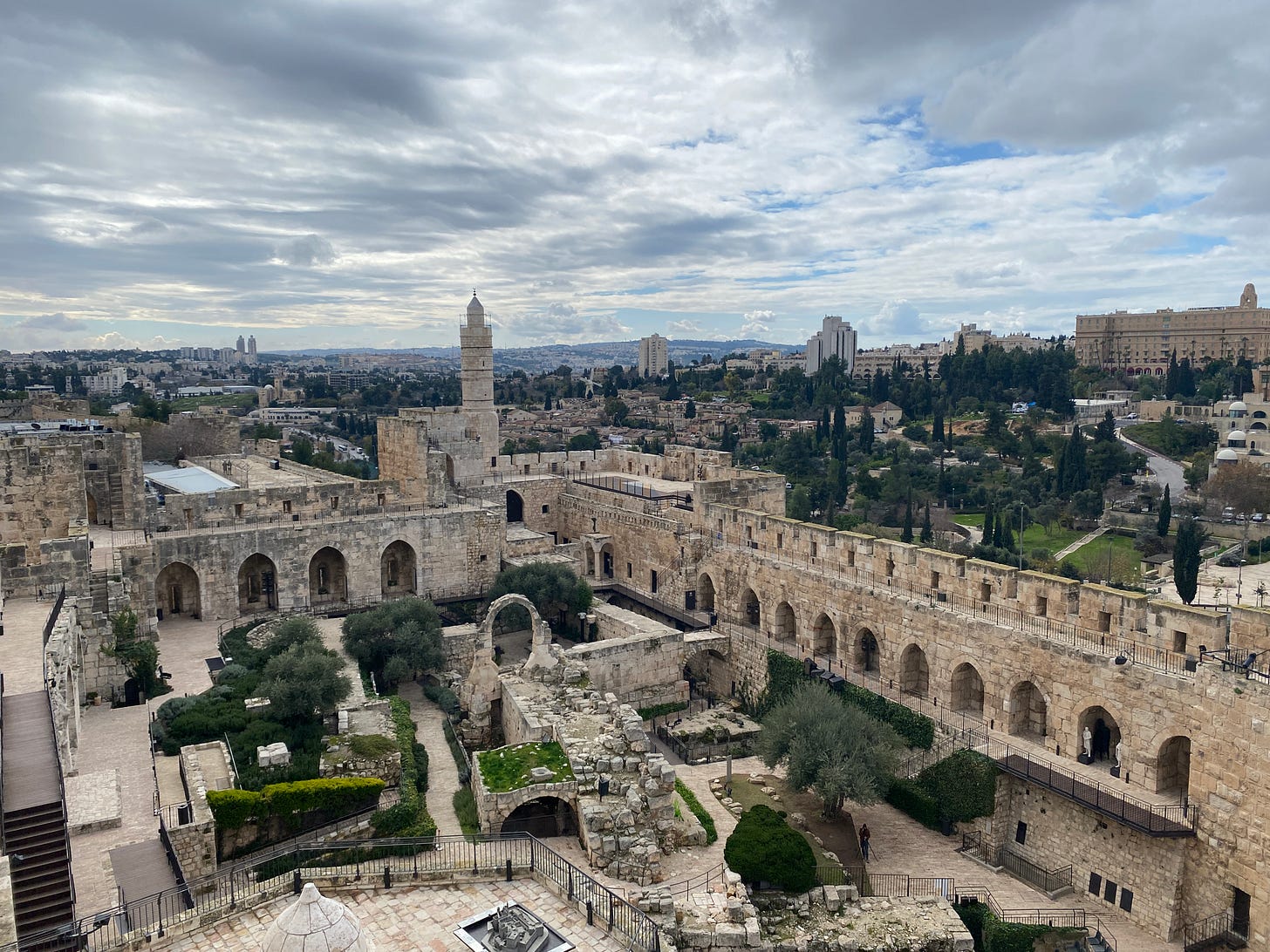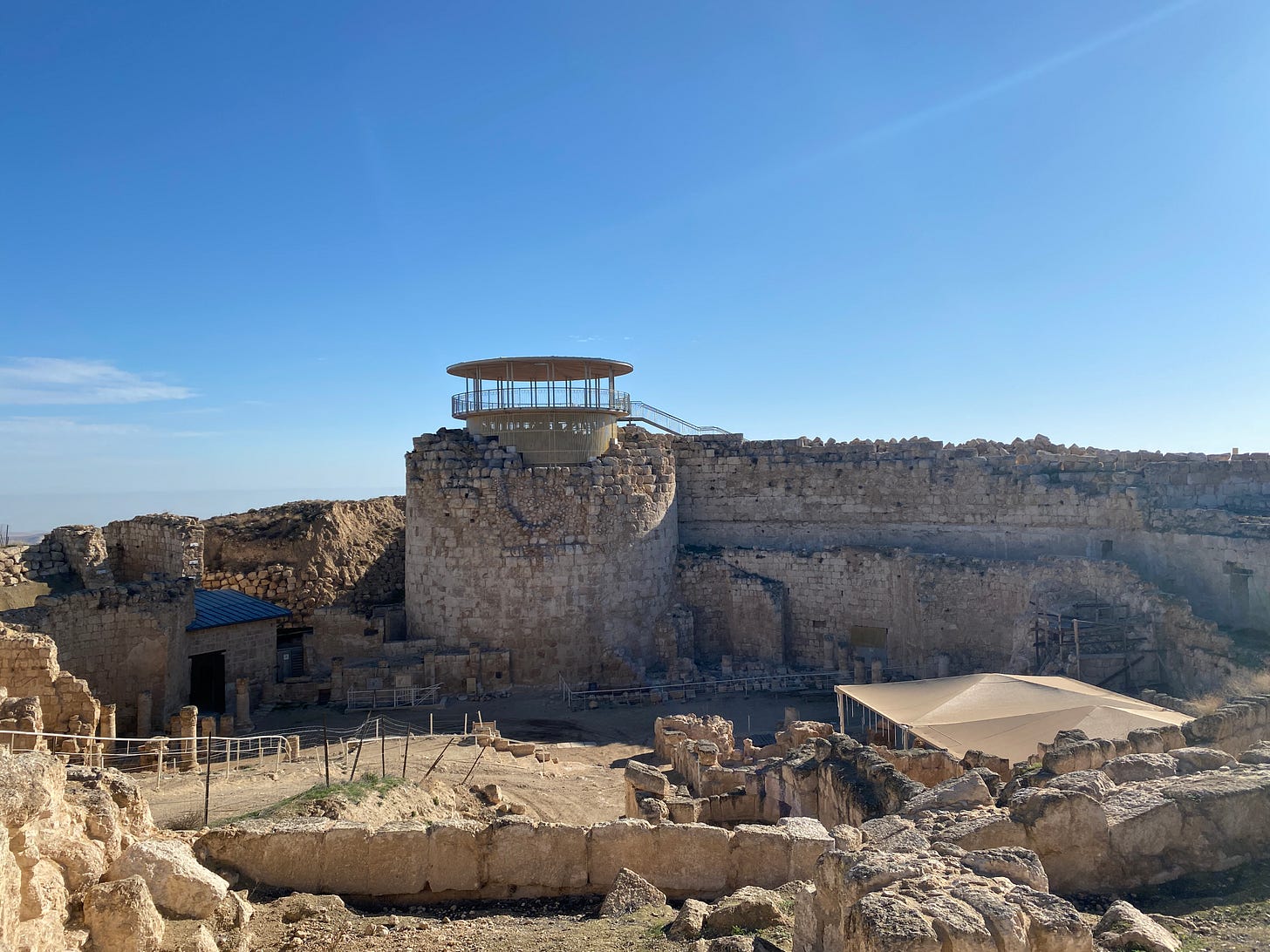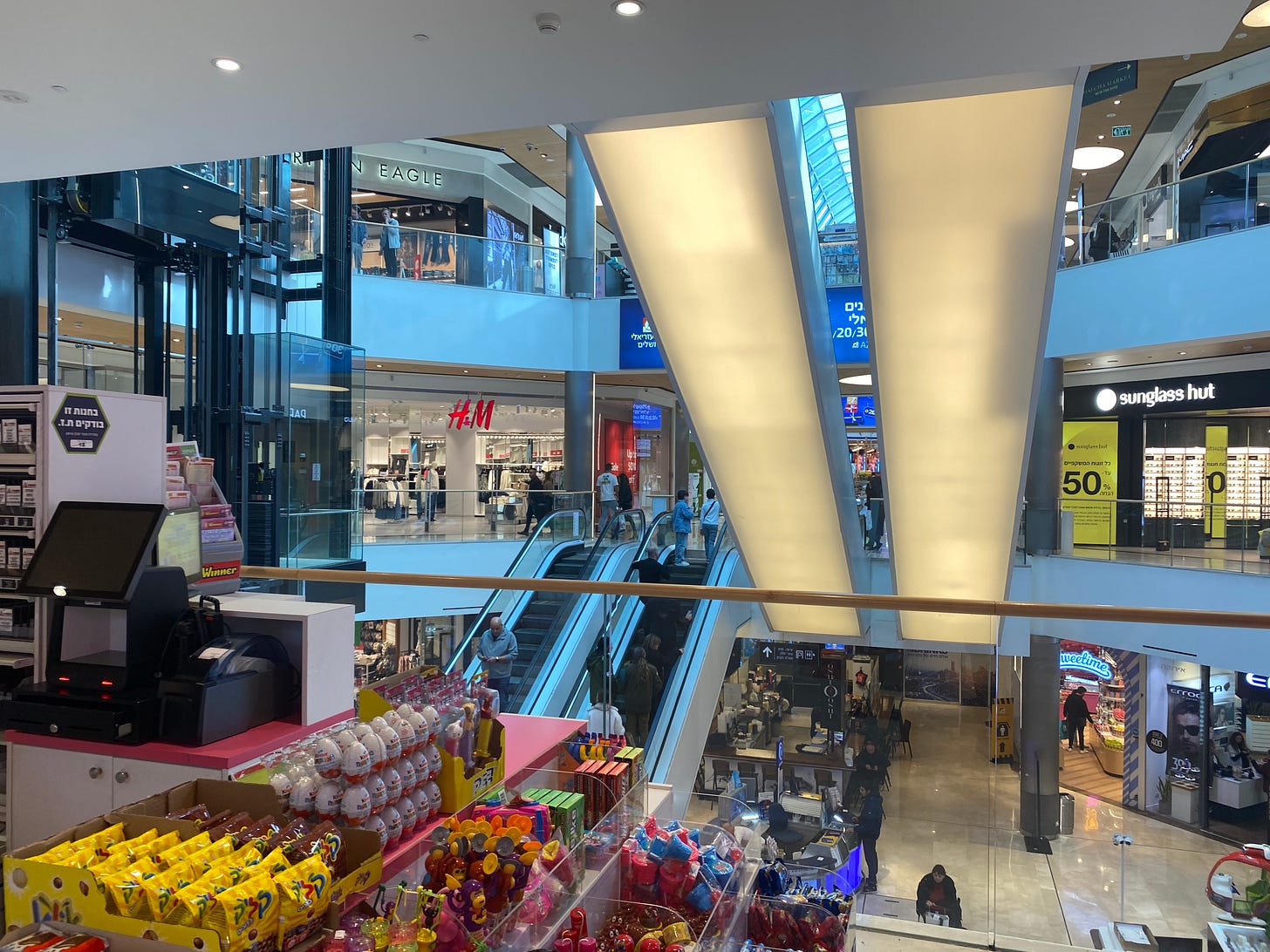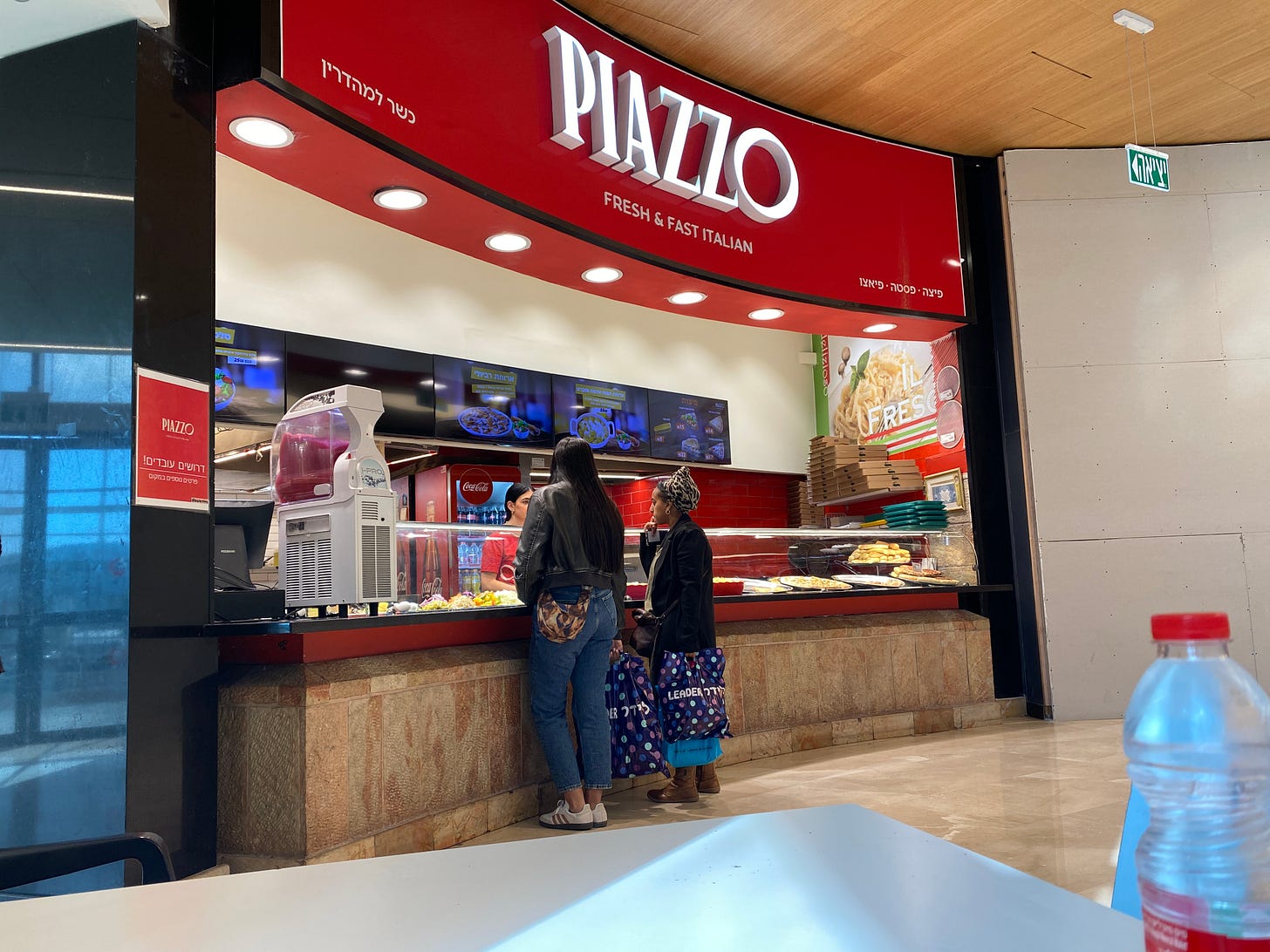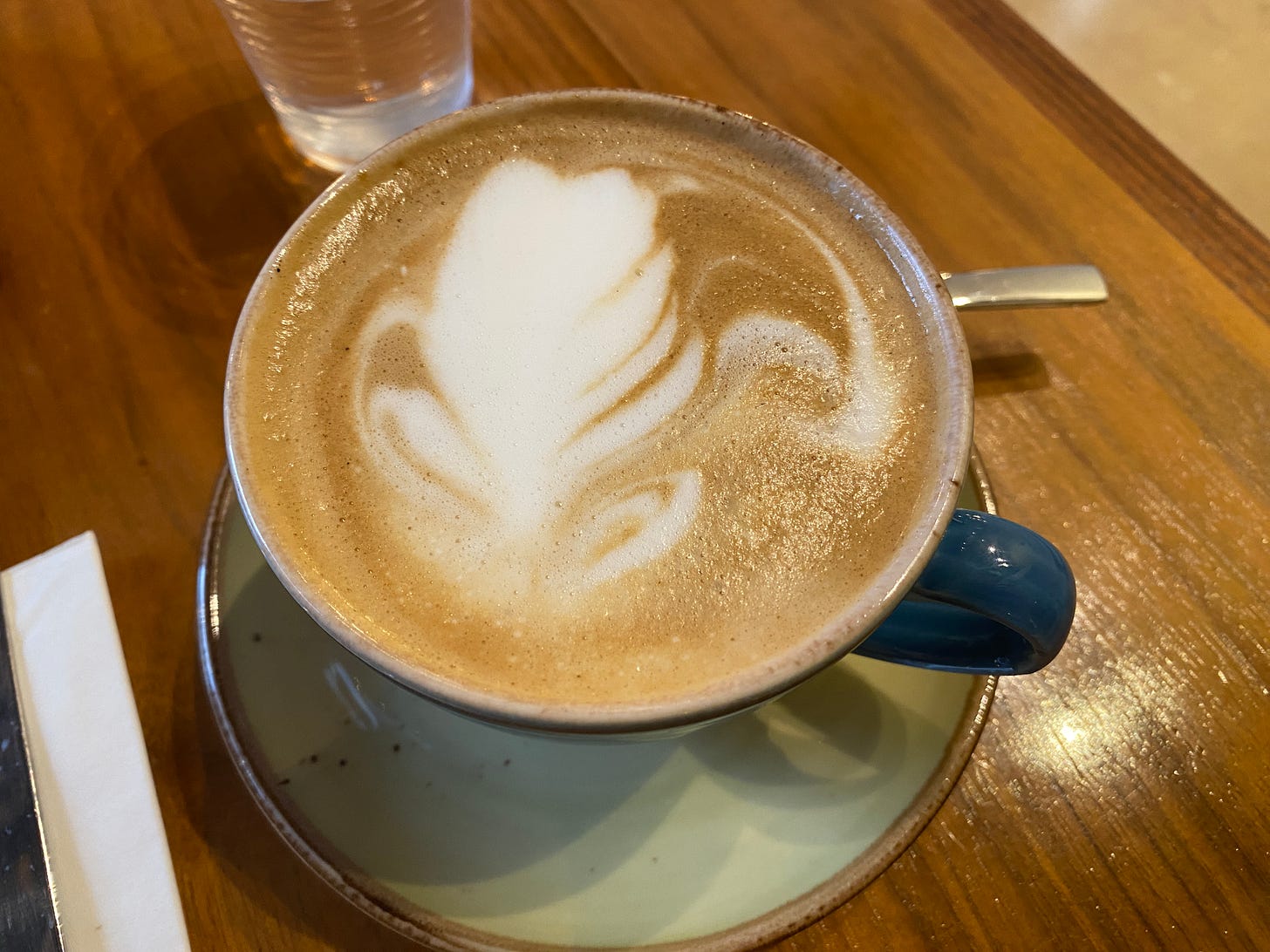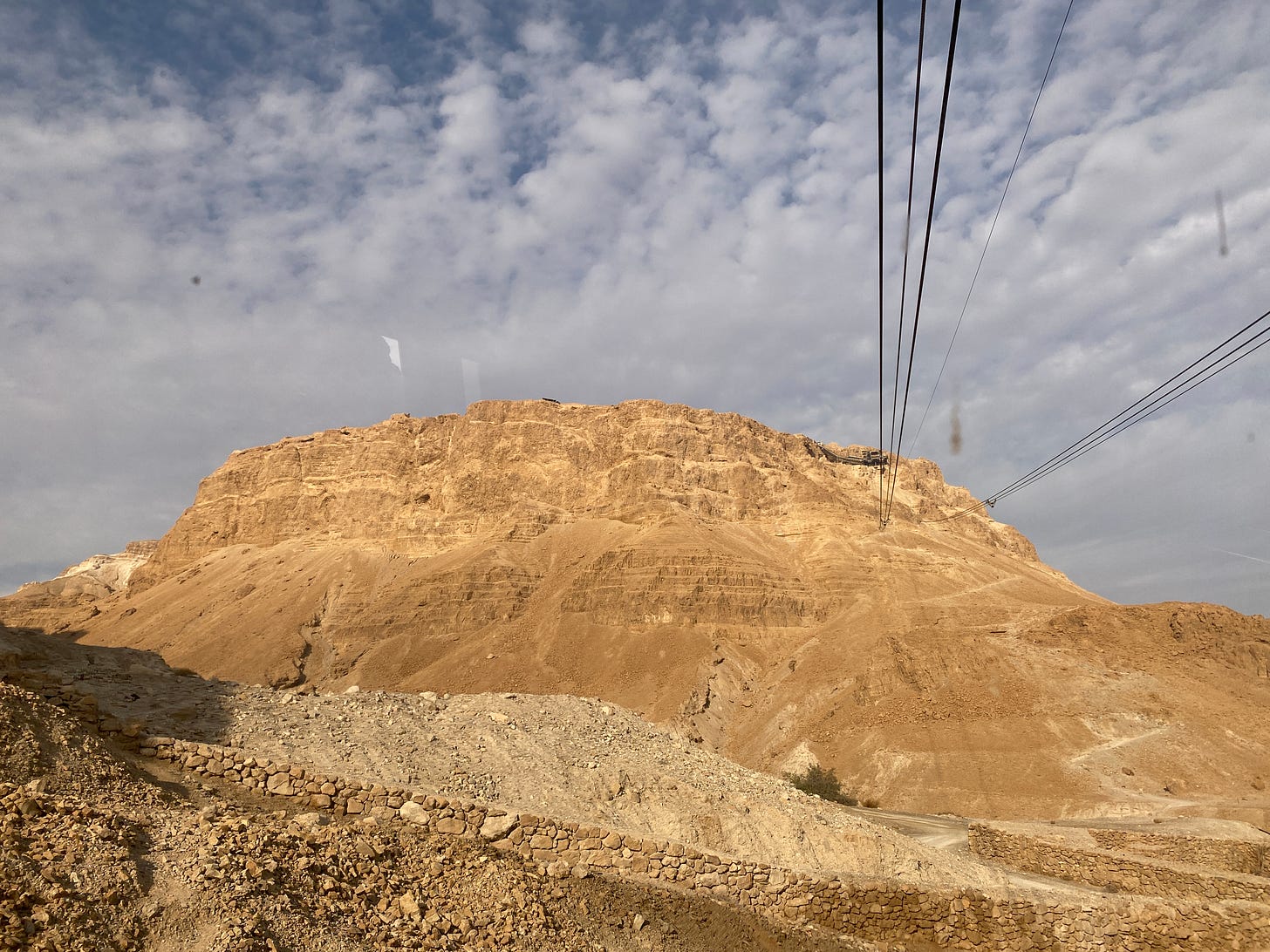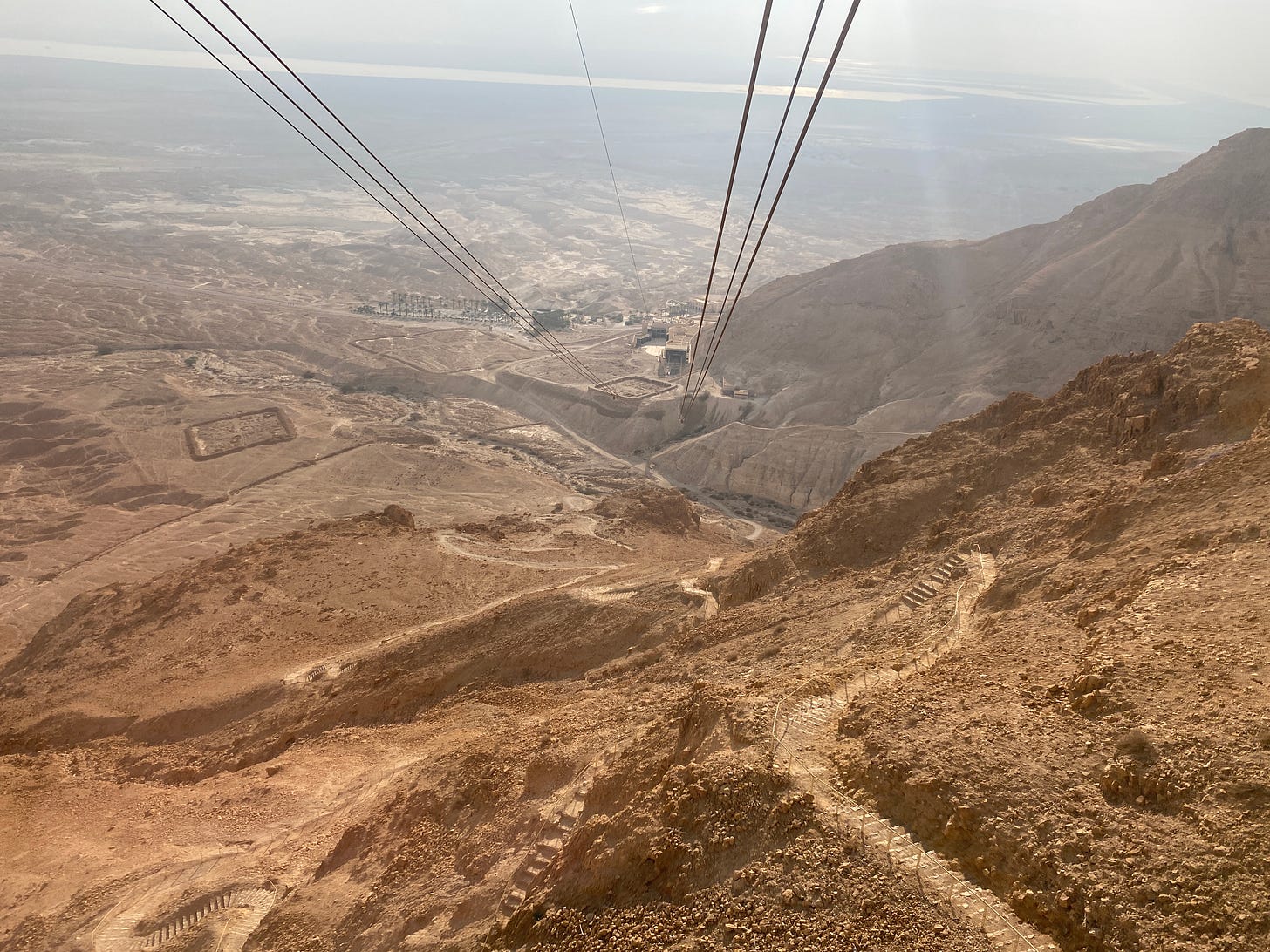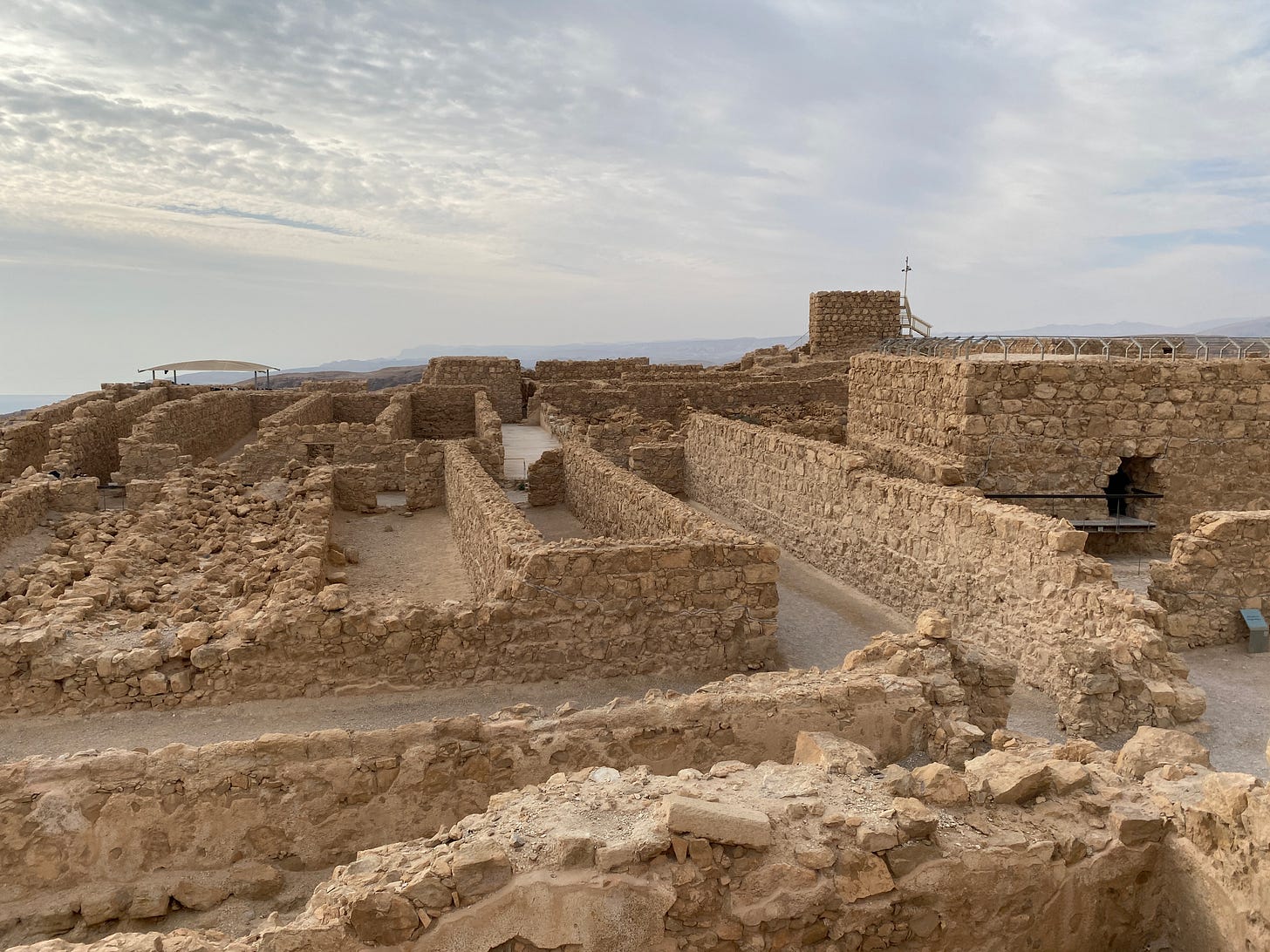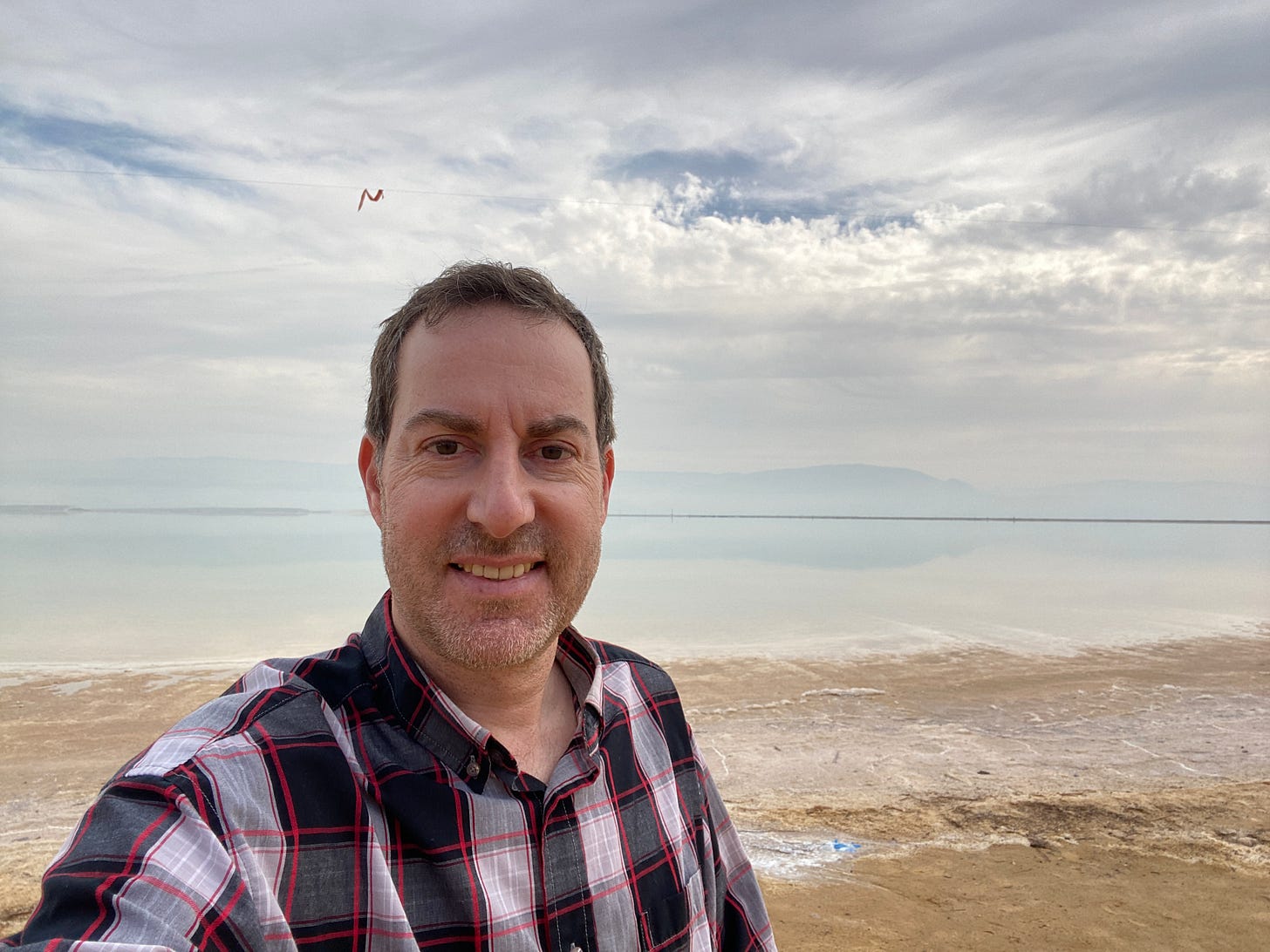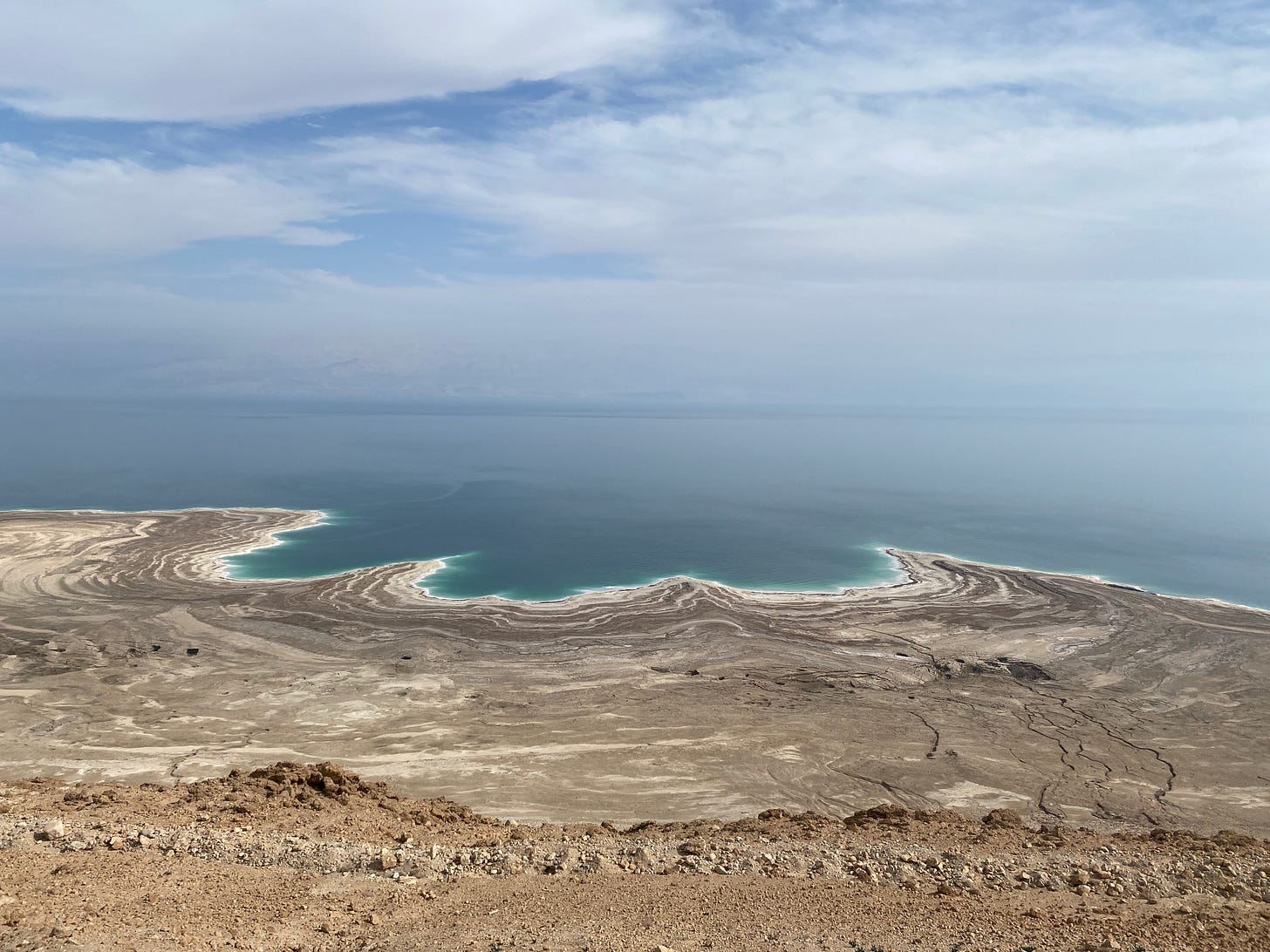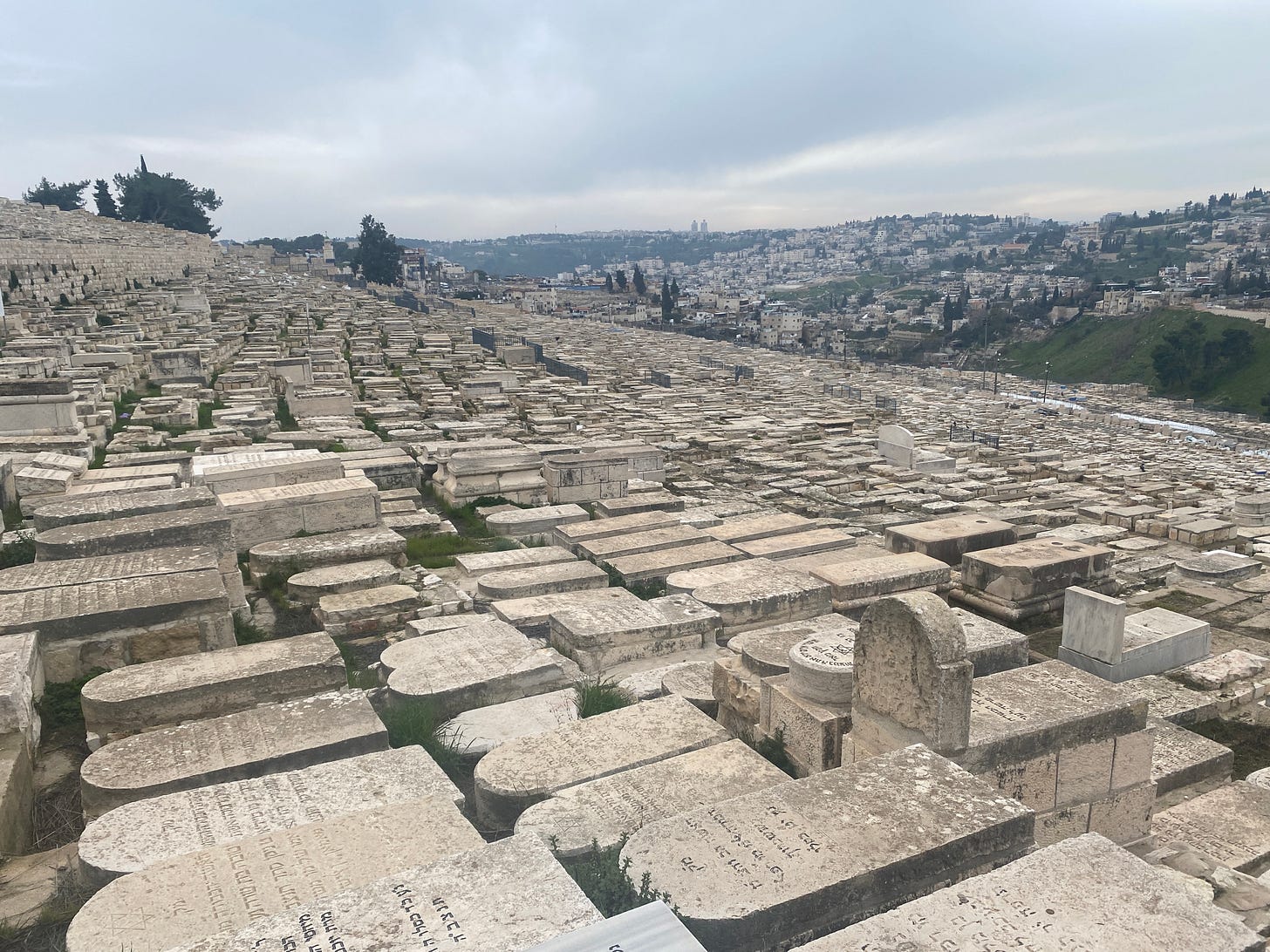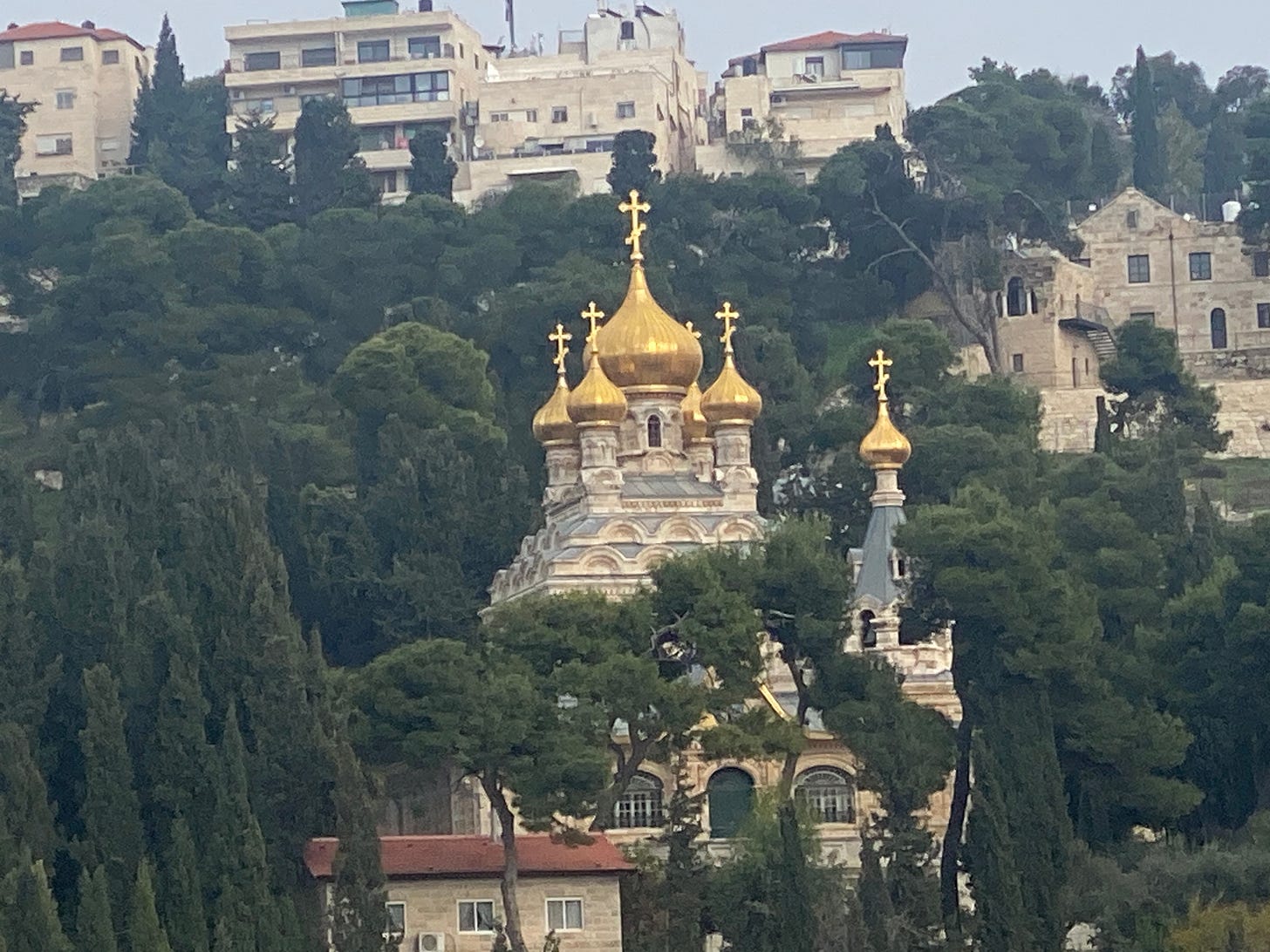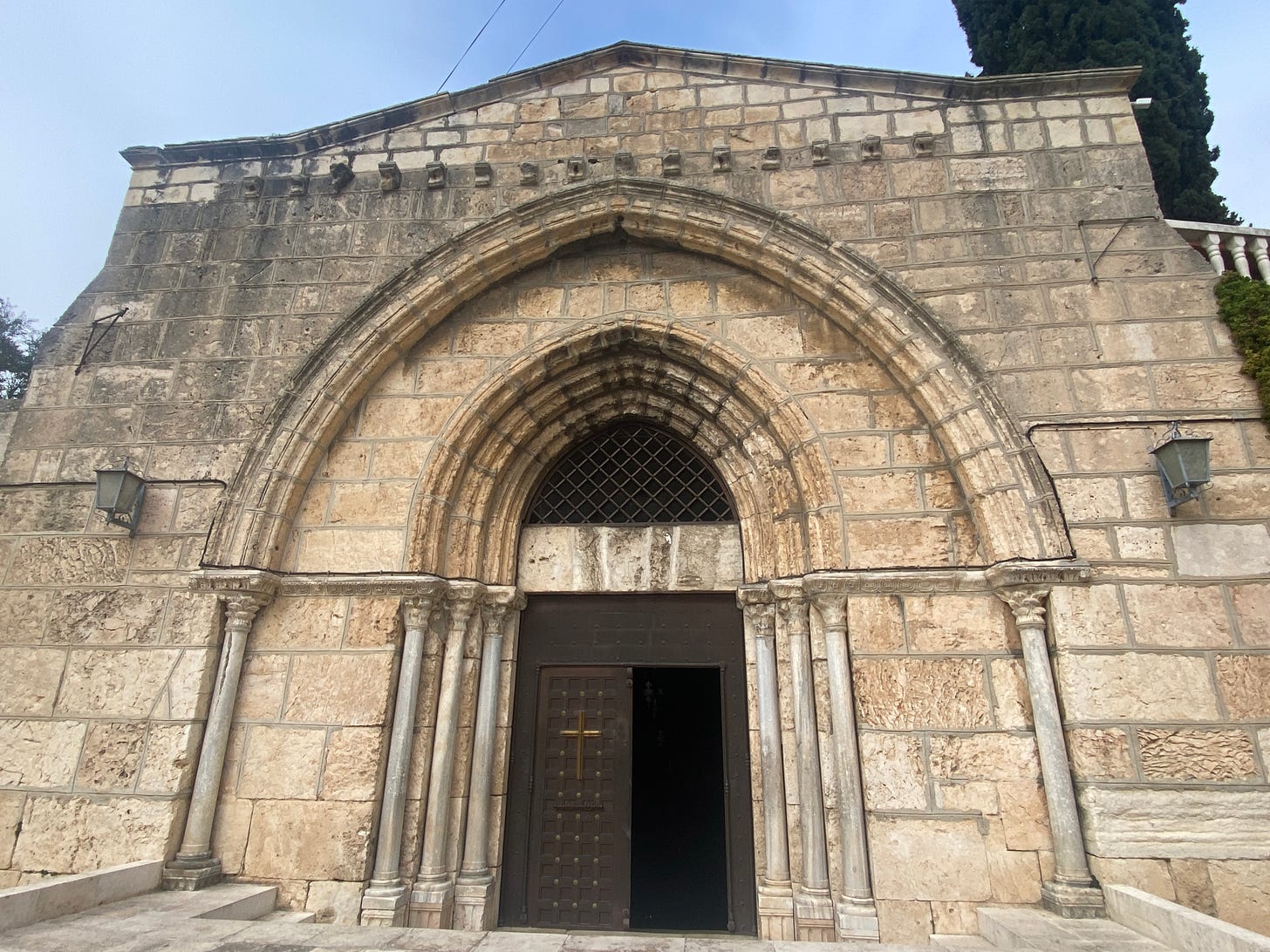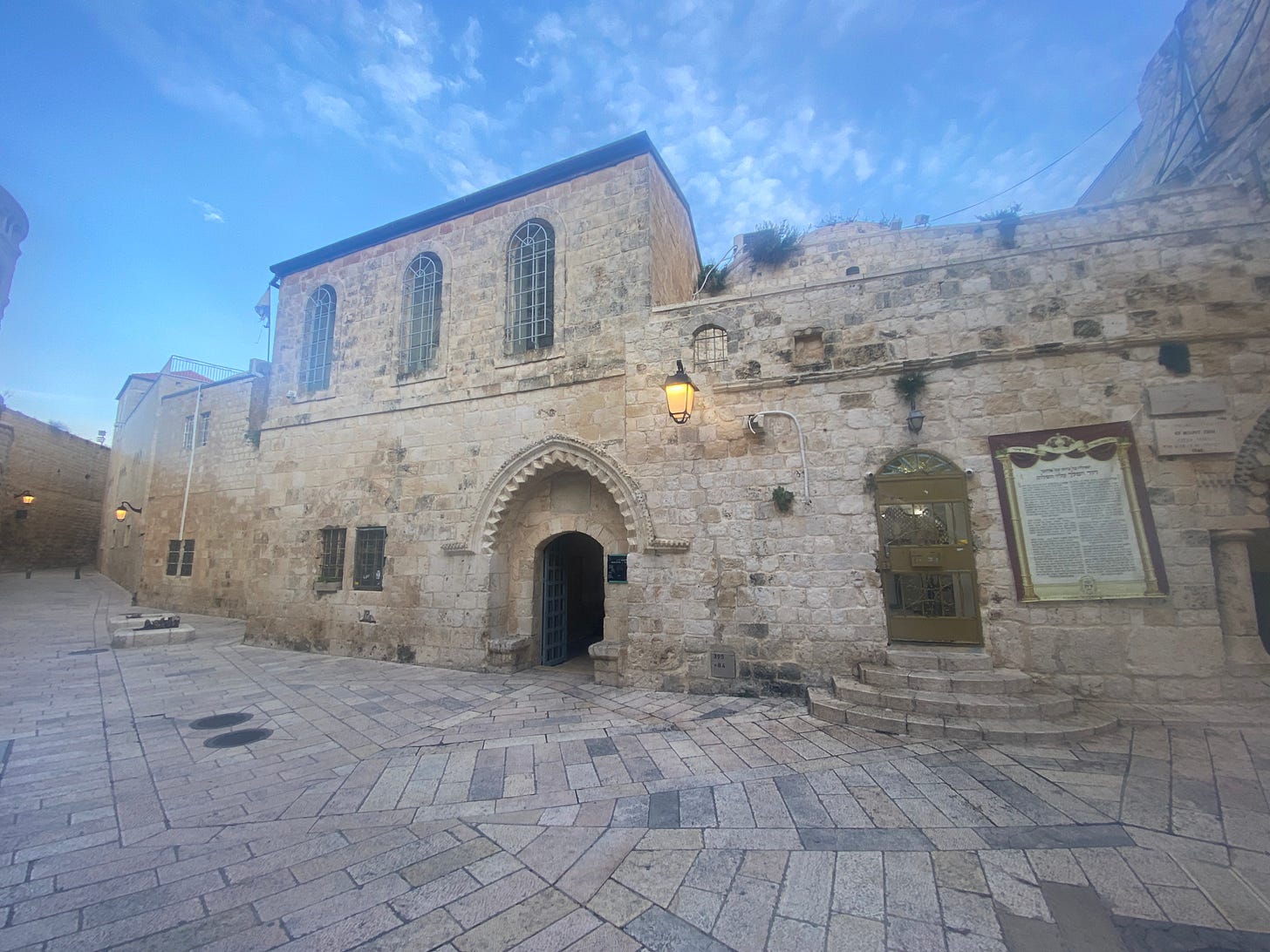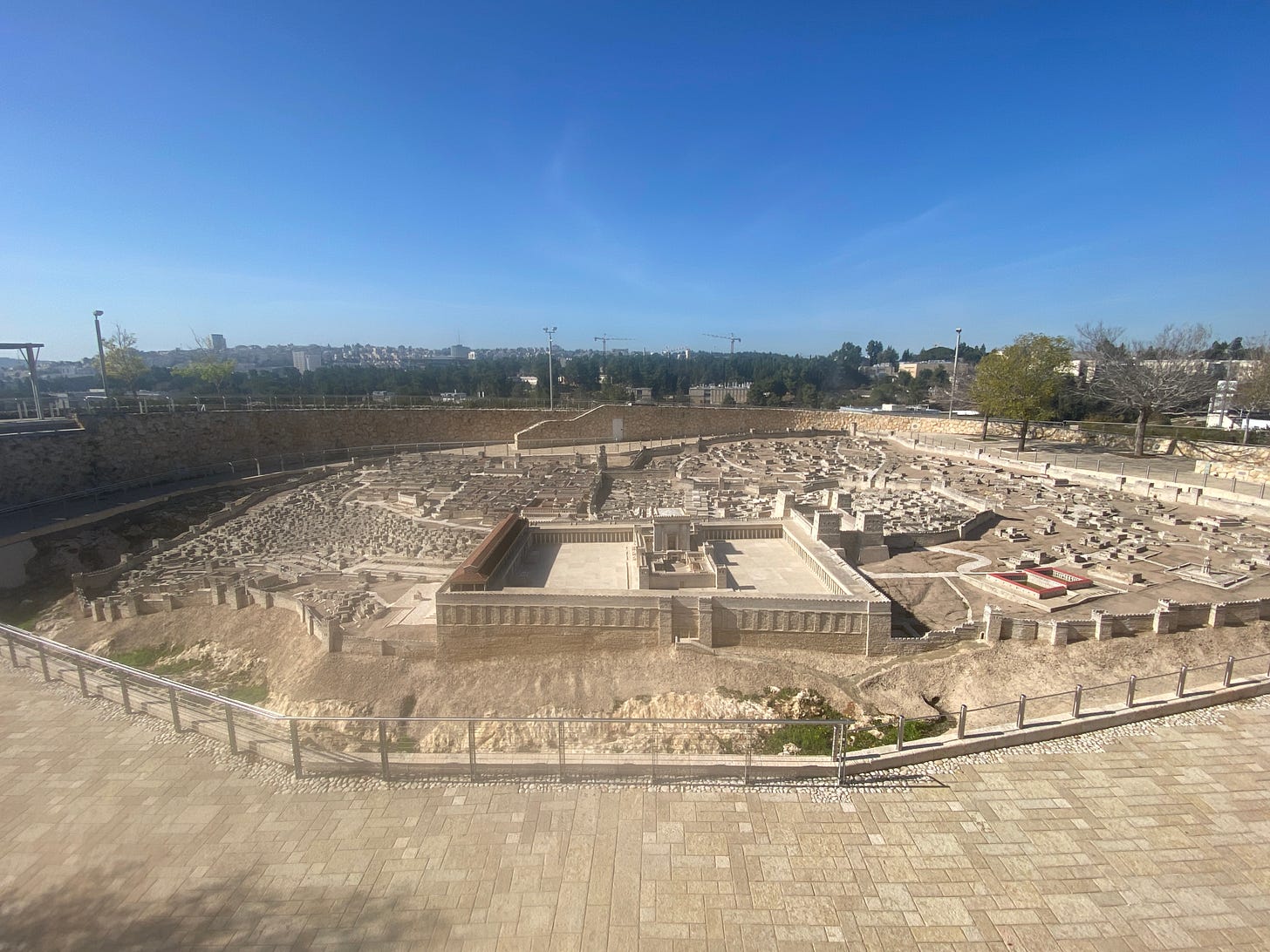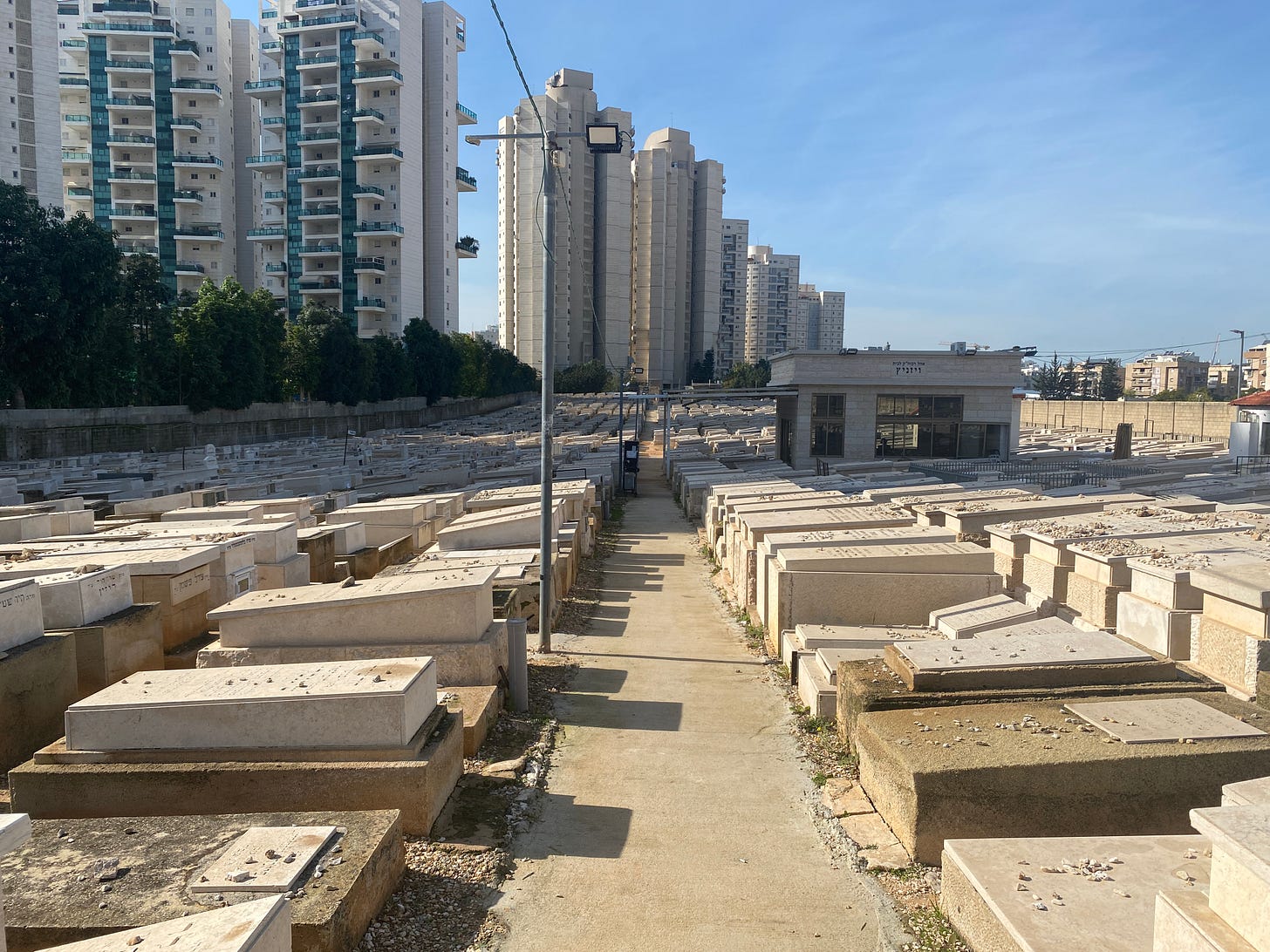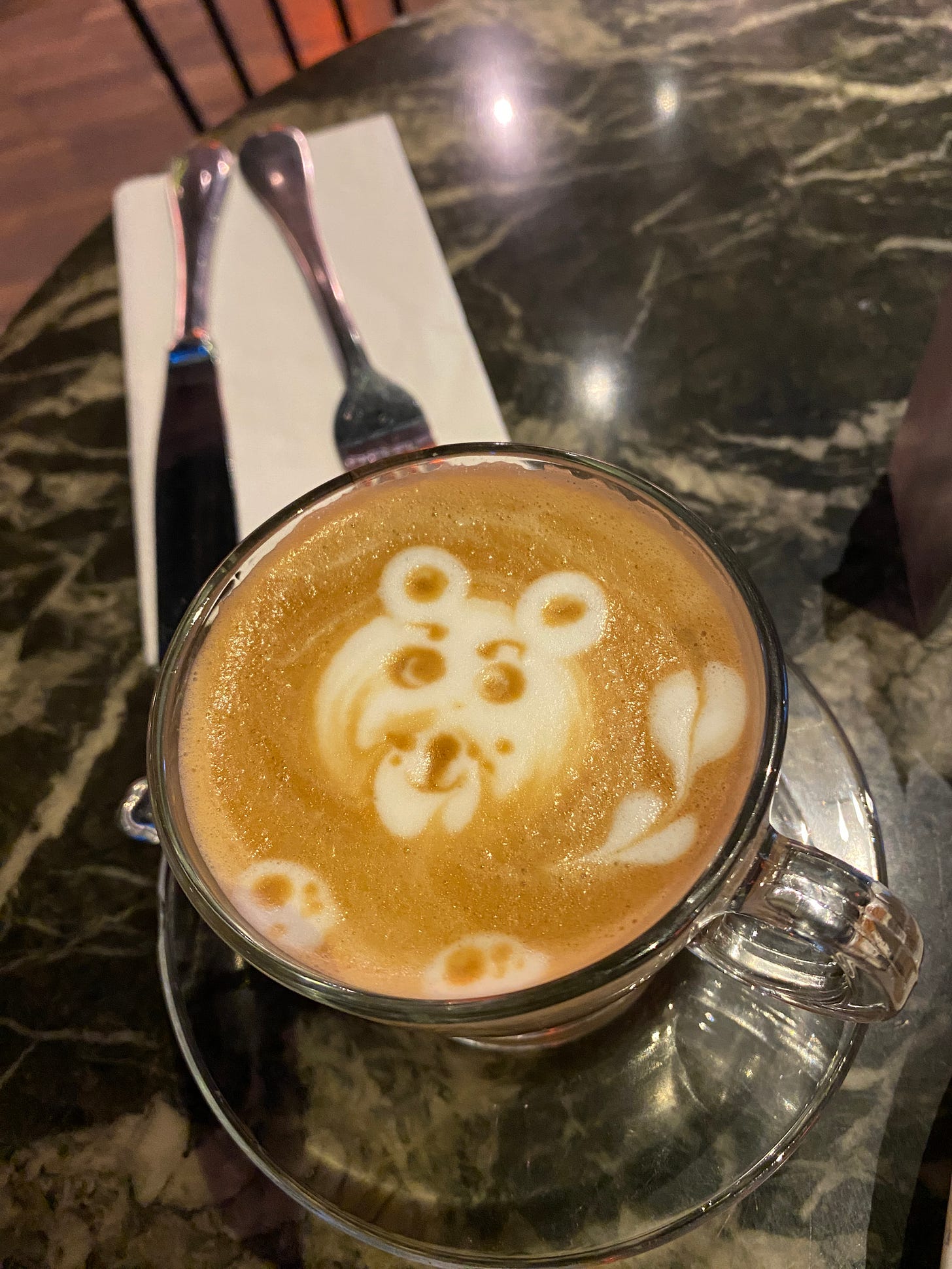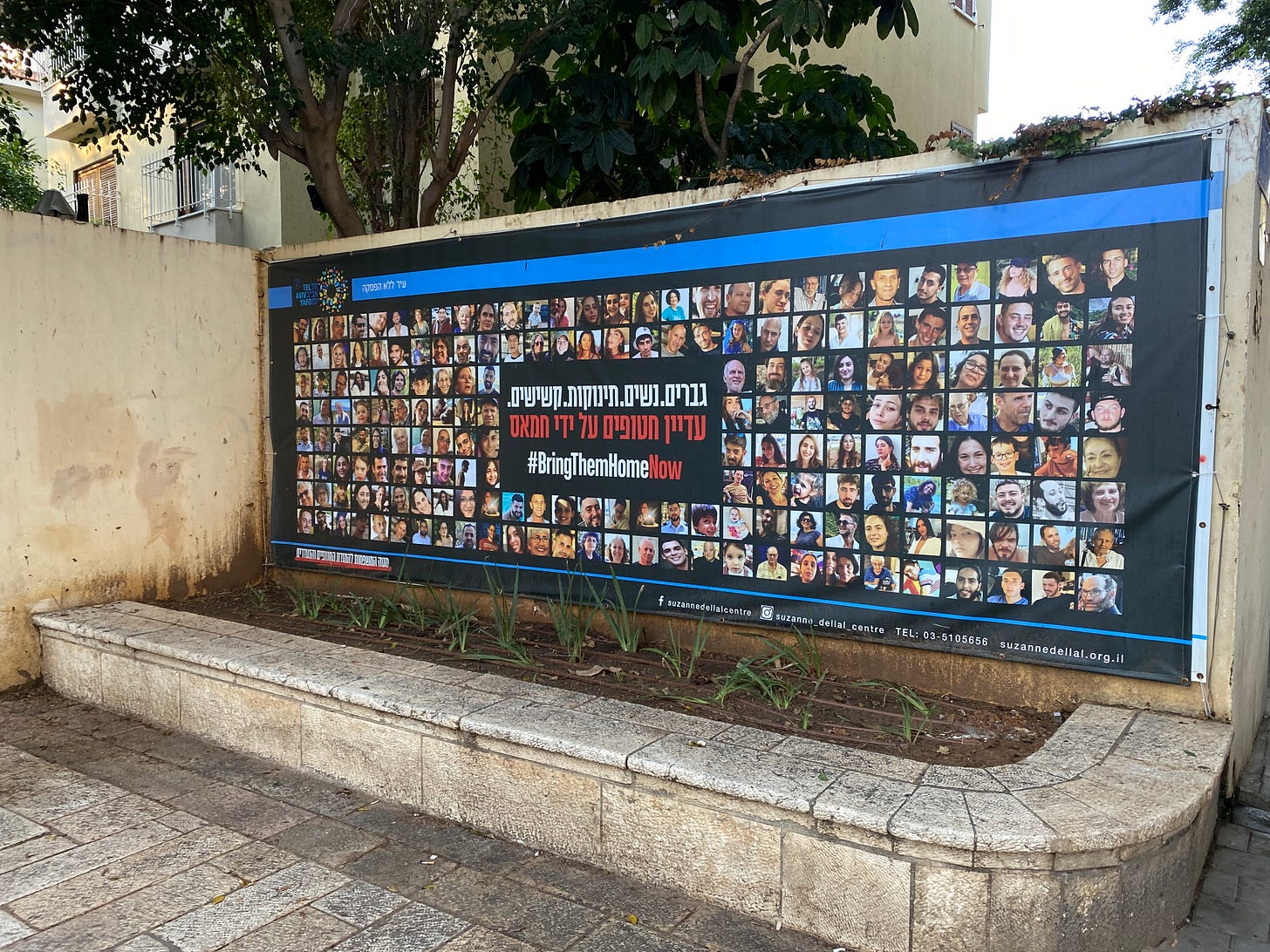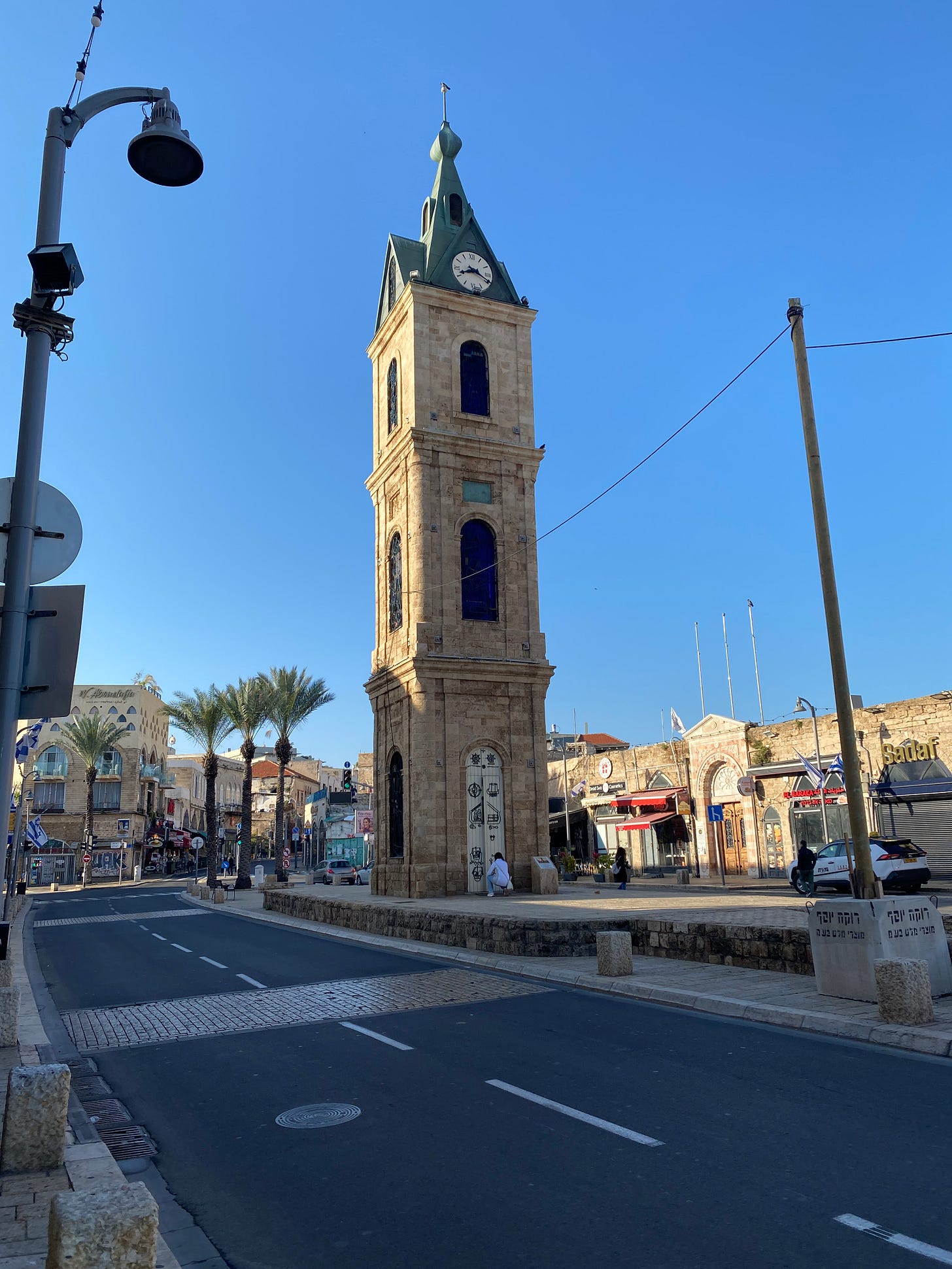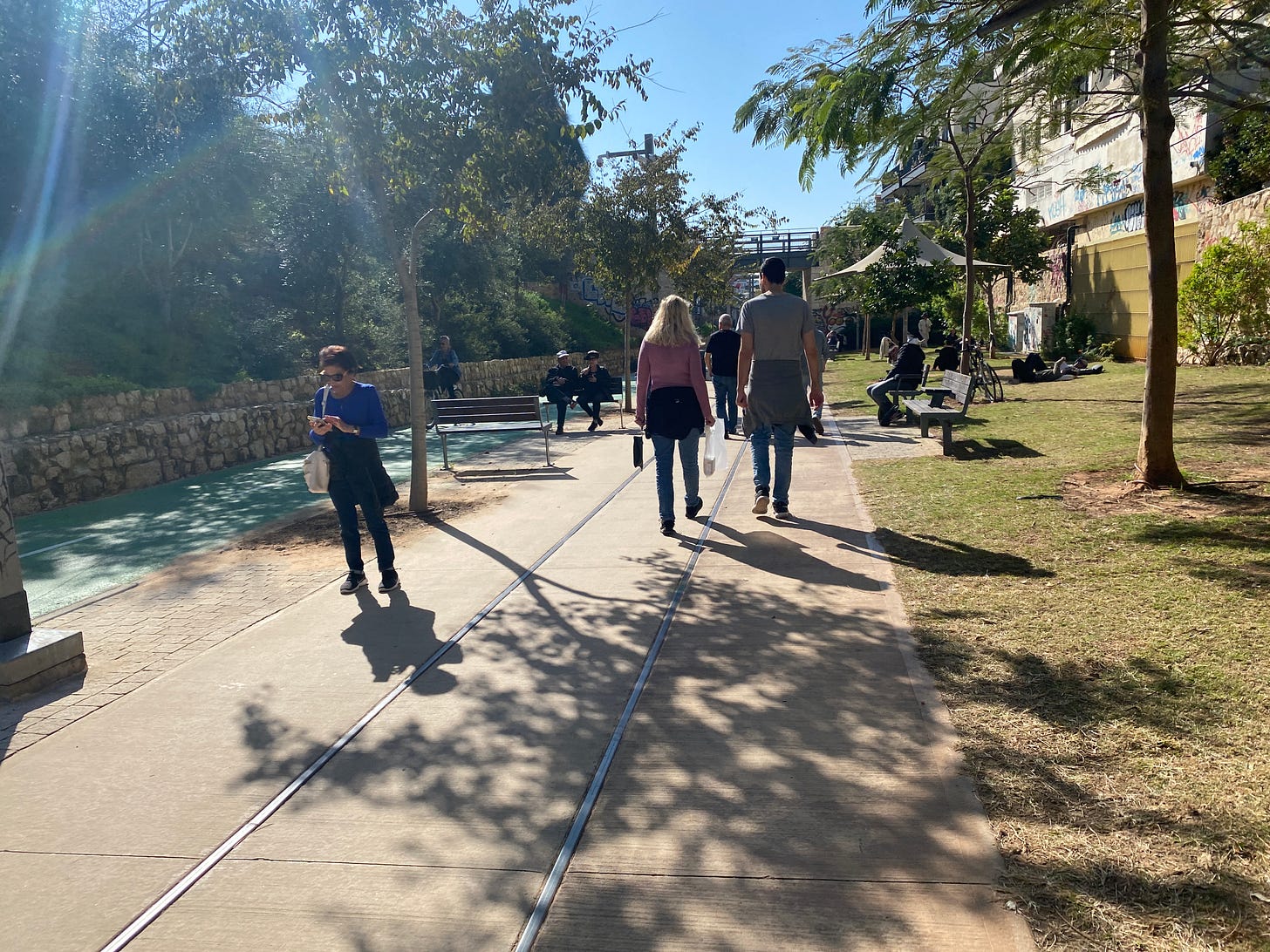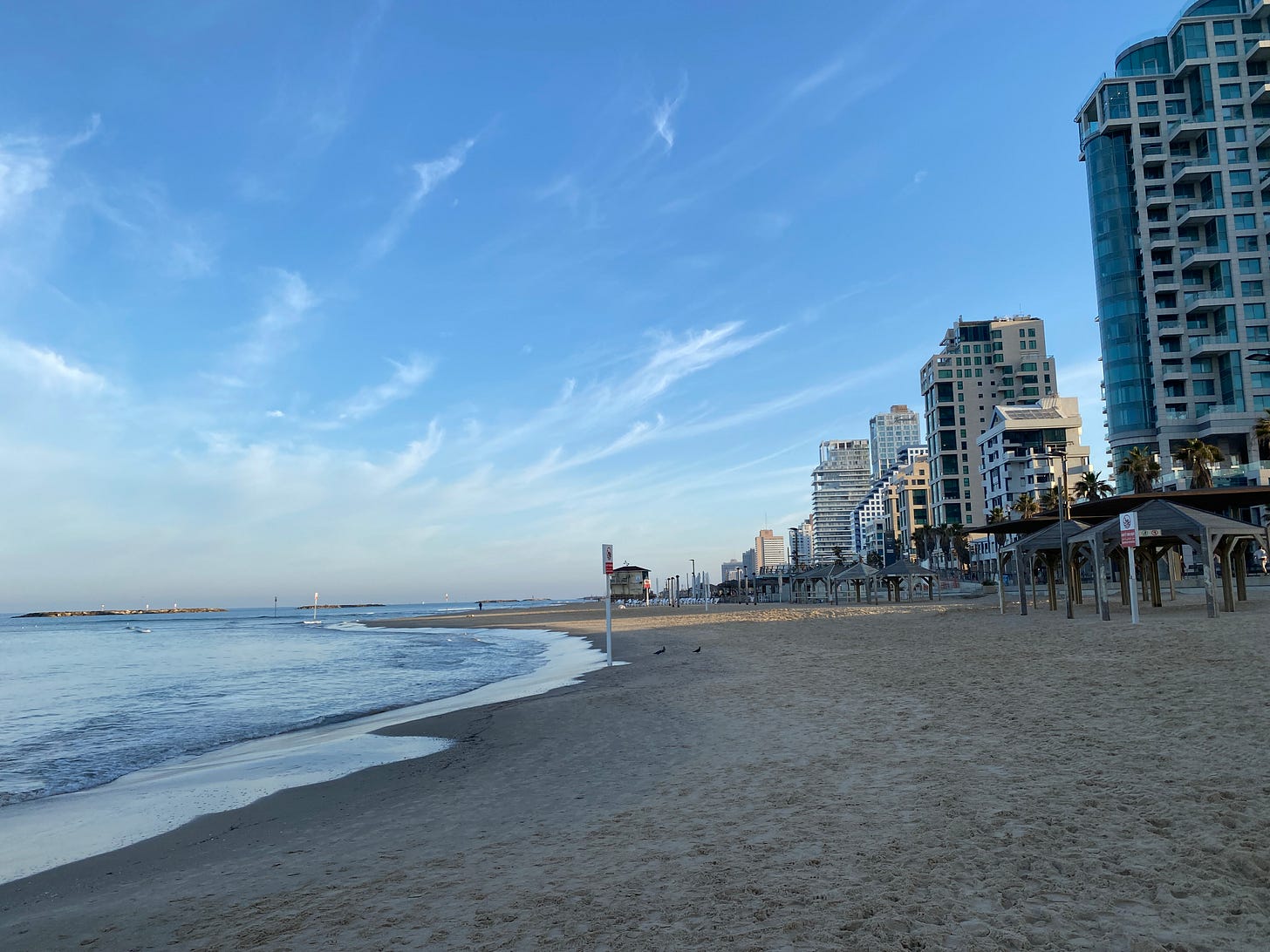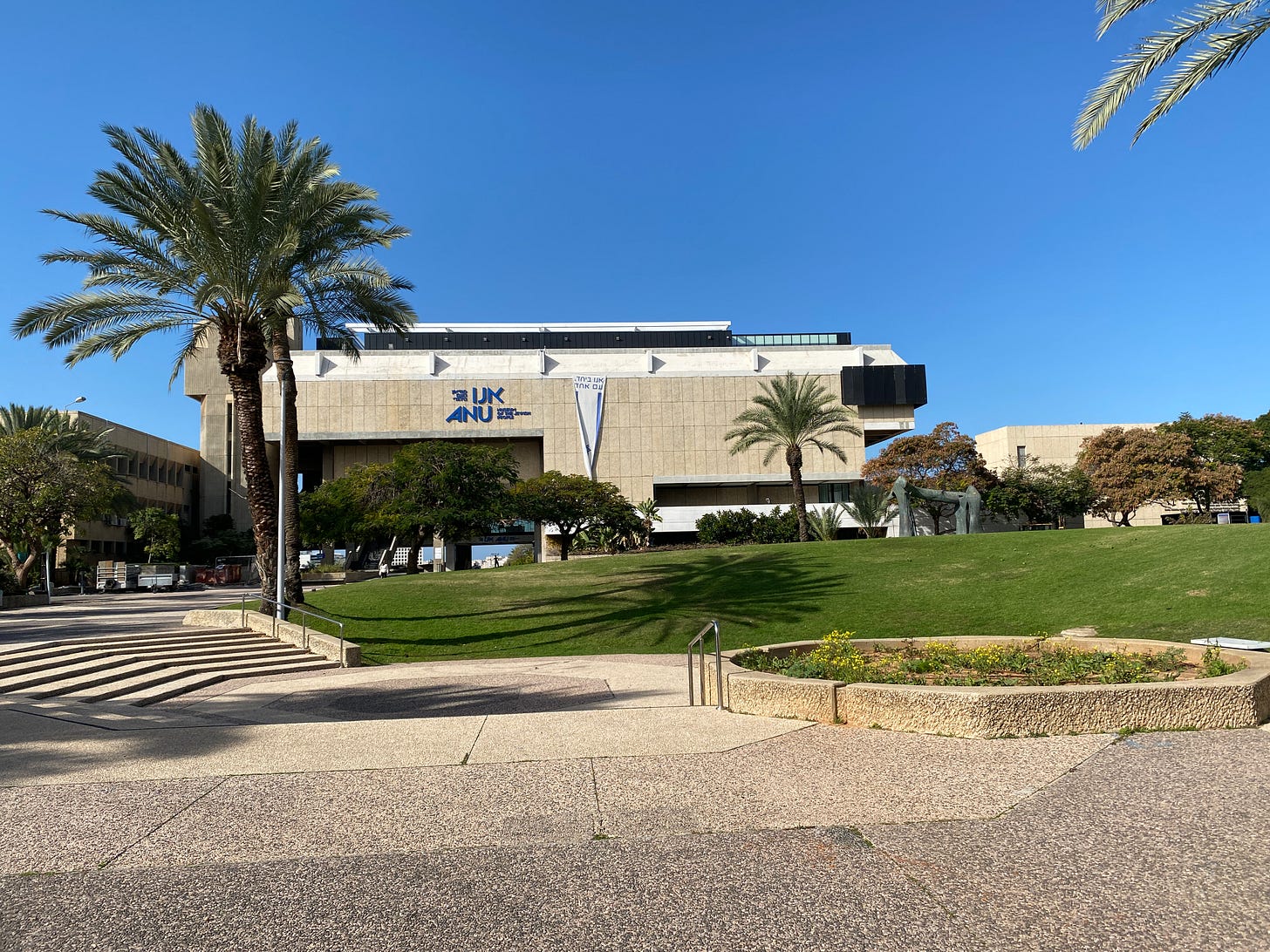“You’re canceling your trip, right?”
This was the typical reaction from friends and family when the subject of my upcoming January 2024 visit to Israel came up in the wake of the brutal attack by Hamas on October 7th, 2023.
When I said no, I was not planning on changing anything, many thought I was crazy. I wasn’t though. There were indeed plenty of reasons to cancel the trip, but I had plenty of reasons not to.
I had actually first started planning my trip in 2019. Despite being Jewish and intrigued by ancient history, I had never been to Israel. Although I had been nervous about my safety long before October of 2023 and always had general unease about going to a place where English wasn’t the first language, I was determined to go. I love going to places with buildings and artifacts dating back not just hundreds, but thousands of years.
I loved visiting England for that exact reason. It helped that I had seen the Tudors TV show about the life of Henry VIII, and several other programs about Richard I, Richard III, Elizabeth I, William the Conqueror, and the Viking invasion of England. I had then chased that high with trips to France and Norway, which were great, but just didn’t do it quite the same for me.
I knew Israel had a past (and present) that played a central role in the world. It didn’t hurt that, despite the fact that I’m not super religious, as a Jew there was a certain connection to the country. Being descended (partly through genealogical records and partly through historical tradition) from its ancient ruler King David only solidified that link.
I planned extensively for that trip. That’s not unusual for me. When planning a trip to foreign countries especially, I pick restaurants ahead of time based on customer reviews and my own picky taste. I not only plan out driving time between attractions, but also research what parking options are available and locate backup parking just in case my first choice is full. I look into tipping customs, find out opening hours, and plan out the times I expect to be at each attraction. Some would call it overplanning or taking the spontaneity out of traveling. I call it doing everything I can to avoid stress when I’m there. As for spontaneity, with a firm plan in place, I know I can change my mind at the last second based on a whim.
But that trip was not meant to be. Why? I had planned it for March of 2020. When Covid hit, I held out hope that those “two weeks to slow the spread” would be the end of the scare, but of course that’s not how things played out. I canceled my trip with deep disappointment. I had used miles for the flights and had bought refundable hotels, so there was almost no financial loss.
Israel didn’t open things back up for a while after the start of the pandemic. I eventually adapted my existing plans into a new trip scheduled for November of 2022. I basically had all the heavy planning work laid out in a 30-page Word document. I just had to book everything all over again. My good friends Zach and Kim and their son Mitch were also planning to go around the same time, and we were going to spend a few days together.
In October 2022, however, my health took a turn for the worse, and I made the tough decision to cancel everything all over again. It was devastating, but I knew I wouldn’t be able to enjoy the trip in my condition.
Fortunately, with medical assistance, time, and good fortune, most of my symptoms got better. I wasn’t feeling perfect, but I decided that I was ready. I booked the Israel trip all over again, this time for January 2024.
Then October 7th happened. Hamas terrorists tortured, terrorized, murdered, butchered, raped, and kidnapped innocent Israeli citizens.
My mind and heart were consumed with the tragedy and the world’s mixed response to it. But I wasn’t ready to cancel my trip a third time, and I was more determined than ever in some ways to show my solidarity with the people of Israel and not to let evil prevail. I also felt that in some ways, during the weeks and months after the attack, despite the ongoing war with Hamas, the Israeli government and the Israel Defense Forces were now on high alert. Perhaps it was safer than ever.
Of course, most people I knew weren’t so optimistic. As kind and acquiescent as I may sometimes appear, however, I’m pretty stubborn and independent about certain things. I was not changing my plans.
My carrier, American Airlines, and its partner, British Airlines, canceled flights to Israel in the immediate aftermath of the attack, but mine were scheduled for three months later so I figured I was in the clear. Then one day in December, I got an email that I had to call American Airlines to “rebook a flight.” I figured this meant the flights had finally been canceled like so many others, but it turned out I only had to change my plans by a day. I wasn’t given an explanation, but I would make this work. I had intentionally booked only refundable hotels again, so I just had to change some dates, the car rental, parking at LAX, and some site tickets. It was not that big of a deal.
A few weeks before the trip, however, I got another email from American Airlines. This time when I called, I found out that all their flights to Tel Aviv had been canceled with no indication of when they’d be rescheduled. I had again used miles for round trip business class tickets, and now I frantically searched the internet for alternatives. I found El Al, Israel’s national airline, had a few available seats. They were expensive, and I debated whether I was being too obstinate. Was this all a sign I should just postpone the trip?
I put the new flights on my credit card. They were direct routes from Los Angeles to Tel Aviv, unlike my previous itinerary, so in that way, the forced change was a big plus. The dates for my trip changed slightly, so again, I went back and made all the changes.
On January 9th, the day finally came. I departed Los Angeles for Tel Aviv, arriving in the afternoon on the 10th.
Ben Gurion Airport was quiet, just as I had read from the social media posts of a few fellow bold travelers. Despite at least one large flight having just arrived, the airport seemed nearly empty. The posters of kidnapped men, women, and children who were still being held in Gaza were displayed as arriving passengers walked toward the baggage claim. Those pictures served as a stark reminder of the unimaginable suffering going on not so far away.
After a long wait at the baggage claim, the young Israeli woman who checked my passport asked where I was going. I named some of my major destinations: Tel Aviv, Jerusalem, Akko, Caesarea. She asked what my purpose was. “Sightseeing,” I blurted out, for a brief moment forgetting how tasteless that could sound, given the present reality. She asked, “You know about the war going on?” I was taken off guard and didn’t know how to react. “Yes,” I said, wishing I had a better response. This wasn’t the way this already nervous traveler had hoped things would begin.
I walked to the Hertz car rental pickup located in a large garage. There were just a few other people there, including an American couple in their 60s from Boston. They told me they had a place in Jerusalem and were there to do some volunteering. Despite the small number of customers, there was a very long wait. When I finally got to the desk and finished a long check-in process, I walked to a small SUV called a Kia Niro, but the anti-theft code I entered on the dashboard keypad didn’t work. I walked across the garage back to the rental desk. The man who had processed my rental said I may not have entered the code right. I didn’t push back. He walked back with me to the car. He tried the code himself. It didn’t work. He admitted it was wrong and gave me the correct one.
I had set up the Waze navigation app (an Israeli invention) ahead of time with nearly all of my planned destinations. I didn’t want to be sitting in traffic somewhere in Israel struggling to enter a destination correctly. Now that I was actually here, ready to leave the car rental parking lot, Waze was giving me navigation instructions in Hebrew, which I don’t speak other than a few words and phrases. I found a way to switch to English, but then it wouldn’t say the street names, so that was a compromise I had to make.
Driving to Tel Aviv was stressful for me. Having not been able to fall asleep on the plane probably didn’t help. Luckily, most of the traffic signs were in English in addition to Hebrew and Arabic, just as I had discovered in my planning. I did find that being in a foreign country with different driving customs and laws as well as aggressive drivers was intimidating. As soon as a light went from red (to yellow) to green, someone inevitably honked, presumably to tell the car in front of them (or several cars away from them) to get moving. In LA, the rude honkers at least wait a couple of seconds to give you a chance to take your foot off the brake. Not so in Israel. And on the highways, some drivers had no shame in driving at high speeds just a few feet behind me. Back home, tailgating means someone wants to pass you and has a rude and dangerous way of showing it. Not necessarily the case in Israel. When I changed lanes, the tailgater often didn’t pass. It was almost like some drivers are just conditioned to follow incredibly closely, like there is some innate sense of comfort in traveling at high speeds just a few inches away from the car in front of them.
About 45 minutes later, I arrived at the Gruzenberg parking structure in Tel Aviv. I couldn’t find an elevator, but luckily, I was only a few floors up and could roll my suitcases down the vehicle ramp to get to the ground floor.
Even though I had Google Maps on my phone and the hotel was supposedly next door, I had lost my bearings. A man in his 60s was standing outside the parking structure. He seemed to be interested in helping the conspicuous luggage-wheeling tourist standing on the small street. I used a sentence I would use a lot on this trip: “Ani lo medaber eevreet.” It means, “I don’t speak Hebrew.” It was easier than asking if the person spoke English because that question changes based on the person’s gender. The man said he didn’t speak English, only Hebrew… and Spanish. This was quite a surprise. But my Spanish is actually decent, and I was delighted that I could communicate with him. I learned that he was an Argentinian Jew. He directed me to the Fabric Hotel, just a few feet away.
The boutique hotel was clean and stylish. The young man sitting at the front desk that night was friendly and spoke a good amount of English. After telling me about the hotel’s happy hour and breakfast, he told me about the location of the safe rooms, reinforced rooms where civilians go in the event of an air raid siren, indicating some kind of bomb or projectile attack. The presence of this Merkhav Mugan (protected space) was something I knew to expect, but just the idea of it was a disturbing reminder that despite the fact that I was on a sightseeing trip and the people here were going on with their daily lives, we were never truly out of danger.
The hotel wasn’t busy, but there were a few guests who passed through the lobby. They all spoke Hebrew, so I assumed they weren’t tourists from out of the country.
The room was relatively small by American standards (outside of Manhattan), but welcoming. The refrigerator had bottles of water and soda that were free. After getting settled in, I went to the hotel’s bar/café downstairs for happy hour, which was basically wine and some pre-packaged snacks. I took a small plate upstairs to the roof deck and looked out for the first time at the Tel Aviv night sky. I saw more than some skyscrapers reaching out past the shorter apartment buildings with which they shared crowded streets. This was the Holy Land, the home of so much historical and religious significance that I couldn’t fully wrap my head around it.
I returned to the room. I was exhausted, but I knew I should stay up as late as possible to get used to the 10-hour time difference.
The next morning, I returned to the same downstairs café a little after seven. There was a breakfast spread that included various kinds of fish, yogurt, cheese, granola, juices, olives, bread, mini croissants, fruit, and vegetables. Because I am a picky eater, there wasn’t a lot there that I was interested in, but I sat down with a couple of mini croissants to tide me over until lunch. A very friendly young man who spoke excellent English offered me a cappuccino and scrambled eggs, which I was happy to accept.
I had read about tipping etiquette in Israel. If a person feels inclined, 10-20 percent is a general guideline. I didn’t know how much the breakfast cost as it was included in my overall lodging rate, but I wanted to make sure this incredibly welcoming, attentive server was recognized. I asked the young woman at the front desk. She suggested 10 shekels “if someone wanted to.” I didn’t have anything smaller than a 20, so I left that.
I was staying in Tel Aviv for only one night but would be returning later in the trip. I loaded everything back into the rental car and was only a little less nervous about the driving for the day ahead.
As I left the parking structure, I noticed the car’s tire pressure warning light appeared. The right front tire was low. I knew how to handle this at a gas station in the U.S., but would gas stations here also have air compressors that customers could access in the same way? Would I know how to use them? I didn’t want to deal with the problem right then and figured it could wait.
It took about half an hour to travel the 12 miles to Apollonia National Park, also known as Arsuf Castle or Tel Arsuf, in the city of Herzliya. When I got to the site at about 9:40, the dirt parking lot was empty. It was windy and intermittently raining, with a temperature somewhere in the mid-50s. I had bought something called the Israel Pass online. For a one-time fee, it allows a person to get into multiple national parks without paying individually and would save me a lot of money on this trip. After presenting it to a man at a visitor booth who didn’t speak much English, I entered the park. It was nearly empty and would be the first of many tourist sites that would be so strikingly vacant. For a person who hates crowds and excessively hot weather, this would normally have been ideal. But the reality was that this emptiness was part of the aftermath of the tragic events of October 7th and the ongoing war.
Apollonia is on a cliff overlooking the Mediterranean Sea. Like most of the sites I would visit on this trip, it was first settled thousands of years ago and had been home to numerous different peoples, in this case including Phoenicians, Jews, Romans, Samaritans, Crusaders, Arabs and Ottomans. The ruins that remained here were built at different times, but they all were incredible to walk through, especially Apollonia’s 13th century Crusader fortress with its stone keep and dry moat.
There were quite a few times on this trip when I would get confused or frustrated with the lack of signage or posted guidance at historical sites. It was often unclear to me which way to walk, there would be markers from an audio guide that no longer was available, or there would just be no information on what I was looking at. This site, however, wasn’t too bad in that regard. It was clear where to walk, and the placards gave me the necessary background information on each building or ruin that stood before me. The long history of the site and its picturesque placement against the backdrop of the Mediterranean were quite impressive.
After about an hour, I left for my next stop, Caesarea National Park. It was 30 miles away and took about 45 minutes to get there. Like Apollonia, Caesarea has been inhabited by different people, starting with the Phoenicians when the area was under Persian rule (586-332 BCE). It also went through a Hellenistic period (332-167 BCE), a Hasmonean period (167 BCE to 40 BCE), a Roman period (40 BCE to 313 CE), a Byzantine period (313 CE to 640 CE), an Arab period (starting in 640 CE), a Crusader period (starting in 1101 CE), a Mamelukes period (starting in 1265 CE), and an Ottoman period (starting in the late 1800s)! King Herod the Great, who ruled Judea from 37-4 BCE under the authority of the Roman government and had his fingerprints on many of the sites I would visit on this trip, built Caesarea into a large port city and named it in honor of Roman Emperor Augustus Caesar. Eventually Caesarea became the headquarters for Rome in the Holy Land. It had aqueducts, a temple, markets, residential areas, and a theater, many of which still survive today.
Despite this national park being a major tourist attraction, the parking lot was completely empty when I arrived around 11:30. The site itself was a little busier than Apollonia, but not much. I walked for several hours among the ruins of various buildings dating back over 1,000 years, taking a break to eat at a restaurant called Hazal Banim (Crusaders), located on the historic harbor with views from my table window of the waves crashing below.
The staff at the restaurant moved at a more relaxed pace you could say, compared to the waiter at the hotel cafe that morning. The food was surprisingly good though. I had beef filet medallions with green beans, potatoes, and a side of hummus.
Around 3:30, I drove about 25 miles (40 minutes) to the Carmella Boutique Hotel in Haifa. When I arrived, I was supposed to call the front desk to have them let me into the subterranean parking. They charged 40 shekels (roughly 10 dollars) for parking, but I neither saw anything available on the street nearby nor was ready to start translating street parking signs, which usually were only in Hebrew.
The hotel was quaint, yet relatively modern. I was given a nice little room on the main floor. I didn’t feel like going out to eat, so I ordered in using Wolt, the Israeli version of DoorDash, GrubHub, or PostMates. I picked a place called Shawarma 52 and received a chicken shawarma with fries pretty quickly. It wasn’t gourmet or anything, but it was pretty good.
On the morning of Friday, January 12th, it was overcast and drizzling. I walked about five minutes to Cafein Café. The young woman there was friendly and showed me a menu in English. I ordered shakshuka with cheese and a coffee. I had heard about shakshuka from my friends Zach and Kim and had seen it on a show they recommended called Somebody Feed Phil. Shakshuka contains eggs poached in tomato sauce, olive oil, peppers, onion, and garlic. I opted for cheese, too, since the young lady offered it. They gave me a lot of bread, which I used to soak up the sauce as I had seen on the show. It also came with a salad including lettuce, cucumber, and tomato that I nibbled at. The meal wasn’t bad, but it was not exactly my new favorite breakfast.
After walking back to the hotel and packing up the car once again, I headed out. I heard a ding and saw the tire pressure light glow again. I decided to pull into the next gas station I saw. The attendant inside was in his early 30s, but I couldn’t tell if he was an Arab or a Jew, which I often found to be the case on this trip, a fact that might surprise a lot of people who have never been to Israel. I asked him if he spoke English, to which he said no. I made a motion of filling up an imaginary tire and made a hissing sound. I felt kind of silly. He shook his head and said something to indicate that their machine wasn’t working. He then pointed away from the gas station and said something like “Shech.” Was that Hebrew? Arabic? I assumed it meant, “That way.” I thanked him, but I didn’t know where “that way” was and didn’t see any other gas stations nearby. I figured it was not an emergency so I’d try to stop worrying about it.
I drove a little further and arrived in the city of Akko, also known as Acre, a little less than an hour after leaving the hotel in Haifa. I parked in a large lot that used to be the moat surrounding the city.
Akko has been a settlement since the Early Bronze Age and has exchanged hands over the millennia many times since. Today, as one of Israel's mixed cities, it is home to Jews, Muslims, Christians, Druze, and Baháʼís. The majority of the Old City, where I’d be visiting, is Arab, while they comprise a third of the city overall.
The Old Akko Visitor Center was supposedly only a four-minute walk from the lot, but I didn’t find it easily, even using my Google Maps app. The app kept directing me down roads that didn’t lead me to the right place. Residents were walking down the streets, setting up shops, and many were entering a nearby mosque.
I eventually found my way to the visitor center. It was empty at first, but, in a minute or two, an Israeli Jewish woman who spoke a little English looked at my reservation and said they were having electrical problems, so it would be about ten minutes until the audio guide was ready. I sat and studied the map she gave me of the expansive city. Then, she walked over with me to the Crusaders’ Knights Halls where she gave me an audio guide.
The Knights Halls were built by a group of Crusader knights called the Hospitallers in the 12th and 13th centuries. The Hospitallers were a military, monastic order devoted to caring for the sick in the Holy Land and to maintaining the personal safety of the pilgrims who flocked to the holy sites. Their halls, which remain in remarkable condition today, include a fortress, a hospital, a church, and other residential and administrative buildings. The audio guide was informative. The halls were also almost entirely devoid of people.
I returned the audio guide to the visitor center and continued on through the city. I followed signs and used the map to see the “highlights” of the area, the next of which was the Turkish Bath, which I hadn’t planned on going to. I guess it was relatively recently built compared to the other historic sites here and hadn’t seemed as interesting during my planning. But I was here and figured I’d check it out. Who says I’m not spontaneous?
Inside, another woman whom I had briefly seen in the visitor center was now speaking to a small group of men in Spanish. When it was my turn, I asked her in Spanish how she knew that language. She said she was from Canada. I was no less confused. She then asked where I was from. She remembered me from a brief e-mail communication we had had months before. I had written to her because my arrival date in Akko had changed due to the flights changing. I had actually brought her email with me and showed it to her. She saw her name at the bottom of the e-mail and said, “Yep, that’s me, Valerie.” It was interesting to put a face to a name in an email from across the world.
She then gave me another audio guide, but this one would automatically play various tracks without me pressing a button. That was neat, but it also suggested I wouldn’t have a lot of control over this “self-guided” tour. I felt kind of stuck now.
The first room in the bathhouse had a video that could have lasted a minute or two for basic historical background but seemed to go on for 10. It was a dramatization using actors portraying some of the men who built and worked at the facility. The English audio came through my device.
I learned that the Turkish Bath was built in the 18th century by Jazzar Pasha, a ruler of the city. It was a social center for old Akko.
Finally, a door opened, allowing me through a hallway into the main bathing rooms of the bathhouse where a new audio track was playing in sync with a displayed video. Eventually I had had enough and made a move for the exit, but it was another electronically controlled door that wouldn’t open until the video ended. I sat down again and waited. Finally the video concluded, and I was out.
I walked by the Al-Zeituna mosque, with its blue-green domes and white cylindrical minaret. It was built on the site of a Crusader church during what I gathered was the 1800s, and its domes are even supported by columns taken from that church.
I walked toward my next stop, the Ramchal Synagogue, which was supposedly only two minutes away, but again the Google Maps app wasn’t accurate, and the posted signs were never there when I needed them. I ended up going through a lot of narrow alleys, passing a lot of stray cats wherever I turned, and got stuck in Akko Market, a long covered street that was active with residents selling large fresh fish and other wares. I felt out of place and was relieved when I finally was able to exit into the open air.
Finally, I arrived at Ramchal Synagogue, which looked from the outside like any other room in an old building on a narrow street. Through the open door of the adjacent visitor center, I saw two middle-aged Israeli Jews who I learned were named Noah and Ruben. Noah led me on a tour, which was more of a “talk” since there wasn’t a lot of space to actually walk through. He took me into the small, one-room synagogue where he had me sit down. He told me the story of its founder, Rabbi Moshe Chaim Luzzatto (Ramchal), who came from Italy to Akko in the early 1700s. Noah then showed me a five-minute video that covered some of the same material. The synagogue itself was not too impressive in terms of architecture or aesthetics, but it was still nice to be there.
Noah then took me into the adjacent visitor center, which focused on the Jewish community in Akko during the Crusader period in the 12th and 13th centuries. The visitor center was actually more interesting to me than the synagogue itself. It had walls still standing from the Ottoman era when this area was the Genoan quarter of Akko. There were still stones, a foundation, and a well dating from the Crusader times. He told me that only three percent of Akko’s history has been unearthed by archaeology because excavation is limited by the presence of people living right on top of the potential digging sites.
I talked with Noah for a bit about all sorts of things. When I asked how Jewish and Arab relations in Akko are, he said they’re pretty good. He said that the Arab residents there are not on the side of Hamas and that they want tourists to visit Akko again, too.
On equally pressing matters, I just had to ask him: “What’s with all the cats?” In fact, I must have seen a dozen cats on the streets of Akko in those few hours, but I had also seen an inordinate number throughout the entire trip. He raised his eyebrows and admitted, “It’s a problem,” but didn’t offer an explanation for their ubiquity.
I wanted to head to the Templars’ Tunnel next, but Noah told me he thought it was closed. The Templars, one of the main orders of Crusaders knights, built this secret underground tunnel, measuring 150 meters long, to connect their main palace to the port of Akko. Unfortunately, Noah was right about the closure.
I walked a little further and arrived at the ancient port of Akko, which provided beautiful views of the crashing surf of the Mediterranean.
After about three hours in Akko, I got back in the car to head off to get something to eat. Nothing nearby seemed appealing, so I found a McDonald’s. I used the kiosk there to order French fries and a McRoyale, which was similar to a Quarter Pounder. The machine didn’t print a receipt. I was still a little uncomfortable not being able to speak the local language, but I went to the counter and told a young girl that I didn’t speak Hebrew. She didn’t respond and simply called another girl over, to whom I explained that I had no receipt. She asked me in English what I ordered and then told me the order number. Then, when it was ready, she got my attention and pointed to the food. A young man whom she had clearly prepped then said my four-digit order number in very deliberate, enunciated English, which made me smile. The food tasted very similar to McDonald’s food in the U.S. except for one major difference: it was a lot less salty.
Next to the McDonald’s was a gas station. I walked over and saw that there was an air compressor for tires. Unlike the ones I had used in Los Angeles, it didn’t require money. To my surprise, It also had instructions in English, so I checked the door frame for the correct pressure for the car, set the pump to that number, and filled up the tire. I was so glad to not have to worry about this anymore.
Next, I began my drive to the next stop. On the way, however, Waze started acting weird. It kept thinking I was on a road I wasn’t on and was trying to redirect me accordingly. I could see from the signs that I was already on the highway it wanted me to be on, so I did my best to stay where I was amidst constant instructions to “exit right.” Still, I was feeling sort of panicky, not knowing what I’d do if it didn’t start working soon.
After a while, Waze discovered where I was and stopped telling me to exit. I drove about 50 minutes, 30 miles, to the city of Meron, where I parked in a large lot near what turned out to be a synagogue up high on a hill. When I got there, I saw orthodox men entering the building, and signs directing men and women to their respective sides.
I was looking for the grave of Hillel the Elder (aka Hillel Hazaken), born in 110 BCE. One of the most influential rabbis in Jewish history, Hillel was the head of a school that eventually became a center for Torah study prior to the destruction of the Second Temple. Based on tradition and my dad’s research into my mom’s genealogy, Hillel is also my 68th-great- grandfather.
It was unclear where exactly the tomb was, and Google Maps, as usual, wasn’t helpful. I knew the tomb was humble, without much in the way of markings, and was located in a rocky cave on the hillside. After walking around for a while, I found it. It was strange to be at the grave of my ancestor who was also such an influential part of Judaism and for no one else to be around.
I wasn’t done with finding famous relatives in Israeli cemeteries, though. I drove about 20 minutes to the Old Cemetery of Safed to find the grave of Isaac (ben Solomon) Luria Ashkenazi, commonly known as "Ha Ari" ("The Lion") (1534 – 1572). He was a prominent rabbi in the region and is considered the father of modern Kabbalah. He’s my 14th-great-uncle.
I found parking in the cemetery easily but again had a hard time locating the specific grave with Google Maps despite lots of planning. The cemetery was quite large. I tried my best to head in the general direction that the app indicated and began to climb a very long series of stairs up a hill.
Eventually I reached a large, covered platform that faced several graves painted blue on the hillside. I knew that, at this cemetery, the graves of holy men, or tzadikim, were painted blue as a way of marking them. Those men are said to have no evil inclination and to inspire those praying at their graves with “miraculous virtue.” I saw several men gathered around one grave in particular. I overheard a young man speaking a familiar language with an American accent. I asked, “You speak English?” He was very friendly and explained that he was an American who had moved to Israel. He pointed out the grave of Ha Ari, which was actually the one around which these men had gathered. I told him about my family connection, and he became very excited. He asked me to bless him. I really didn’t know what to say, but I wasn’t going to say no. I put my hand on his head and somehow drew on tidbits from my own reform Jewish upbringing to come up with words mostly in English wishing for health and happiness for him and his family.
He was grateful and requested a selfie with me. Then a Canadian-Israeli friend of his asked me to bless him as well. I again obliged. I was getting better at this now.
I asked if it would be rude or inappropriate to take a picture of the grave, since people were praying there. He said it would be absolutely fine and offered to take pictures of me in front of it. The rain started pouring, and a few of the men joined hands and burst into energetic song at the grave. I waited until the singing was over, at which point the rain almost miraculously calmed down. I headed back down the long staircase in the cold wind, on a high from everything I had just experienced. I craved the warmth of my car, but also wanted to get to my next destination early enough to avoid driving at night in unfamiliar terrain.
Strangely enough, Ha Ari also liked to visit the graves of important Jewish scholars about whom he had studied.
I drove about an hour, 50 miles, back to Haifa. Because the previous night’s hotel hadn’t been available for a second night, I had reserved a stay in a different place in the same city, Bat Galim Boutique Hotel.
As I got closer to the hotel, Waze got confused again and kept sending me down streets that were wrong. Eventually I pulled over and tried my best just to look at nearby street signs and use the electronic map itself to figure out where I was and where I had to go. Eventually, it worked out, but it wasn’t fun.
Having looked at street-level photos on Google Maps months before, I recognized the large parking lot across the street from the hotel. It was free, and had plenty of space, but on this rainy day it was covered in a thick layer of mud. I had to lift my luggage onto the sidewalk and tread lightly to avoid getting mud all over the suitcases and my shoes.
I walked to the hotel, but the door was locked. I pressed the buzzer, and, after what seemed like a long time of ringing, Arina, a woman with a Russian accent and basic English answered. After getting my name, she told me she’d buzz me in, and I’d find an envelope with everything I needed on a table inside the lobby.
I found the envelope, but not an elevator. It was just one flight of stairs, but they were narrow and, in my efforts to be prepared for anything, I may have been guilty of overpacking.
After a moment in the small but comfortable room, I heard the phone ring. It was Arina. She said that there was a bottle of wine there for me, and that, since no breakfast is provided “because of the war,” she would give me something free at a nearby place in the morning. However, because of the accent and language barrier, I really didn’t understand the specifics about where or when to go. I did make out that she was also giving me a late checkout option and that I could call her “24/7” if I needed anything.
I later saw two women together in the hotel lobby, but other than that, the hotel looked pretty empty. Some hotel room doors were even left open.
I walked half a mile to Eataliano Restaurant on the second floor of a building right on the Mediterranean coast overlooking the waves breaking on the beach. I got an English menu and ordered a polenta tortellini with duxelles mushrooms, sage butter, chestnuts, and asparagus, which was really flavorful. They didn’t have the Stella Artois I ordered, so the server gave me a similar Hebrew beer called Goldstar.
The restaurant itself was surprisingly busy with customers. The waitresses were mostly young, attractive women. After the meal, my server gave me a dessert menu in English. I ordered an Italiano chocolate bar, which the menu claimed was “one hundred percent of a chocolate experience in different textures, a soft to crunchy texture, touches of salted caramel and mascarpone ice cream.” I wasn’t sure what “one hundred percent of a chocolate experience” was supposed to taste like, but this was pretty delicious.
When it was time to pay, the waitress brought out a little electronic credit card machine. Unlike in the U.S. and even what I remembered from my last trip to England, I had to pay the tip separately by telling her how much I wanted to give. It was awkward. And she didn’t seem quite as appreciative of my generosity as I was hoping.
The next day was a Saturday, so I wondered what that would be like as I knew Shabbat would be observed by a portion of the population. I was leaving early, so no nearby restaurants were open. I made instant coffee in the room and had a Cliff Bar I had brought from the U.S. As I walked to the car, I noticed how empty the streets were. I wasn’t sure if this was because it was early, because it was Shabbat, or because of the war.
Again, Waze was acting wonky. Arina’s note to guests mentioned something about GPS being faulty recently. Maybe the stormy weather affects the satellites in that part of the world more than it does here? Or was it that the GPS signals were being altered by the government as a defense against incoming missile strikes as they had been in parts of the country a few months earlier?
On the way to my first destination, I stopped at a gas station. For one thing, the tank was getting a little low, but really, I just wanted to get it over with. Plus, that tire pressure indicator was still on, so I had apparently not filled it up enough at that last place.
I was kind of nervous about pumping gas because I had read that the machines are only in Hebrew and that they ask for either an Israeli ID number or a license number, neither of which I would have. I was told there are certain fake numbers you can use, like nine zeroes, which sometimes work, but I imagined a scenario where I struggled with trying one code after another as a long line of annoyed drivers sat waiting for my pump. As it turned out, the stations were never busy on this trip.
I tried to use my Translate Now app, which can translate what the phone’s camera sees, but by the time it translated the prompt the machine was giving me, the machine timed out, and I had to start all over again.
So I walked inside to speak to an attendant. In very broken English and some Hebrew, a young man asked what pump and how much money to put on my card. “100? 200?” he suggested. I opted for 200. He said to come back in for the receipt. Sure enough, it worked. The tank filled up much more quickly than it seemed to in the U.S., perhaps because of different regulations. I went back in and got the receipt.
Then I went over to their air compressor. This one didn’t have English instructions, but I had learned enough from the previous one. This time I set the target pressure to a higher number. When I got back in the car, the tank was at exactly the full level, and eventually the tire warning light went off. I was glad this was over.
After 60 miles and an hour and 20 minutes, I arrived at about 9:15 in the city of Belvoir to Kokhav HaYarden, also known as Jordan Star National Park or Belvoir Crusader Fortress. When I arrived, there was no one in the little toll booth, and the wooden barrier was down. I looked a few hundred feet away into the visitor center where a woman waved and the gate lifted.
Again, the parking lot was almost entirely empty. Inside the visitor center, the woman who had waved was friendly and spoke some English. I presented my Israel Pass. She said there was a tour group there and asked how good my Italian was. I said it wasn’t. She gave me a map and I asked if there were signs with information about the site. She said, “Yes, but not many. It’s Israel.” I laughed. I was so glad to have that confirmation that I wasn’t crazy. In another life, I imagined I would go back to Israel and make all of their amazing historical sites super tourist friendly.
I asked if she had been to America after she asked me where I was from. She said she had actually been there a few times, and she loved it. I said I was beginning to love Israel, too.
I took a map and began walking toward the site. I found the group of about 10 Italians on a tour, but other than them and a handful of others later, it was empty.
The Belvoir Crusader fortress was originally built starting in 1168 by the Hospitaller Knights, and later stood strong against Muslim sultan Saladin from 1181 to 1183, even as Jerusalem and Acre fell to his forces. But finally, in 1189, Belvoir was defeated, too. The fortress, while technically a ruin, was still fascinating. I walked through the remains of the halls and towers, viewed the cistern and courtyard, and saw the huge moat from above. From the hilltop, I could make out the Sea of Galilee, the Golan Heights, the Jordan Valley, the Gilead Mountains, and even a hint of the Jordan River.
I drove about 25 minutes, 13 miles, to Beit She’an National Park, where I again used the Israel Pass. As soon as I walked past the ticket booth, I was struck with awe at the sheer scope of the ruins of the enormous city before me.
Beit She’an was first settled around 4000 BCE. It became a center for textiles and sugar at various points. The ruins today are mostly from the Roman and Byzantine times and include an amphitheater, a large bath and gym complex, a basilica, and public toilets with channels underneath for running water. The city is mentioned in the Bible as the place where Canaanites resisted Manasseh and where the Philistines nailed Saul’s body to the wall.
The signage here wasn’t bad, and there were also some QR codes that I could scan with my phone for audio presentations. It was more crowded than Belvoir, but still pretty empty.
Next, I drove about 15 minutes to the city of Beit HaShita, where I stopped at Si Café. This restaurant was behind a gas station but was surprisingly busy with diners. Again I explained that I didn’t speak Hebrew, but the hostess and waitress spoke good English. I got an English menu but was told it wasn’t “updated.” Luckily, they had what I ordered: a stir-fried roast beef sandwich with fried onions, spicy garlic aioli, pickled cucumber, and fresh tomato. It came with fries and a vegetable salad and was quite good.
My next destination is one of the most important and fascinating cities in the world: Jerusalem. I was nervous mainly about the driving though, as usual. I could handle the open parts of the country on the highways, but I had been warned to avoid driving in Jerusalem because of its narrow, crowded streets and aggressive drivers. I planned on parking my car at the hotel and leaving it there as much as possible, but just getting to that point was not something I was looking forward to.
Still, in remote parts of England and Scotland, I had driven on the opposite side of the car, on the opposite side of the road, down narrow two-way streets that seemed wide enough for only one vehicle. And I had endured the hell that is Manhattan during rush hour. Surely, I could handle this. At least that’s what I told myself.
I called my hotel from the parking lot of Si Café to make sure they had gotten my message about parking. I was supposed to give them my license plate number ahead of time so that a certain city street barrier would open for me when I arrived. But my hotel had never responded to my message. When I called, a man on the phone assured me it was all taken care of.
On the nearly two-hour, 90-mile drive, I was intrigued by the diversity of the environment. Yes, there was plenty of time where the surroundings were what one would expect of a desert in the Middle East, but at other times, there were some incredibly lush, green hills and valleys, fields of symmetrically planted palm trees, and lone shepherds wrangling flocks of sheep.
Once I entered the city limits of Jerusalem, things definitely became more stressful. I got honked at because I didn’t choose a lane quickly enough, but I had seen how easily Israelis honk so I didn’t let it bother me too much. The streets seemed to get narrower and narrower as I got closer to my hotel. I eventually arrived at that municipal barrier which limits vehicular traffic to a certain area. I pulled up to it, and sure enough, it recognized my license plate. The wooden bar rose, and the steel cylinders retracted into the ground. I arrived at the top of a steep driveway next to the hotel, where I pressed the button on an intercom. I gave my name to the man who answered. The metal garage door at the bottom of the ramp opened, and I pulled into a small subterranean single-floor garage.
I took the elevator upstairs to the ground level of the Harmony Hotel. The lobby was much larger than it seemed it would be from outside and below, and was modern, clean, and inviting. But besides me and a soft-spoken man in his 30s behind the counter, there was nobody there. After checking in, I went up to the sixth floor to a small room and unpacked. Like the hotel in Tel Aviv, this place had a fridge with free sodas and water. I was exhausted and took it easy in the room, organizing my thoughts and papers. I would be here for five nights, longer than I have ever stayed on a trip anywhere. Usually when I travel, I move from city to city pretty quickly, but there was simply too much to see and do in Jerusalem to spend less time there.
That evening, I headed to a place called Jahnun Bar to try some Yemenite cuisine but again wasn’t having any luck with Google Maps. I simply couldn’t find it. Instead I went to a place called Iwo’s Meat Burger, which I had also put on my list of possibilities. After placing an order at a kiosk at this moderately busy fast-food restaurant, I sat down and waited. And waited. It seemed like a lot of time passed, and I was getting nervous and annoyed. The guys seemed like they were chatting, prepping toppings, stocking bread, and not working on my order. Eventually, a guy called out, “Alex.” He gave me my meal on a tray but forgot to add my Sprite, so I walked back up to the counter to another man who was much friendlier. After looking at my receipt, he got a Sprite out and said to enjoy it in a good attempt at English. I sat down with my chicken schnitzel sandwich with a chimichurri, barbecue, garlic mayonnaise, and lettuce, tomato, pickles, and onions. I also got French fries. All in all, it was pretty tasty.
I woke up Sunday morning and headed for breakfast downstairs. They had a nice-sized buffet, even though I had a strong feeling I was the only person staying here. It seemed like a lot of expense for one guest, but I felt a little better when I saw employees partaking later. The spread included some watery scrambled eggs, shakshuka, what I assumed was quinoa, bread, some kind of fish, yogurt, granola, and various fruits and vegetables. I opted for the watery scrambled eggs, some shakshuka, a tiny bit of quinoa, and some bread with Nutella.
I then began the walk to the Old City of Jerusalem. At less than half a square mile, the Old City is loaded with historically significant sites, most iconic of which perhaps is the Temple Mount, which was once the home of the First and Second Jewish Temples and today is home to the Muslim Dome of the Rock and the Al-Aqsa Mosque. The Old City also includes the Western Wall and the Church of the Holy Sepulchre. Today the Old City is surrounded by walls and gates built in the 1500s by the Ottoman Empire and is divided into Muslim, Christian, Armenian, and Jewish Quarters, but the only restrictions on travel are upon non-Muslims who are banned from entering the Temple Mount from all but one entrance or from entering the Dome of the Rock or Al-Aqsa Mosque at all. In fact, I didn’t enter any mosques on the trip as I had been told that very few were welcoming of non-Muslims, especially at this time.
It was about 55 degrees out and drizzling intermittently as I entered the Old City through the Jaffa Gate, one of seven that are open in present times. Actually being in this crucially significant place was surreal. I followed my less-than-reliable Google Maps app along with the signs that were posted as I walked through the streets of the Christian Quarter, the Muslim Quarter, and briefly the Jewish Quarter. The streets weren’t what I was expecting. They were more like narrow pedestrian pathways that felt like they were underground but may have just been covered. The sky was sometimes visible, and then would sometimes disappear for long stretches behind stone or canvas ceilings. Old stone buildings lined the roads without gaps. The occasional open door opened to dark passageways or rooms of what I assumed were residences, places of prayer, or shops. The roads weren’t crowded but still had some moderate activity early on this Sunday morning with Israeli Jews and Arabs and plenty of people whom I could not classify walking about.
After about 10 minutes, I arrived at a security checkpoint with a walk-through metal detector. I knew this meant one of the most important historical sites in the world was just around the corner. A guard who I assumed was an Ethiopian Jew had me empty my pockets. With a smile, he asked if I was a rabbi. I didn’t get the joke but I appreciated his demeanor.
When I walked past the welcome signs, the Western Wall appeared before me suddenly, and I felt my emotions rise. There were a dozen or so religiously dressed men off to the side in a covered area, but very few visitors at the uncovered area of the men’s section. I took a kippah from a glass case, walked up to the wall’s ancient stones, and touched where many had touched before. I tried to say a short prayer but forgot the words I was looking for because I was so overcome with the moment.
The Western Wall, also known as the Kotel, is Judaism’s holiest place. It's a part of the retaining wall erected by Herod the Great in 20 BCE to support the Temple Mount, the plaza on which he rebuilt the Temple. The seven lowest layers are from Herod's construction. On top are stones from later centuries that were put in place after the Romans destroyed the temple in 70 CE.
After taking it all in, it was time to head to the Temple Mount itself. I headed up a large wooden pedestrian ramp. At one of the turns in the passageway, I passed through a room that was filled with at least 10 Israeli soldiers. I just nodded and passed right by, unsure if I was supposed to stop to be checked. Then, I arrived at another metal detector. This time, I was told the rules, which I already knew: no praying and no entering the mosques. I was also informed that I had to leave by 10 am. I passed another security guard who was scrolling on his phone who casually looked up and said, “No guns or knives, right?” I said no, and he took my word for it.
The Temple Mount complex is quite large, and I didn’t see any signs with directions or even names of buildings. I used the iTravelJerusalem app as planned but had a hard time figuring out where I was supposed to start. Soon though, I saw the iconic golden roof of the Dome of the Rock, and the enormity of this moment hit me. The Dome of the Rock is a Muslim shrine built in the 600s CE where the Second Jewish Temple was before it was destroyed by the Romans in 70 CE. I walked right up to Dome of the Rock and listened to the audio guide. It was hard to listen attentively though as I was distracted by the significance of where I was and the fact that other than a groundskeeper or two, some strolling security guards, and an older Arab man who tried to get me to take a tour, the place was empty. I didn’t see a single worshiper or tourist. It was surreal.
I used the app to take me around the plaza to see other sites such as the Al Aqsa mosque, which was rebuilt in the 11th century and has been the site of various conflicts over the years.
Attempting to follow the navigation of the iTravelJerusalem app, I walked through an open door in one of the buildings on the edge of the Temple Mount where several men were engrossed in conversation. One asked me, “Can I help you?” I said I was looking for the exit. He said this wasn’t it and directed me back where I had come from and through a nearby departure point.
After descending from the Temple Mount, I then saw signs directing me toward the Church of the Holy Sepulchre and began following them. But of course the signs weren’t present when there was a split in the road, and I ended up going down the wrong path multiple times. Meanwhile, shopkeepers were opening up their stores. One of them was power washing the ground, and some spray hit me. I tried not to think about what had just landed on my face.
A walk that should have taken eight minutes ended up taking 20, but eventually I arrived. The Church of the Holy Sepulchre is said to be built upon the sites of the crucifixion, burial, and resurrection of Jesus. It was built in the fourth century and rebuilt in 1048 by the Crusaders. Compared to the monumental and ornate cathedrals I had been to in England and France, this church, elbowed in on all sides by adjacent buildings and rather plain from the outside, looked so unimpressive that I actually wasn’t sure I was at the right place.
An Israeli Jewish man in his 50s was outside taking pictures with a professional camera. Just to make sure before I walked into the wrong place again, I asked him where the Church of the Holy Sepulchre was. He confirmed, this was it. He was very friendly. He said a lot of the church was being renovated, which explained some of the construction materials outside.
I walked inside. The historic site was not as empty as the Temple Mount, but close. I used the app to guide me, but it said I was closest to the 14th and final station of the cross, the series of traditional stops along the route Jesus took to his crucifixion. It seemed strange that I was starting at the last stop. Maybe this was not the usual entrance to the church but an alternate due to construction, I figured. I was in the rotunda of the basilica where there was an ornate structure marking the spot where Jesus was buried. Still, I could not figure out where anything else was, and the app didn’t seem to know where I was.
A man in some official-looking sports coat asked me if I wanted a tour. I was self-programmed to be skeptical of this kind of offer, so I said no thank you. Besides, this app should start working soon, right? I kept trying to find my way around the church but couldn’t even find a way out of the rotunda. Was this the whole church? I saw that man again and asked him how to get to where Jesus was crucified. He directed me to a special passage behind the construction that I didn’t realize was accessible. I also referred to my notes from my friend Kim who had told me where to find some historical highlights, but I wasn’t even sure I was following her directions accurately, especially with the construction barriers in place.
I decided being in this place under these circumstances was never going to happen again, and I should take advantage of this opportunity even if I didn’t love guided tours, especially with random people who solicited me. I walked around the confusing corridors and rooms of the large church looking for that man again and somehow, I happened to find him. I said, “I’ve changed my mind.” I asked him for a quick tour. He said usually he charges 200 shekels, but because of the war he would charge only 100, the equivalent of 25 dollars. I agreed.
As we began to walk, I learned his name was Amir. He asked me where I was from. When I said Los Angeles, he asked if I was from the San Fernando Valley! I think he had given tours in the past to visitors from there as well. I learned that he spoke English, Hebrew, and Arabic. I asked him where he was from to get a sense of his ethnicity, but he just said Jerusalem, which didn’t narrow it down. I assumed he was of Arabic descent, but I knew nothing beyond that. When I asked, he said I was only his second customer since October 7th, despite him being there every day.
Amir gave me the perfect tour. We didn’t dawdle, I saw every room, he was informative, and there was time for questions and pictures. He really knew his stuff and didn’t show any bias toward one religion or perspective. We repeated some of the rooms to which Kim had directed me, and now it confirmed for me I had followed her guidance correctly, including the 12th station of the cross, where Jesus was crucified. The rock there in which the cross had been placed has an enormous crack from the earthquake that is said to have followed his death. In the room directly downstairs, one can see more of the cracked rock. It is here that the remains of Adam, the first man in the Bible, were said to have been found.
At the end of the tour, I gave Amir the 100 shekels, but he looked at it in a subtle, lingering way that made me think I was supposed to tip on top of that. So I fished out another 20. He asked me where I was planning to head next, but I didn’t want to be on the hook for another tour, so I said I was going to head back to the hotel.
I walked a little less than 10 minutes to the Four Sephardi Synagogues, whose buildings were erected in the 1500s through 1700s. I hadn’t been able to find their opening hours online. And sure enough, the door was locked and I couldn’t get in.
I then walked a mile back to the hotel when I realized I had lost my room key card. I looked everywhere for it. It’s very unlike me to lose something like that. I had no idea where I lost it but it must have fallen when I was pulling papers out of my pockets. I asked the person at the front desk for a replacement and requested confirmation that the code on the lost card would be canceled. She confirmed that it would be. The last thing I needed was for someone to pick up my key card and break into my room.
I took it easy for a little while. I had been at three of the most important sites in Islam, Judaism, and Christianity this morning and had them pretty much to myself. I needed some time to reflect.
After enough reflection, I walked to Ben-Sira Hummus, a spot Kim had recommended about five minutes from the hotel. It’s a small eatery with a counter for placing orders and a medium-sized dining area. They were somewhat busy and I didn’t get the attention of anyone working there, so I placed an order at a kiosk. I had a seat at a table and an Israeli Jewish man soon brought my French fries, falafel in pita, and Coca-Cola pretty quickly. It was fresh and very flavorful. It was my first falafel of the trip and was just what I wanted.
From there, with my feet still hurting from all the walking and not wanting to get all sweaty again despite the cold temperatures, I used the Gett app to call a cab. In Israel, Uber operated briefly until it was banned by the courts perhaps in response to lobbying by taxi companies. But Gett turned out to be a solution for me. The cab came very quickly. I presumed Fayyad to be an Arab man about my age or a little younger. He was very friendly and talkative. He said the two most important things for him are the Waze app and his wife. He explained that he listens to Waze and does what it says. He listens to his wife and then does what he wants.
As we drove through the Old City he told me about how much better the traffic was than it usually is. I saw how assertive he had to be with his driving even when he had the right of way. I asked him if it’s stressful driving in Jerusalem, but he said this is his job so he basically is used to it. I found out that he speaks not only English, Hebrew, and Arabic, but also a little French. He is studying how to be a driving instructor as well as how to do computer coding. He gave me his card with his contact info and website if I needed transportation anywhere.
He took me to St. Anne’s Church about a mile away from the restaurant, but it was closed. Hours had been listed differently on different web sites and sometimes weren’t followed anyway, possibly due to the war. I asked him to take me to the City of David, about a half mile away instead.
At the City of David National Park, the woman behind the visitor center counter spoke perfect English. I asked her why her English was so good, meaning it as a compliment. She said she was originally from the United States, but she didn’t seem flattered and wasn’t very friendly. I had forgotten that my Israel Pass wasn’t valid there, but when she read the fine print on it, she was all too eager to remind me.
After paying, I was given a map. She asked me if I wanted to take the dry route or the wet one. Apparently, in part of the City of David National Park, there is a Canaanite tunnel that once directed the waters of the Gihon Spring to a storage pool south of the city, but it is dry today because the water was diverted much later through Hezekiah’s tunnel, which can have water levels as high as one’s calves. I had researched this ahead of time and knew I wanted the dry one.
The City of David, just outside the walls of today’s Old City of Jerusalem, was built over 3,000 years ago by David, King of Israel, who, according to tradition, is the ancestor of my 30th-great-grandfather, the influential rabbi Rashi, and therefore mine as well. The site includes the remains of his palace and other structures in the ancient city.
I went down a staircase and found myself on an elevated walkway above excavated foundations and ruins. There was no one else in the entire park except for workers carrying out further archaeological efforts. There were actually signs along the way, so I opted to use them instead of the iTravelJerusalem app.
When I got to the tunnel, I was glad I took the dry route because, despite it being super narrow and claustrophobic, it was only five minutes long, whereas I had heard the wet route was much longer. Sometimes I had to turn to the side just to get through, so I was glad when it was over.
At one point, the signs directed me through a gate and warned me that I’d be entering into a residential area. But after passing through the gate, I realized it had locked behind me. Soon I arrived at another gate, where a man who probably hadn’t seen a visitor in a long time took my word for it that I had a ticket when I started fishing for it. He showed me the path to walk to see the Pool of Siloam, an ancient man-made water reservoir, and he recommended a path after that to get back to the visitor center, through the “drainage canal” that was built at the end of the first century BCE.
This “drainage canal,” however, was 20 minutes of discomfort. It was super narrow and mostly went uphill. I had to bend over often because it was too short for me to stand upright. It seemed unending. I was relieved when it was over.
After exiting the park, I saw a parked cab whose driver was talking to two other men. I didn’t feel like messing with the Gett app now since this cab was already there, and I didn’t want to risk a new cab driver having a hard time finding me. I told the driver about Harmony Hotel and gave the address. He offered to take me for 50 shekels. I was happy to pay. We didn’t speak during the entire ride.
When I arrived back at the hotel, I asked the woman at reception about the fact that Housekeeping hadn’t come to my room yet. “I know this is a strange time, but does someone clean the room daily, or is it every few days?” She said every few days. I asked about laundry, too. She said I could bring laundry downstairs in the morning, they would tell me the price, and it would be returned that evening. I had never done that on a trip before, but I would be here four more nights and figured maybe I should. I asked her where she was from since she spoke English without an accent. She said Canada. She had lived here for 20 years. I guess I gave them a useful reminder because my room started getting made up every day for the rest of my stay.
I then decided to stop at a Coffee Bean and Tea Leaf I had seen nearby. I went to the counter, and the man asked if my order was for “here or take away.” When I told him it was for here, he told me to have a seat. Okay, this clearly wasn’t like the Coffee Beans at home. I went into the main “dining” area but couldn’t find an available seat. I took a seat next to the front window that was also next to the counter where people got cream and sweetener for their coffee. I waited for a while until a server finally came to me. I ordered their signature Ice Blended Coffee. He brought it pretty quickly. It wasn’t filled to the top like it is in Los Angeles, but it tasted the same.
I overheard a lot of English spoken by what I assumed were Americans and Canadians, confirming that a lot of them lived in Jerusalem. Soon, I was ready to pay, but it was hard to get the attention of the server, and he never came over to see how I was doing. I had to make the “signing” symbol for the check, as if I were in a restaurant. He came over with a bill. I quickly handed him some cash so I wouldn’t have to wait any longer for a credit card machine.
Next, I walked just a couple of blocks to Drum Bite, a musical instrument store owned by a friend and business client of my friends Kim and Zach. I met and talked with the owner, Asaf, who was one of the kindest and warmest people I had met on the trip. He took his time to make me feel welcome. He gave me his contact information and told me to get in touch with him in case I needed anything. We sent a picture of the two of us to my friends, who probably thought it was strange to see this melding of two worlds.
That afternoon, I got some writing done in the lobby of the hotel. It was empty most of the time, but surprisingly I did see a couple of people come up to the front desk. I couldn’t tell if they were checking in or what they were discussing, but I certainly got the impression that, while I was one of very few at the hotel, maybe I wasn’t the only one.
I walked a couple of minutes in the cold rain to get dinner. Of course this was the one time I had left my umbrella at the hotel. I arrived at Katy’s Restaurant, which was supposed to be an elegant, upscale French bistro. The door was locked. The chef, a man in his late 60s who spoke good English and was very polite, let me in and brought me to a table covered with a white tablecloth and bedecked with fancy place settings. There were oil paintings on all the walls and a sign that said all the “artworks” were for sale.
The chef took my order: a glass of red wine, and a filet mignon with a madeira sauce and vegetables. Bread came out soon. It was freshly baked but lacked flavor. The chef brought me a bowl of barley soup on the house because he said it was needed in this weather. It was fine. The steak arrived. It was a little gamey, but I stomached it as best as I could.
I assumed this man was the owner, but soon the actual owner, its namesake Katy, walked in and said hello. She sat down at a table a few feet from me and dined on what appeared to be artichoke. She began talking to me from her table. She was a Jewish woman originally from Morocco and in her early 70s. She told me about an American customer she had in her restaurant twenty years ago during “the war” and “the intifada” with whom she ended up becoming great friends. He lives in San Diego, and she visits him and his family several times a year. He’s a Doctor of Mathematics and donates generously to the Israeli Defense Forces (IDF) among other charities.
When I told her I was a writer after she asked what I do for a living, she requested that I help her write a text to him to reply to his family’s New Year’s card. She wanted to say how she knew he had a big heart, but now from this photo knew that he’s beautiful on the outside, too. She said several times, “after your meal” but of course I now felt the need to get it taken care of, so I kept thinking about it while she talked.
She eventually sat in a chair right next to me. Yes, I appreciated the friendly gesture, but it was somewhat awkward. I gave her suggestions for the text, but she kept wanting me to revise them.
I was offered dessert, and I chose some caramel thing on the menu that looked good. It turns out it wasn’t. It was a cold, soggy gelatinous custard type of thing that I had to quickly get past my tongue into my throat so I didn’t hurt the chef’s or the owner’s feelings. And yet still, Katy, my new table mate, said, “You didn’t like it?” I usually would lie, but I replied, “No, but that’s okay.” I still tried to soften the blow by saying I was full.
After finally coming up with a text message with which she was content, I paid the bill and walked back to the hotel.
The next morning, the hotel’s watery eggs weren’t available, so I opted for the shakshuka. However, the eggs in it were runny. I wasn’t sure if it was supposed to be that way, but it was still decent, nonetheless.
I walked to a nearby SuperPharm, Israel’s version of CVS, to pick up a few things. Out on the street, I heard a man yelling at the top of his lungs. People stopped what they were doing to see what was going on. Apparently, this wasn’t as common in Jerusalem as in Los Angeles. I of course had no idea what he was yelling about and didn’t stick around to see how the situation was resolved.
I decided to head to Saint Anne’s Church again, hoping it would be open this time. I ordered a cab on the Gett app, but the driver called me to tell me in broken English that he couldn’t pick me up where I was. I didn’t understand why, but maybe there was some restriction on cabs on that street. I wasn’t sure where to get picked up instead, so we just agreed to cancel it.
I ended up walking a little over a mile to the church instead. The route took me through the Muslim Quarter again and through part of the Via Dolorosa, the path Jesus is said to have taken on his way to crucifixion.
At the entrance to Saint Anne’s Church, I looked into the ticket booth and saw a man in his 50s reading a book. He seemed mildly surprised to have a visitor.
The site was actually two historic places. One was St. Anne’s, the Crusader church built in 1140. The other, known as the Pool of Bethesda, is actually comprised of multiple sites: the ruins of Herodian-era pools (37-4 BCE), Roman dwellings, a Byzantine basilica (422-458 CE), and a small monastery built during the time of the Crusaders also in 1140. The pools were where Jesus was said to have healed a man from disease as told in the book of John. A sixth-century tradition says Mary, the mother of Jesus, was born at this site, and her parents Anne and Joachim had a house here as well.
There were a couple of signs at the ruins and a pamphlet that gave its history as well as that of the church. When I went to the church, however, I found the large main entrance door locked. The groundskeeper told me to try a side door, but it was closed too. He said that his supervisor must have locked it because visitors hadn’t been coming since the war began. I figured I might as well try harder, so I went back to the man in the ticket booth and told him it was locked. He seemed surprised and came out with a key to open it for me. When he unlocked the small side door, I walked in. I expected him to turn the lights on, but, of course, there weren’t any lights. He then opened the main entrance doors, which created a powerful boom sound that reverberated through the empty building powerfully. He and I exchanged a smile as we both noticed this.
With the church all to myself, I walked around, hearing my footsteps echo, as I admired its Romanesque architecture, with its cross-vaulted ceiling, dramatic arches, as well as an altar showing various scenes, such as the Nativity and the Descent from the Cross, from the New Testament.
From there, I headed to the Jerusalem Archaeological Park and Davidson Centre, also called Temple Mount Excavations or Western Wall Excavations. It was supposed to be about half a mile away. I knew it was next to the Dung Gate of the Old City, or south of the Western Wall. Built in the 16th century by the Ottomans to replace a much older predecessor, the Dung Gate was named in the 19th century after an ancient Jerusalem gate mentioned in the Bible. Historians believe that gate got its name because waste was transported through it to be disposed of outside the city.
I followed my Google Maps app again. It took me down various narrow streets in the Muslim Quarter, but each time I turned down a different street, I ran into a security checkpoint where guards and sometimes Israeli soldiers told me I couldn’t go that way because it went to the Temple Mount. I had remembered there was only one Temple Mount entrance open to non-Muslims. At one of these checkpoints, I was told to go to the Western Wall in order to access the excavations.
When I finally arrived at the Western Wall security checkpoint, I asked the Ethiopian security guard if I needed to take out everything from my pockets. He said, “Yes, metal, cell phone…” After I passed through, he continued, “RPG…” I turned back and laughed. I wasn’t carrying a rocket-propelled grenade as far as I knew.
Arriving again at the Western Wall plaza, I struggled to figure out where the Jerusalem Archaeological Park and Davidson Center were. I went up to an information booth and asked about the Davidson Center. “David City? That way,” she said, pointing. I just said okay, even though she misunderstood me. I didn’t try clarifying as I figured she wasn’t familiar with the place I was seeking.
I kept walking, looking for signs. Google Maps directed me to an area south of the Western Wall. I exited the secure area, which suggested that maybe I didn’t have to come this way all along. I descended down some stairs and walked around, looking at various ruins just outside the southwestern corner section of the Temple Mount’s outer wall, but I was pretty sure this wasn’t my destination. I then saw in the distance even further south a more modern building that said Davidson Center. But I had no idea how to get there. I went back up the stairs and then toward the Dung Gate because I knew it was supposed to be in that area.
Finally, I found a sign directing me to my destination. At the visitor center of the Jerusalem Archaeological Park and Davidson Center, the woman behind the desk looked at my ticket and asked when I had purchased it. I said it had been a while ago. She explained, “Because the prices have gone up.” Luckily, she accepted it anyway.
I walked through the visitor center into the open air where I was able to walk around the archaeological ruins. I hadn’t been given any guidance or map or anything, so I did my best to follow some signs, as well as use the iTravelJerusalem app.
Basically, this area is an archaeological treasure trove including the southern wall of the Temple Mount, the remains of a stairway to the Temple Mount called Robinson's Arch, ritual baths used by the residents, a Herodian-era street, and remnants from the Hasmonean period from during the time of the Second Temple.
I finally saw the Davidson Center itself, a museum on the grounds of the Jerusalem Archaeological Park, but it seemed to be closed. I continued further into the Archaeological Park, which was completely empty. It was quite remarkable to be standing at the outside corner of the Temple Mount and to be able to study the ancient structures surrounding me.
As I headed back toward the main entrance to the site, I saw that the Davidson Center’s door was now open. I walked in and saw a digital display with a countdown of about 10 minutes to go until I’d be granted entrance inside to watch an introductory video. Some guidance about the site would have been welcome about an hour before, but now I was less in the mood for a video and more in the mood for some caffeine.
I remembered seeing a coffee place with an outdoor kiosk just outside the entrance of the Archaeological Park, so I headed there. I placed an order for an espresso at the kiosk, and my name was soon called. Meanwhile, I could hear upbeat religious music nearby. A group of about 20 people had gathered, and were singing, seemingly for the celebration of a boy’s Bar Mitzvah.
I wanted to try visiting the Four Sephardi synagogues again, so I began the ascent along the inside of the outer wall of the Old City starting at the Dung Gate.
My phone battery was draining all too rapidly with all the navigation usage, so I tried to rely on my paper map, which didn’t have a lot of street names. I passed what looked like a tennis court. It was certainly not what I’d expect here, just steps from medieval city walls.
Eventually, I got to my destination, the Four Sephardi synagogues. I had tried to get in here the day before, only to find a locked door. Today, yet again it was closed. Even for someone who looks up opening hours consistently, I could never be sure that websites were updated with the latest information, if they had hours listed at all.
I referred to my map and decided to head to my next stop, the Tower of David. I began walking through the Jewish Quarter and stopped at the Cardo, a segment of an ancient Roman street, when an older Jewish man came up to me. He seemed friendly at first, but his questions were quickly becoming borderline invasive. He asked where I was from and where I was going. He said he wanted to show me something. Since words like that begin every psycho killer movie I had ever seen, I wanted to make sure he didn’t take me down any dark, narrow pathways where no one else was around. Unfortunately, everything here was a dark and narrow pathway where no one else was around.
“What is it? Is it far?” I asked. He assured me it was very close but didn’t specify what it was.
After a few minutes of cautious walking, ready to turn back at the slightest hint of danger, I arrived at a vantage point from which we had a nice view of the Western Wall and the Temple Mount behind it. He insisted I take a picture and that he take some pictures of me with my phone.
While the view was nice, it was nothing I hadn’t already experienced on my own and I felt like the rest of this journey would be more of the same. I said thank you and that I would have to go now, but he said he wanted to show me one more thing. I said, “Okay, one more.”
As we walked, he asked me what I did for a living. He then had me guess what he did for a living, thinking I wasn’t on to his scheme. I said, “Tour guide?” He said yes with surprise. As we spoke more, he told me his name was Joseph and he was 60 years old. I was already eager for this high-pressure “tour” to end when Joseph said, “You look like you’re my age.” Thanks.
He said it was a blessing for him that I met him, and a blessing for me that I met him. I thought that was presumptuous for him to assume it was a blessing for him. I had merely let him show me something when he pressured me to. I had never agreed to any paid tour. But I was realizing more and more that I had unwittingly signed up for one.
As we walked, he gave me some interesting information about the ruins from the First Temple and the Roman Cardo, but again it was nothing that I wouldn’t have gotten for free and with my choice of destinations with the iTravelJerusalem app. But I thought at this point I should just accept the fact that things work differently here. I figured by going with him and giving him some cash at the end, at least I was doing a mitzvah, a good deed.
Next, he told me he wanted to show me a synagogue. I figured I should stop at least at one synagogue in the Jewish Quarter and hadn’t been successful on my own. When we arrived, I realized it was the Four Sephardi synagogues complex I had already tried to enter. Even after knocking several times, Joseph got no answer.
Then he took me to Ramban Synagogue, the second oldest active congregation in Jerusalem’s Old City. It was originally built in the 1400s but was destroyed and rebuilt after the 1967 Six-Day War. He told me to go in, but he’d wait outside for me. I thought that was strange, but I went in.
It was small and crowded with religious Jews engaged in prayer, leaving me once again feeling out of place. So after taking a quick look from a hallway, I came back out of the synagogue. I couldn’t find Joseph anywhere, which was weird. Was he in the restroom? Was the synagogue stop the culmination of what had been a free tour all along? Was this my chance to escape?
No, I spotted him down the road about 50 feet away waiting for me. It was almost like he was not welcome at this synagogue. I asked him why he didn’t go in. He said he sometimes does, but he wanted me to experience it on my own. I was skeptical.
We continued walking a little. He wanted me to walk more with him, but I told him I was headed to the Tower of David. He told me the Tower of David is “just a panorama,” but I insisted that’s where I was going. He asked me when I was leaving Jerusalem, and I lied and said “tomorrow” just as I had with the guide at the Church of the Holy Sepulchre. I didn’t want to be pressured into this again.
At some point, he put his hands on my chest and shoulder and said a blessing. Was this genuine or more of the sales pitch?
I had told him that the guide in the Holy Sepulchre said I was only his second customer since October 7th, over three months ago. Joseph said I was only his fourth. I wasn’t sure if either of them was being entirely truthful, but based on the emptiness of the biggest tourist sites I’d been to, I was inclined to believe it.
When he finally got me close to the Tower of David and gave me directions to get there, I asked how much I owed him. I figured maybe 100 shekels like the guy from Church of the Holy Sepulchre had charged. Joseph’s number? 400 shekels! 100 bucks! Now it was clear why he said I was a blessing for him. I reluctantly handed over the 400 shekels. I should have stood my ground and said no, but I was feeling a little bit bad for him even though I also felt bamboozled. But then he asked for 100 more! I said I didn’t have more. He didn’t argue and thanked me a lot. I didn’t like the baiting and surprise fee, but I had at least made some difference in his life.
It was close to noon now, and this impromptu tour had affected my plans of going to the Tower of David before lunch, so I decided I would just make do and eat later or skip lunch altogether.
Joseph’s instructions on getting to the Tower of David were accurate. But on my way there, I made the mistake of taking out my itinerary and studying it to remind myself what else I had planned for the day. I guess this gave off tourist vibes instantly, and soon I spied a man in my peripheral vision approaching. His opportunity radar had gone off.
“How are you, my friend?” the man asked. “Where are you going, my friend?” I said I was just going to the Tower of David, but I already knew how to get there. He told me anyway to keep going straight. I said thanks. He then asked if I had been to the Western Wall, the Temple Mount, and the Church of the Holy Sepulchre, and he pointed in different directions. I knew the hook had begun. I said yes to each one but would have said yes even if I hadn’t been. I didn’t want him to start thinking I owed him something or we were friends simply because in his mind he had helped me. He then told me he’d like to show me his shop. I said no thank you rather firmly. He said okay, and then to my surprise, reminded me of where the Tower of David was, and I was again on my way.
When I got to the visitor center for the Tower of David, a man at the entrance directed me to the ticketing desk. Another man was sitting just a few feet away at the audio guide table. I asked him, “Do I come to you?” He said, “No, she’ll be back in a minute.” I was a little annoyed that he couldn't just help me. But eventually, a woman came and took my ticket. Twenty seconds later, I was at the audio guide table, and that same man set me up with a device. He explained that I could trigger it by bringing it next to a sensor along the tour. It hadn’t been clear online that there was an audio guide, so I was pleasantly surprised.
The Tower of David is an ancient citadel along the wall of the Old City. It has changed hands many times over the years, but most of its current buildings date to the Mamluk and Ottoman periods (1250-1800 CE). The old buildings had been outfitted with pretty state-of- the-art audio-visual displays. Yes, the signage directing me where to go was still slightly confusing, but it was better than some of the other places I had visited. It was still unclear to me what part of the complex was the actual Tower of David or if all of it was, despite all the models and explanations, but there were some amazing views of the Old City and the Jerusalem skyline.
After about an hour, I walked out of the exit and reviewed my itinerary again to figure out what to do next. Again, a man nearby started walking toward me. I knew what this was. I sort of waved him off. It didn’t work. He kept coming. He said he wasn’t a tour guide, but he had a shop he wanted me to visit. I said no thanks.
As I began leaving the Old City, a redheaded, bearded man in his 30s was walking with a small child in a stroller. The man smiled and sympathized with my situation in perfect English, “He tried to get you to come to his store?” I laughed. “Yeah,” I replied. But I was still on guard. Did this guy also have an agenda? He walked alongside me pushing his stroller, and we chatted for a few moments. Turns out that he was originally from England but now has this weird combination accent that to me sounded like an American with a very slight Israeli affectation. We parted ways soon.
On my walk back to the hotel, I returned to Ben-Sira Hummus. I again used the kiosk and ordered falafel in a pita with fries and a root beer in a bottle, this time for “take away.”
When I approached the hotel, I saw a little shop called Miss Brown next door, which sold sweet baked goods. I asked the young woman in Hebrew if she spoke English. She said “a little” and showed me an English menu. I ordered mini churros with a caramel topping and took them along with the falafel up to my room.
It was all quite delicious. Of course, I had not realized the root beer required a bottle opener, which was nowhere to be found. I put it in the fridge for later.
That evening, I wasn’t too hungry, so I went downstairs and had some bell peppers and a few salty snacks at the hotel’s “happy hour.”
On Tuesday, I woke up early, feeling groggy. When 7:00 finally rolled around, I went downstairs for my usual breakfast and then headed to the underground parking. It took some time to maneuver the car to exit the small parking area, but eventually I was out. I had purposely scheduled the day trips from Jerusalem for my last few days in the city. This way I could get accustomed to the city on foot for the first few days, and also not need to worry about driving in Jerusalem right away.
I left at around 8:20 for Herodium, which was just 11 miles away but took about 45 minutes to get to. I was still nervous about the drive, my first time back driving on the streets of Jerusalem in three days, but I didn’t really have any problems. This was the first time I saw signs warning about entry into the West Bank, the region in Israel that lies on the west bank of the Jordan River. I knew the West Bank has three designations. Area A is controlled almost exclusively by the Palestinian Authority (PA), Area B is under the PA but with Israeli internal security, and Area C is controlled by the Israeli Civil Administration. Herodium was in Area C, and it felt strange to be driving in the politically contentious West Bank, even though it didn’t look any different from where I had just been.
I drove up a mountain where I stopped at a tall chain-link security gate. I was surprised that the gate was closed, but the man who came out also seemed surprised that there was a visitor. After I explained why I was there, he realized I was a tourist and quickly let me in.
Close to the top of the mountain, there was a small visitor center with parking. Two men in their 30s or 40s were inside and spoke decent English. After I showed my Israel Pass, they told me they didn’t need my reservation. In fact, most of the national parks on the trip had also not needed it. In a separate room, I watched an introductory video that told me all about the site.
Herodium began in the third decade BCE as a government center for Judea, with Jerusalem as the religious center. It had a mountain palace-fortress, an entertainment area in Lower Herodium, and King Herod’s tomb and a royal theater on the mountain slope. Before his death in 4 BCE, Herod insisted that the entire site would be made into a giant memorial to him. The Great Revolt of the Jews against the Romans happened in 66 CE, and it was at Herodium that they entrenched themselves. They were defeated in 71 CE soon after the Romans conquered Jerusalem and destroyed the Second Temple. The Bar Kokhbar Revolt (132-136 CE) also took place here, with rebelling Jews using the fortress as a headquarters.
After the video, I was then sent on my way with some basic directions and a paper guide. I walked on a path that circled and ascended the mountain. On the way up, I saw Lower Herodium down the hill, and soon arrived at Herod’s theater. It was a small, ancient facility, but what made it unique was a special guest house for important visitors behind its back rows of seats. Today, a man and a woman were doing some restoration work on this theater guest house. The woman asked if I wanted to watch a movie, another one the guy at the visitor center had told me about. I didn’t feel like yet another video, but I watched it regardless. I thought it would be a repeat of some of the same topics covered in the previous video, but it was a much more immersive experience. Videos were projected onto the walls from multiple angles to show what the room looked like 2,000 years ago. Some of the features on the walls were original, like remnants of plaster with painted decorations. I thought that was really impressive.
I walked up to what remained of Herod’s mausoleum, and then up to the top of the mountain, which today has the ruins of his palace and a synagogue. There were also tunnels that Jews had used for hiding and escape at the time of the two Jewish revolts 2,000 years ago.
As with most of the sites I visited, no other tourists were at Herodium the entire time I was there.
It took 20 minutes to drive five miles to the Jerusalem Biblical Zoo, officially called the Tisch Family Zoological Gardens. The parking lot was rather crowded. I figured that was because this wasn’t exactly a tourist spot, but maybe a much needed respite for kids and their parents who needed a distraction from all that was going on.
Still, the line to buy tickets only had two people ahead of me. Unfortunately, they both took an exceptionally long time to buy their tickets if that’s what they were even doing. In fact, I couldn’t figure out what was taking so long. It seemed like there was some deep discussion going on between them and the people behind the window, and of course no other ticket window was open. There was an option to buy tickets online, but the website appeared only in Hebrew on my phone. I was getting a little better at understanding some basics, but still not skilled enough to decipher all the options when buying a ticket.
Finally, after at least 20 minutes of my standing there, it was my turn. I went up and said, “One adult for the zoo,” with a chuckle because my order had to be much simpler than whatever had been going on before me.
The zoo was actually not nearly as crowded as the parking lot seemed to suggest. There were a couple of school groups, some families, and then some small groups of people in their teens or 20s. The facility was rather large and had a lot of animals. I had originally thought, based on the name, that the zoo would exclusively feature pairs of animals, a la Noah’s Ark. But that wasn’t the case. It actually gets its name from the fact that it has a large Afro-Asiatic collection of animals that are mentioned in the Old Testament.
I saw the usual zoo creatures, such as big cats and elephants, but also some, such as the Nubian Ibex, the Nile Crocodile, and the Red Panda, that I rarely saw in zoos. While I was there, I heard English quite a few times. Some of the small children in a school group spoke it, and a group of teens spoke it. One teen passionately proclaimed to his buddies, “Wow, a capybara! Do you not understand that a capybara is like my favorite [expletive] animal?” Another group must have just visited the lion habitat because they were singing Katy’s Perry’s “Roar” with slight Israeli accents.
I knew there weren’t any restaurants I would like nearby, so I found a McDonald’s on Waze. When I got to the address, I arrived at a large, modern-looking facility with tall buildings. A security guard at the parking lot barrier came up to my window. I asked, “Is there a McDonald’s here?” (I said “McDonald’s” with an Israeli accent for some reason.) She said, “Ken. Yes.” After an awkward pause, I said, “Can I eat there?” She replied with a bemused smile, “Yes, you can eat there.” I felt like I was doing something wrong, but she let me in. I couldn’t figure out what this was. Some kind of top-secret government facility?
I parked in the lot and saw that at the entrance to one of the large buildings there was a security guard with a walk-through metal detector. I wondered if this was all too much effort just for a McRoyale. But I didn’t have a lot of options, and I was already here.
People didn’t seem to be showing any special ID, so I figured I would be allowed in. I put my cell phone on the counter, walked through the detector, retrieved my phone, and entered through the glass doors into…
A shopping mall.
It was totally unexpected. As I walked through the large, modern, lively, relatively crowded center I saw shoppers of all ages and ethnicities milling about, many engaged in animated conversations full of laughter. I was struck by the realization that all that security was required just for people to gather for socializing and retail therapy. It turned out that this was Jerusalem’s Malcha Mall, the city’s largest and most popular shopping complex, with three stories full of stores ranging from H&M to Toys R’ Us.
At this point, I also now realized that Mcdonald’s was probably not my only option. In fact, I found a food court and a place with pizza called Piazzo, perhaps Israel’s version of Sbarro. The young lady at the counter spoke English, and I ordered two slices of cheese pizza. They weren’t amazing, but good.
Meanwhile, I got a text from the Pango parking app because I had registered with it when I got the rental car. Apparently when I entered parking lots like this, my license plate would be automatically scanned. Of course the text was in Hebrew, but with the help of my trusty Translate Now app, I could copy and paste the text, and the app would convert the text to English. I realized I could pay for the parking with the app and not have to visit the machine when I left. I wasn’t confident it would work and didn’t want to hold up a line of honking drivers at the exit if it didn’t. But sure enough, my license plate was scanned, and the barrier went up. Pango would come in handy a lot on this trip. The other two parking apps, Cello and Central Park, were either all in Hebrew or required Israeli cell phone numbers to work. While Pango’s text message was in Hebrew, the app itself had an English option.
About 10 minutes after leaving, I arrived at Yad Vashem, Israel’s Holocaust memorial museum. It was busier than most tourist sites I had been to by a great deal, but still not packed. It’s not exactly anyone’s idea of a fun getaway on vacation, but it was a somber and important reminder of the dangers that Jews faced not that long ago and continue to endure. The modern complex had a lot of state-of-the-art multimedia displays and informative placards, but it was the artifacts that really brought it home for me. The sight of thousands of pairs of shoes that were stripped from those soon-to-be-murdered was an indelible image. The audio guide was informative, but I used the displays much more. A visitor could spend many hours there reading everything and listening to every stop with the audio guide. Regardless, one leaves haunted and maddened. How could so many people commit such evil acts against their fellow human beings?
It took me 20 minutes to drive the four miles back to the hotel, but luckily there were no problems. I daresay I was getting good at this. The municipal barrier at Shamai Street opened when a camera scanned my license plate just like it had when I arrived, despite my misgivings. Down below in the narrow parking lot, I reversed into my space to make the next day’s exit as easy as possible.
I walked a few minutes to my local spot, Ben-Sira Hummus, and got my usual falafel and fries meal. Then I had a repeat of the churros with caramel sauce at Miss Brown. Plenty of people like to be adventurous on their travels and explore new culinary delights, but I had found something I really enjoyed, so why change that?
As delicious as the meal was, however, when I got to the churros, I realized they may not have been cooked thoroughly. I had been having some unexpected stomach troubles recently, and this was the likely culprit. No more Miss Brown for me.
On Wednesday, after a quick bite downstairs and a fresh coffee with a cute design on the top from the Harmony Hotel staff, I headed out for Masada National Park.
A few miles away from my hotel, I drove up to a security checkpoint. The barrier wasn’t down so I wasn’t sure if I was supposed to come to a complete stop or just to slow down. So as I came close to a stop, two young female soldiers of what I assumed was Ethiopian descent smiled warmly and said sweetly in Hebrew, “Good morning! Have a good drive!” Actually, I’m not sure if they said good trip or drive because I didn’t recognize the word, but the sentiment was there regardless.
After driving about an hour and a half, I saw a few mountains in the distance, but one with a distinctly flat top, a mesa. I knew this was my destination.
Masada is an ancient mountaintop plateau fortification built by Herod in the Judean desert between 37 and 31 BCE. Overlooking the Dead Sea, it was the last stand of the Jews rebelling against Rome (66-73 CE) culminating with what historian Flavius Josephus (36-100 CE) described as the mass suicide of 960 men, women, and children.
At the base of the mountain, I saw a fair number of people milling about. Of course I looked forward to the day when tourists would return to Israel, but in the meantime I had selfishly gotten spoiled by the lack of visitors at most of the sites I had gone to. There was plenty of parking in the parking lot, so I wasn’t sure where all these people had come from.
At the visitor center, a tall Israeli man explained in good English what I already knew: To get to the top of the mountain, visitors can take one of several different walking routes or the cable car. The more popular walking route, the Snake Path, can take 90 minutes to walk up. I opted for the cable car, which I had reserved in advance. Still, I had to pay for it now since it wasn’t covered by the Israel Pass. When I asked about the audio guide that I had read about, he said there wasn’t one.
I was the only one on the cable car besides the operator. The views up to the mountain’s peak and down below to the cable car’s base station were breathtaking.
Upon exiting the cable car, I passed by a small mountaintop visitor center, which was closed. This was probably where I would have gotten their audio guide. But it was okay. I had downloaded an app just in case I needed a backup audio guide, and surprisingly the cellular signal was pretty good up here.
Next, I emerged onto the enormous flat top of the mountain. I saw that scattered about its surface were four or five groups of young women either seated in a semicircle facing an instructor or standing and doing the same. The members of some of these groups were wearing military uniforms and were armed. The other groups seemed to be listening to a lecture in Hebrew. I wasn’t sure exactly what was going on, but it quickly became clear that I was the only tourist. I realized the people I had seen at the base of the mountain probably weren’t tourists either.
I don’t know if it was insecurities or my imagination, but I felt like some of the young women in one of the non-military groups were watching me and giggling. Later, when I passed a girl in military uniform, she seemed to stare like a girl had done at Yad Vashem. Either they were drawn in by my John Wayne-like uniquely American machismo and style that they had only seen in movies, or something else was going on. I took a selfie and examined it just to make sure I didn’t have food on my face.
Did I look lost? Was it because I was wearing short sleeves and the temperature was in the 50s? Was this “Ladies Day” and I hadn’t gotten the memo? The most likely answer was that they were staring because I was clearly a tourist and their country was at war. They didn’t know what to make of it. But still, life seemed to be going on as close to normal in Israel in so many respects. Was it really so strange that I was there, sightseeing?
I tried to put it out of my mind. The app did a good job of taking me around the mountaintop. I visited the remains, some in remarkably good condition, including but not limited to a complex of storerooms for food and weapons, two palaces, dwellings from the time of the Great Revolt, Roman bathhouses, a sophisticated water system for rain collection and storage, a synagogue from Herod's time, and a Byzantine church.
On the way down in the cable car, I saw what I assumed were more female soldiers making the trek up the Snake Path. Maybe that was how they had all come up.
When I arrived back at the main visitor center to ask about the site’s museum, the same tall man told me to get the lady who was sitting next to him eating breakfast to take me there. The two of them and several other park employees laughed. Then he took me himself.
As we walked, I asked about the groups of women on the mountaintop. He said some of the women were from a university taking a course and the others were involved in military training. I told him how they stared and giggled. I said, “Maybe it’s because they don’t see a lot of tourists right now.” He said, “Yeah, more or less.” I guess that made me feel a little better. A pat on the back and perhaps, “It’s not you, my friend,” would have been more reassuring though.
I had the museum all to myself. It wasn’t huge but had artifacts including food storage jugs, women’s makeup, food remnants, and even a woman’s hair braid that were found on the top of the mountain from 2,000 years ago. Even as so much time passes and so many changes occur, humans today are so remarkably similar to those who lived long before us.
I figured it was about time to reload the gas tank. I still didn’t like having to manage with very limited Hebrew to get fuel, but I wanted to get it over with. On the way to the next stop, I found a gas station about 10 miles from Masada. I didn’t bother trying to do it with the machine on my own this time. I went inside the mart and said in slow English that I wanted to buy gas and a bottle of water. The young guy behind the counter didn’t understand. He looked toward another guy on my side of the counter who had long hair in a bandana, who asked, “You want gas?” I said yes. He said I had to buy the gas and the water separately. Weird. Anyway, after the two transactions, I went outside and filled up the tank with the 200 shekels worth of gas. Back in the car, I saw that the fuel level was now exactly at the full line.
I then drove half a mile to a beach town on the Dead Sea called Ein Bokek. I found a place to park on the street, and when I tried to pay, the Pango parking app said it was free at that time even though the signs suggested otherwise. I headed on foot to the beach through a hotel parking lot, but an attendant called out to me and told me in Hebrew and with gestures that I couldn’t go that way.
I found the alternate route he directed me to and arrived at the beach in a few minutes. The resort area was filled with large hotels, but everything seemed pretty empty, maybe because of the chilly weather, but probably more so because of the war. I know the Dead Sea is supposed to be one of those experiences you absolutely must do when you go to Israel, but I had no interest in going in the water. The fact that it was cold out didn’t help, but I wouldn’t have wanted to in the summer either. Still, I had to at least dip my hand in it. It didn’t feel any different from normal seawater at first. Then a few minutes later, after the water evaporated, a greasy film remained on my skin. I touched my tongue to my hand, curious about the salty taste, and it was even more intense than I had expected.
As I walked around, a few more people seemed to stare. I went into some little strip mall where there was supposedly a McDonald’s, but it looked a little sketchy and I quickly left. When I realized there weren’t any better eating options anywhere around, I went back in and ordered the equivalent of a Quarter Pounder with cheese, fries, and a Coke at a kiosk. This time it didn’t have an official branded name like the McRoyale for some reason.
I was the only customer. A young guy on my side of the counter was carrying on an animated conversation with the young employee who was the only worker there. It took about 10 minutes, but finally the food was ready. I sat and ate the food in the car. I felt a little bad using one of my Israeli meals on American fast food, but I quickly got over the guilt.
I then drove about an hour and a half back to the hotel in Jerusalem. On the way, I stopped to take in some incredibly picturesque views of the Dead Sea. At one point on the drive, several ibexes suddenly appeared from behind a hillside very close to the road. There had been lots of signs warning about what I assumed were goats or sheep, but this was much better.
When I got back to the street barrier near my hotel, the barrier wouldn’t open. I tried to get closer and reorient my car, but nothing worked. This was my exact fear. I had thought in the morning about checking with the front desk that my license plate was still in the system, but I hadn’t because I thought, why wouldn’t it be? Now I had to do a U-turn in a very tight little street and try to find parking somewhere else, but I was facing one big truck that was trying to squeeze past me and another truck that was trying to come from behind it toward me. The driver of the first truck gestured toward me to reverse, but there was a car behind me now. The truck driver got out of his vehicle and said something loud in Hebrew to me. In Hebrew, I said my favorite line, “I don’t speak Hebrew.” He actually said, “Sorry,” surprisingly, and splattered out some other stuff in English and Hebrew as he walked around the vehicles and judged the situation. He told me to drive my car forward, but I said I couldn’t because of the other truck. He couldn’t dispute that. Eventually he moved his vehicle aside, the other truck moved just slightly, and I barely escaped with some finesse and more pure luck.
Even though I had lots of backup parking lots written down, I didn’t want to pull over and search through my paper for one. Luckily, I happened to drive by one called Shmuel Parking not too far away. Its sign said it was open 24 hours, which was important because I planned on leaving Jerusalem the next morning.
It was really tight to maneuver in the parking structure, but eventually I backed into a parking space to make the next day as easy as possible for myself. I took photos of the structure and dropped a “pin” on Google Maps, so I could find my way back.
I walked just a few minutes back to the hotel, went to my room, and then headed out again. I got a cab with the Gett app from a more heavily trafficked street rather than risk the driver calling me to say he couldn’t pick me up like that other time. The cab came and took me up to the top of the Mount of Olives, just east of the Old City, where I wandered through an Arab neighborhood using the iTravelJerusalem app to take a self-guided walking tour. The app seemed to get a little confused as to where I was (or maybe that was me), but I enjoyed finding the churches and Jewish graves on the mountain.
From just above the Mount of Olives Jewish cemetery, I enjoyed one of the best views of the Old City yet, where the Temple Mount was clearly distinguishable as a unique entity, raised above its surroundings. The cemetery covers the hillside like a blanket. It is believed to hold up to 150,000 graves with burials from before the First Temple, almost 3,000 years ago. There is a modest Holocaust memorial, and there are the graves of luminaries such as Zionist activist Henrietta Szold, Jewish-German poet Else Lasker-Schuler, 1966 Nobel laureate for literature Shai Agnon, soldiers and civilians who defended the Jewish Quarter in the 1948 War of Independence, 20th century Torah sage Rabbi Abraham Isaac, first military rabbi of the Israeli Defense Forces Rabbi Shlomo Goren, 20th century poet Zelda Schneersohn Mishkovsky, 19th century community leader Rabbi Shmuel Salant, 19th century reviver of the Hebrew language Eliezer Ben-Yehuda, Israel’s sixth prime minister Menachem Begin and his wife Aliza, independence fighter Moshe Barazani, Kabbalah teacher Rabbi Shalom Sharabi AKA the Rashash, and renowned 18th century Jewish scholar Rabbi Chaim Ibn Attar.
Most of the churches I passed by on the Mount of Olives were closed. The Pater Noster (Eleona) Church’s latest incarnation was begun in the early 20th century and was where tradition says that Jesus taught his disciples the Pater Noster prayer before entering Jerusalem. The Chapel of the Ascension, nearby, is a 12th century Crusaders church that marks the spot where it was believed that Jesus ascended into Heaven forty days after his resurrection. The nearby Russian Convent of the Ascension apparently makes the same claim. It was built in the late 19th century by the Russian royal family. The Tomb of the Prophets may not have the opinion of modern archaeologists on its side but claims to be the burial place of the Biblical prophets Haggai, Zechariah, and Malachi, who lived in the sixth and fifth centuries BCE. The Dominus Flevit Church, whose latest version was built in 1955, marks the site where Jesus is said to have foretold the destruction of Jerusalem. The Church of Maria Magdalena is a distinctive 1888 Russian building that is topped with beautiful golden domes. The Church of All Nations, built from 1919 through 1924, is next to the Garden of Gethsemane, where Jesus and his disciples are said to have come after the Last Supper on Mount Zion and where he spent his last night before being taken by the officers of the High Priest.
Finally, I arrived at an open church, the Tomb of the Virgin Mary. Its latest version was built by Franciscan friars in the 14th century after previous versions were destroyed. Operated by the Greek Orthodox Church and the Armenian Apostolic Church, the entire building is below ground level. Mary’s tomb is open and empty, as Mary was said to have been “assumed” into Heaven. There is also the tomb of her parents, Anne and Joachim, an Armenian chapel, and the tomb of Queen Melisandre, a 12th century leader of Crusader-era Jerusalem.
As I continued walking, I passed St. Stephen’s Church, a Greek Orthodox Church built after the reunification of Jerusalem in 1967. I then arrived back on a major road between the Mount of Olives and the Old City. There I was able to observe the entire mountain with its huge numbers of Jewish graves and large assortment of Christian churches as well as the Absalom Memorial, located at the base of the mountain and topped by a dome in the shape of an inside-out hat. Traditionally the memorial was believed to hold Absalom, King David’s son. However, the site was built centuries after Absalom’s death and instead probably belonged to one of the prominent families from the time of the Second Temple.
I then walked a little less than a mile to the Zion Gate, one of the seven active gates of the Old City walls and built in the 1500s by the Ottoman Turks. I passed by Dormition Abbey, whose latest version was built in 1910. It is said to mark the spot where Mary died. Oskar Schindler, the German businessman who famously saved 1,200 Jews from death in the Holocaust, is buried at the nearby Mount Zion Catholic Cemetery.
I then proceeded to the Cenacle, the Room of the Last Supper, which was closed. According to tradition, the upstairs room of this modest looking building, whose latest construction is from the 14th century, was built over a much older structure and is where Jesus and his disciples had their famous “Last Supper” before Jesus was arrested.
I headed downstairs through a different entrance to view a site known as the Tomb of King David. I entered a small room with signs directing men and women different ways. I then briefly peaked my head inside an even smaller, cramped antechamber where religious men and boys were praying in the direction of another room labeled with a sign saying, “Tomb of King David.” Wearing short sleeves and sweaty from all the walking, I felt awkward and left without venturing further.
As I was heading away from the building ruminating over my decision, an Israeli Jewish man in his early 40s came up to me and asked where I was from. He was very friendly and upbeat and asked me if I had gone to King David’s grave. I told him the truth, and admitted why I hadn’t felt comfortable. He asked if I had been “blessed with tefillin.” When I said no, he insisted he would do it and also show me the grave of King David. He dismissed my concerns about how I was dressed. I begrudgingly walked along with him. I really did want to see the tomb even though I knew archaeologists and historians doubted its authenticity. I said, “I don’t have to pay anything right?” He said, “No, no.” I patted him on the back like we were old friends since I felt bad even asking. I explained that I had been roped into unspoken contractual obligations a few times on the trip and was now maybe too cautious.
He introduced himself as Yakov and brought me back in the small, cramped antechamber. I was still sweating and stood out like a sore thumb among men and boys clad in black, religious attire, many with long sideburns (payot). They were mostly praying but couldn’t help but stare occasionally as the moist, uncomfortable foreigner was strapped into tefillin, small black leather boxes containing Torah verses worn during prayer. He came up close and led me in some prayers, some of which I was familiar with, but others with which I wasn’t. I knew this was supposed to be a great honor, but I wasn’t feeling it at that moment.
Finally, when this was over, and he helped me unwind the straps of the tefillin, he led me to the doorway to the tomb. I peeked my head in to see yet another small, crowded room. The room had elements of Crusader architecture in its ceiling and wall tiles from its years in Muslim hands. In fact, Muslims regard King David as a prophet and used to worship here as well. Behind more praying men and boys was a medieval stone cenotaph covered in embroidered velvet cloth. We were directly below the Room of the Last Supper, one of the holiest Christian sites in Jerusalem, and according to a Medieval tradition that doesn’t hold up to historical scrutiny, the room I was now in was considered by some to be one of the most important Jewish sites in Jerusalem. Yakov said, “Go in, go in,” but this was enough for me. I said, “It’s okay, it’s okay.”
We walked out together. He told me he was headed to the Western Wall because someone had asked him to put a prayer into it for them. I handed him a donation for his synagogue and we parted ways.
Back in my hotel room, I called the front desk and asked if I could order from Wolt. The hotel front door usually required a key card to open from the outside, so I wasn’t sure how food delivery would work. They said yes, that I could meet the delivery person downstairs, so I ordered pizza and a cookie sandwich with ice cream from Café Bella Vita.
A little while later, I started getting calls from the delivery driver. “Where are you?” he said in broken English when I said I didn’t speak Hebrew. I said the obvious. I’m at the Harmony Hotel (as I had stated in the app). Did he want me to come downstairs? He said yes. I did. He was nowhere to be seen. He called again. I tried to have the hotel desk clerk speak to him in Hebrew. But the call kept getting disconnected. He called again. I went outside to see if he could be nearby. I didn’t understand what was so complicated. Then I heard some honking and the sounds of an approaching scooter in the distance. I said on the phone, “There you are. I hear you honking.” I waved. He came by, seeing me standing in front of a building that clearly said Harmony Hotel. He gave me my food, but for some reason, I was the one apologizing and said, “Sleekhah.” He wasn’t rude or anything, but it was one of the only times I didn’t tip.
The next day, I had my usual coffee, mini croissants, and scrambled eggs, which were less watery than usual. I took it easy in the hotel this time. I had really gone everywhere I had wanted to in Jerusalem, except for maybe doing the Ramparts walk, a self-guided tour that goes for several miles atop the outer walls of the Old City. But that wouldn’t open until 9, and who knows if it would even open on time?
After five nights, it was time to check out of the Harmony Hotel. I explained to the desk clerk that I hadn’t parked downstairs because the gate hadn’t let me in the day before. He didn’t apologize or seem concerned. Meanwhile, the wheels on my old suitcase had lost their outer shell on the lobby floor of the hotel, which had happened to me with another piece of old luggage once before. As I rolled down the narrow sidewalk toward the parking garage, I made a lot of noise and attracted even more attention than usual. Luckily, I found the garage quickly, took the elevator to my level, and was able to get moving.
I wasn’t as nervous about driving this time, mainly because I didn’t have to worry about coming back.
The Israel Museum was only about a mile and a half from my hotel, but the drive took 25 minutes.
Still, I was early. It would open at 10, and it was currently 9:40. I had no problem finding a parking space even though the large lot was actually at least halfway full. The lobby was open, and people were milling about. There was some kind of conference going on, which explained the cars in the parking lot, since I knew at this point it wasn’t going to be filled with a lot of tourists.
There was one man in his 60s who spoke English and acted as if he was running the show. As I approached a desk with my ticket receipt, he told me there was no barcode on it, so I had to go to a different line. The ladies there printed me a ticket based on my reservation, but I was told I couldn’t go in yet as it was too early.
I went to the doorway that led to the exhibit halls. I had seen online that the exhibit with the famed Dead Sea Scrolls was closed. Someone at the ticket desk also reminded me of this. The Dead Sea Scrolls are manuscripts from about 2,000 years ago, including the oldest surviving versions of books in the Old Testament. Not being able to see the Dead Sea Scrolls exhibit was very disappointing, as it was one of the key reasons for going to the museum for me, and my friend Kim’s son had strongly recommended seeing it, too.
That same man was now stationed at the door. I asked him very politely why the Shrine of the Book, the building with the Dead Sea Scrolls, was closed. He said, “You don’t know that there’s a war going on?” I was taken aback. Offended and dumbstruck, I didn’t know what to say, so eventually I responded, “Yes, of course I know there’s a war going on, but the rest of the museum is open, so I wasn’t sure if that was the reason.” In fact, the museum had limited their days and hours of operation for quite a few weeks in the aftermath of the October 7th attack and had only changed to a more standard schedule in recent weeks. I had figured that all of the restrictions at this museum had been rescinded as time passed. He explained that the Dead Sea Scrolls are like their Mona Lisa, so they had to be moved to a secure location. Of course that made sense, but he could have phrased it differently.
Finally, 10:00 arrived, and Mr. Personality let me through. At first, I used the audio guide I had downloaded to my phone weeks before, but eventually I relied on the detailed placards and signs throughout the museum. I spent most of my time in the Archaeology wing. Here, there is an impressive array of ancient objects found throughout Israel, from prehistoric times through the beginning of the Ottoman period, and from all the civilizations that have left their cultural impact on it. The museum’s artifacts, Including such specimens as the remains of a youth buried 100,000 years ago, a 5,000-year-old necklace, King Herod’s actual sarcophagus, and remnants from ancient synagogues, were of a scope and depth beyond comparison.
I then relied again on the audio guide as I went to a large, detailed 1:50 scale model of the Old City of Jerusalem during the time of the Second Temple. I found it really interesting since I had visited many of the sites it showed, the ones that were still in existence anyway. Also significant was the placement of the Second Temple in the model on the Temple Mount, with no Al Aqsa mosque or Dome of the Rock in sight. Of course I knew this accurately reflected historical fact, but it was quite impactful to see it actually represented at such a large scale.
I had planned to eat at the museum’s Ofaimme Farm Café since their main restaurant, Modern, was closed, but I wasn’t that hungry, so I just grabbed a cappuccino and some pecan bar that was quite tasty and filling.
Eager to find a souvenir for my niece, I visited the museum’s large gift shop. I found a do-it-yourself bracelet kit where you could use ancient Hebrew letters to spell a person’s name.
The man and woman who worked there, both probably in their 60s, were very warm and welcoming. The woman’s English was decent, and the man’s was even better. I explained to the man apologetically that it was taking me a while to pick out the correct letters for the bracelet. He said, “Take your time. We close at 4 pm. And if you’re still here then, you can help me clean the windows.” I laughed and said I would be happy to. When he brought a coffee to the woman a few moments later, I pointed to it and then to myself as if to ask where mine was. He said he could get one for me if I wanted, smiling. I was reassured of the goodness of the people here.
It took me an hour to drive the 40 miles to Shomrei Shabbat Cemetery in Bnei Brak, a city just east of Tel Aviv, to visit the grave of Avraham Yeshayahu Karelitz AKA Chazon Ish. He was a well-respected rabbi and consultant to Israel’s first prime minister and founder, David Ben-Gurion. He was also my second cousin.
The gate to the cemetery wasn’t open all the way, so I didn’t drive in. Instead, I passed the cemetery and was able to find street parking without any problem. I walked a short distance to the cemetery where I communicated briefly with a man about my age who didn’t speak much English. I wasn’t sure what he was looking for, but I tried to ask him about the grave of Chazon Ish. We agreed that we were actually in a separate cemetery, and Chazon Ish might be in the cemetery next door.
Upon entering the right facility, I saw a young orthodox man who answered yes when I asked if he spoke English. He pointed further into the cemetery as a possible gravesite for Chazon Ish. I ventured further inward, still trying to use Waze to help me, but to no avail. The man walked ahead of me and a few moments later motioned to me that he had found the grave. A woman and a man were already there praying. The orthodox young man joined them, and I cautiously walked over, touched the grave, and took a few pictures.
The five-mile drive to my hotel in Tel Aviv took 40 minutes. It was amazing how long it took to go such a short distance. At the time, driving in Tel Aviv felt like it was even more stressful than driving in Jerusalem, although I wouldn’t like to do either one again. There was lots of honking as soon as the light changed, and cars would park in a lane of traffic on a busy street for no apparent reason.
Eventually I found my way back to the Gruzenberg parking structure next to the Fabric Hotel, where I had stayed the first night of the trip. This time I found the elevators, which was good because the only available parking was on the seventh floor.
At the bottom of the building, I saw a man in the parking office behind a glass partition and asked him if he spoke English. He said no, but he spoke Spanish. I realized it was the Argentinian Jew I had spoken to at the start of my trip! “Oh, la misma persona!” I exclaimed, indicating “the same person.” He recognized me, too, and we both smiled. I asked him in Spanish if I could leave the parking lot anytime. He said in Spanish, “Yes, you could even leave it at three in the morning if you want.” I said, “Okay, because in a few days, I will have to leave for the airport early in the morning.” I had done my research, and everything I read said this structure was open 24 hours, but I wanted to make sure. I’d hate to miss a flight because I couldn’t get my car out of a garage.
I soon checked in to the familiar Fabric Hotel and went to my new room. It had been another long day, so I used the Wolt app to order in. This time I found a Mexican restaurant called Mexicana in the popular Sarona Market. I ordered a burrito with chips and salsa, and churros and a caramel sauce for dessert. It wasn’t as good as Mexican food in Los Angeles, but it was definitely an admirable attempt.
On Friday morning, I was back in the café at Fabric Hotel. The young, extremely friendly man who had waited on me the last time I was here again gave me coffee and had scrambled eggs made for me. I also enjoyed some delicious red bell pepper, bread, and mini croissants from their large spread.
I headed outside and took a walk to Jaffa, which was just over a mile from my hotel. This is an ancient port city established by the Canaanites and then held under the control of multiple different groups throughout its history. It is now part of the city of Tel Aviv.
I used the GPSmyCity app to show me different attractions there, the first of which was the Jaffa Clock Tower. The limestone tower was built in 1900, has two clocks, and stands tall in the middle of Yefet Street. Its creation was spearheaded by a Jewish businessman from Jaffa, but funding came in from Arabs, Armenians, Jews, and Maronites. This morning, the streets around the tower weren’t too crowded, but there were other people taking pictures as well.
I also passed the Great Mahmoudiya Mosque, a multi-building complex built in the 18th and 19th centuries during the Ottoman period.
Walking close to the shore of the Mediterranean, I saw the Saint Nicholas Monastery, which contains an Armenian church. The monastery was originally built in the first millennium CE but was renovated in the 18th century.
The area around the Jaffa Port, a historic site mentioned in the Hebrew Bible and in use for 7,000 years, was somewhat busy this morning, with both Arabs and Jews either jogging or having coffee outdoors. There were also men processing a fresh catch of fish, and one of those ubiquitous Israeli cats was munching on a scrap the fishermen had left behind.
I crossed over the Wishing Bridge, a small pedestrian crossing that has bronze reliefs of the twelve astrological signs along its rail. Ancient legend says that anyone who stands on the bridge, grabs onto their astrological sign, and gazes at the sea will have his wish come true.
But what impressed me the most in Jaffa was the Ramesses II Gate Garden. It’s a small grassy area that features the remnants of an Egyptian triumphal arch dated to the time of Ramesses II, Pharaoh in Egypt from 1279–1213 BCE. Some historians believe the events in Exodus took place during his reign. It was a reminder of just how far back human history goes back in this part of the world.
After walking back to the hotel to take a little break, I headed out to meet a former student of mine who had just had her thirtieth birthday, which means she had been in my fourth grade class 20 years ago. I walked half a mile to the intersection of Levinski and HaAliya at her suggestion and found myself at the Levinski Market. It’s an outdoor plaza with shops and food stands. It was one of the most crowded places I’d been on the trip, but I found a less overwhelming part near where Shuli suggested we meet and waited there for her.
We had seen pictures of each other over the years on social media, but we still both thought how surreal it was to see each other in person after all this time. As we walked, a man bumped into me and I apologized to him. She said, “Oh, you’ll realize there’s no sense of personal space here.” It was so reassuring to have someone from the same part of the world as me share her similar impressions. And she didn’t mean it in a negative way. She clearly loved living here and had chosen to do so for the last 12 years.
She led me to a coffee shop, where I copied her order of coffee with oat milk. We talked about our lives, families, Israeli and American culture, and the war. She assured me that those strange looks I had been given at Masada and elsewhere were indeed because it was so unusual for people to see a tourist right now. She was really impressed and grateful that I had chosen to be one though.
She introduced me to some of her friends who happened to be there, too. Then she led me through some of the nearby streets ending at a busy pedestrian promenade, which led to the beach. There we parted ways. It was one of the most special moments of the trip.
Back at the hotel, I wasn’t in the mood for any more scenic walks, and the two museums I considered visiting would close before I could get there. Sometimes it’s hard for me to give myself permission to just relax, but I knew it was okay.
Of course, this was the day the hotel room’s TV decided to stop working. Granted there wasn’t a lot of English programming available anyway, but there were a few stations that played movies in English and one that was a British world news station. I had told a woman at the front desk that morning before I had left that the TV wasn’t working, but it still wasn’t when I returned to the room several hours later. I figured it wouldn’t get fixed, that maybe it wasn’t seen as a major priority from a cultural perspective, and with Shabbat just a few hours away, no repair person was going to come.
But soon there was a knock on the door, and Yosi, a man around my age, appeared. He didn’t speak much English but was very friendly. He tried a few things with the TV, and then noticed that I had an electrical converter plugged into the outlet in the bathroom. Many of our electrical devices these days only need a plug/outlet adaptor when traveling overseas since they can actually handle a range of voltages. But some devices, such as my rechargeable shaver, are designed for U.S. voltages and nothing else. They not only need a plug/outlet adaptor, but also another device that actually converts the voltage. Yoni unplugged mine and said it was the problem. I was skeptical. I had had it plugged in for a while before the TV went out, but sure enough, after unplugging it, he was able to get the TV working again. I guessed I wouldn’t be using the shaver anymore but hoped that using an adaptor without a convertor on everything else would be fine.
Just as I was about to relax to the soothing voices of British news broadcasters, there was a knock on the door. It was Housekeeping, a friendly Asian woman who spoke good English. I took my laptop down to the cafe downstairs and took care of some work while she cleaned the room.
Later, I ordered a pizza from Goomba Restaurant using the Wolt app. The pizza had very little cheese, but it was otherwise fine.
The next day was a Saturday. I was curious to see what the city was like. I knew the residents of Tel Aviv were generally much less religiously observant than their counterparts in Jerusalem, but I still didn’t know just how different.
I walked toward Aviv Beach, just under a mile away. The streets were mostly quiet, but as I approached the beach, I passed an apartment building where a few young people were on the balcony dancing to a driving club beat. It was 7:45 in the morning. I felt bad for their neighbors.
Soon I arrived at the Tayelet, the promenade along the sand of Aviv Beach. It was busy with joggers and walkers. I spent some time on the sand and took in the beautiful surroundings.
Next, I used the Gett app to take a cab to Anu Museum of the Jewish People, which was six miles away on Tel Aviv University campus. When I was dropped off, however, I discovered that the campus gate was locked. I figured maybe I was slightly early and would just wait. Soon, a small car pulled up. An Israeli Jewish man in his 30s got out while his family waited in the vehicle. He spoke decent English and said he wasn’t sure how to get in either. He said he was going to try another way, and he drove off.
As I tried to look for an alternative entrance on Google Maps, the man was back with his family. He rolled down the window to tell me he had found another entrance down the street that I could walk to. I couldn’t believe he came back just to tell me that. I told him how kind that was and how appreciative I was.
I walked a few minutes, got through the other entrance to the university campus, and headed toward the museum. Just in front of the museum there were about five college girls practicing a dance routine. One girl said in English with a strong accent, “Five, six, seven, eight…” I couldn’t help but smile.
After buying a ticket inside the large, modern museum, I was told to speak to a woman at the end of the welcome desk for an introduction. She was a woman in her 60s who spoke good English and explained the themes of each floor of the museum, which I really didn’t care to know ahead of time. I was disappointed to learn from her that just like in the Israel Museum, the Anu Museum’s most historic artifact was removed to be stored securely. The Codex Sassoon is said to be the earliest, most complete version of the Hebrew Bible, over 1,100 years old. At least here they had replaced it with a facsimile, but it came as a surprise as I had not seen any warning on their website.
I thanked her for the introduction, but she said with special emphasis, “Thank you for coming.” Clearly it meant a lot for them to have tourists.
The museum’s floors were dedicated to modern Jewish identity and culture, the diaspora of Jews across the world and throughout their history, and commonalities among all of them. Most of the museum wasn’t that interesting to me as I like actual artifacts where I can say, “Wow, this is the thing that was there so long ago, and here it is in front of me!” The exhibits here were more often displays and placards that I’m sure cost a lot of money and time but didn’t intrigue me as much. I did appreciate some of the very old manuscripts and books on display, the bass guitar of Haifa-born rockstar Gene Simmons, and even the Codex Sassoon exhibit, which was still interesting even though the featured item was a copy.
After arriving back at the hotel via a Gett cab, I walked five minutes to a restaurant called Rustico Rothschild. I had wanted to see Tel Aviv’s famed Rothschild Boulevard, and the restaurant was well-reviewed. Plus, I hadn’t eaten out much in Tel Aviv and felt like I should have that experience.
The host seated me at the bar and I was told that I could sit there for up to an hour and a half. It wasn’t exactly the warmest way to welcome a customer, but perhaps they had had customers who stayed long past their welcome. I ordered a glass of red wine, a tasty bruschetta appetizer, and a pappardelle pasta with a spicy arrabiata sauce from a young waitress. Everything was very flavorful. She gave me a shot of Limoncello, a lemon-flavored liqueur, which I didn’t really want but drank anyway.
I was in the mood for something sweet and found Maison Kayser, a Parisian bakery, very close by. It was fairly crowded, but I waited in line and ordered two brownies, which were good but not as delicious as they looked.
I walked back to the hotel and took it easy until I had to leave to catch my 12:45 a.m. flight. I was able to get my car out of the parking structure and drive the 15 miles to the Hertz car rental return with no problems.
The plane took off a little late, but still arrived on time. The trip back home, despite being about two hours longer, seemed to go by more quickly, and I was able to get some sleep.
I had been asked by a friend of a friend to tell what the “vibe” was in Israel. Truth be told, I didn’t know what the vibe usually was, so how could I compare? I had gathered that Israelis could be standoffish in general with strangers, and I definitely got that sense from plenty of them. But I wasn’t attributing that to the war. There would certainly be an emptiness in many of the tourist sites, but throughout the trip, I saw a range of personalities and emotions. There were many people on the streets who looked at me curiously when I smiled at them, or who stared at me for being a tourist when there weren’t any other tourists. But there were also some incredibly warm, friendly people who made me feel welcomed and at home. At various points on the trip, I saw people dancing on balconies, heard others playing music loudly late at night, and watched others laughing with friends. The people here were surely affected by the devastating attack and the ongoing war, but they were survivors. Life here had probably created a resilience of character that allowed them to continue on living.
The amazing journey had literally been years in the making for me and was over in just under two weeks. I was glad to be back in my familiar America with the worries of traveling internationally, especially during this troubling time, behind me. I created memories that will last a lifetime, and in the weeks to come, the significance of where I was, what I did, whom I met, and what I saw have returned to me again and again.
